Influence of TripAdvisor on Travel Planning
VerifiedAdded on 2019/12/28
|47
|16394
|166
Essay
AI Summary
As regular users of TripAdvisor, we can summarize the responses as follows: Most respondents regularly visit cultural sites, natural places, and other attractions (74%). When asked if TripAdvisor provides useful information for selecting the best place among all attraction points, 87% responded positively. The majority of respondents also reported visiting Facebook and YouTube frequently. In terms of satisfaction with the reliability and accuracy of TripAdvisor's information, 60% responded strongly satisfied or satisfied. Additionally, most respondents are likely to share their traveling experiences on social media sites like Facebook, and they find information on these sites highly trustworthy.
Contribute Materials
Your contribution can guide someone’s learning journey. Share your
documents today.
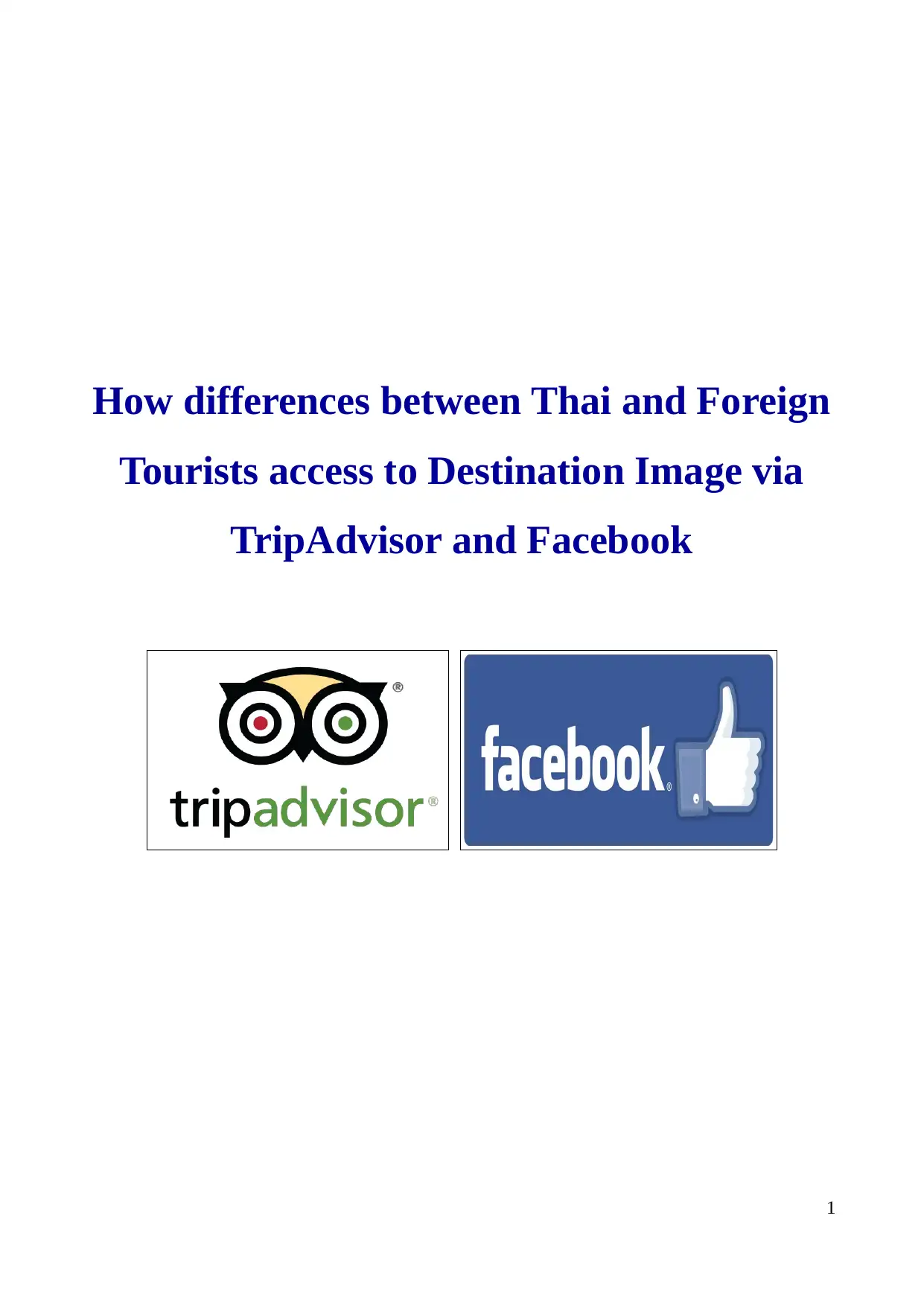
How differences between Thai and Foreign
Tourists access to Destination Image via
TripAdvisor and Facebook
1
Tourists access to Destination Image via
TripAdvisor and Facebook
1
Secure Best Marks with AI Grader
Need help grading? Try our AI Grader for instant feedback on your assignments.
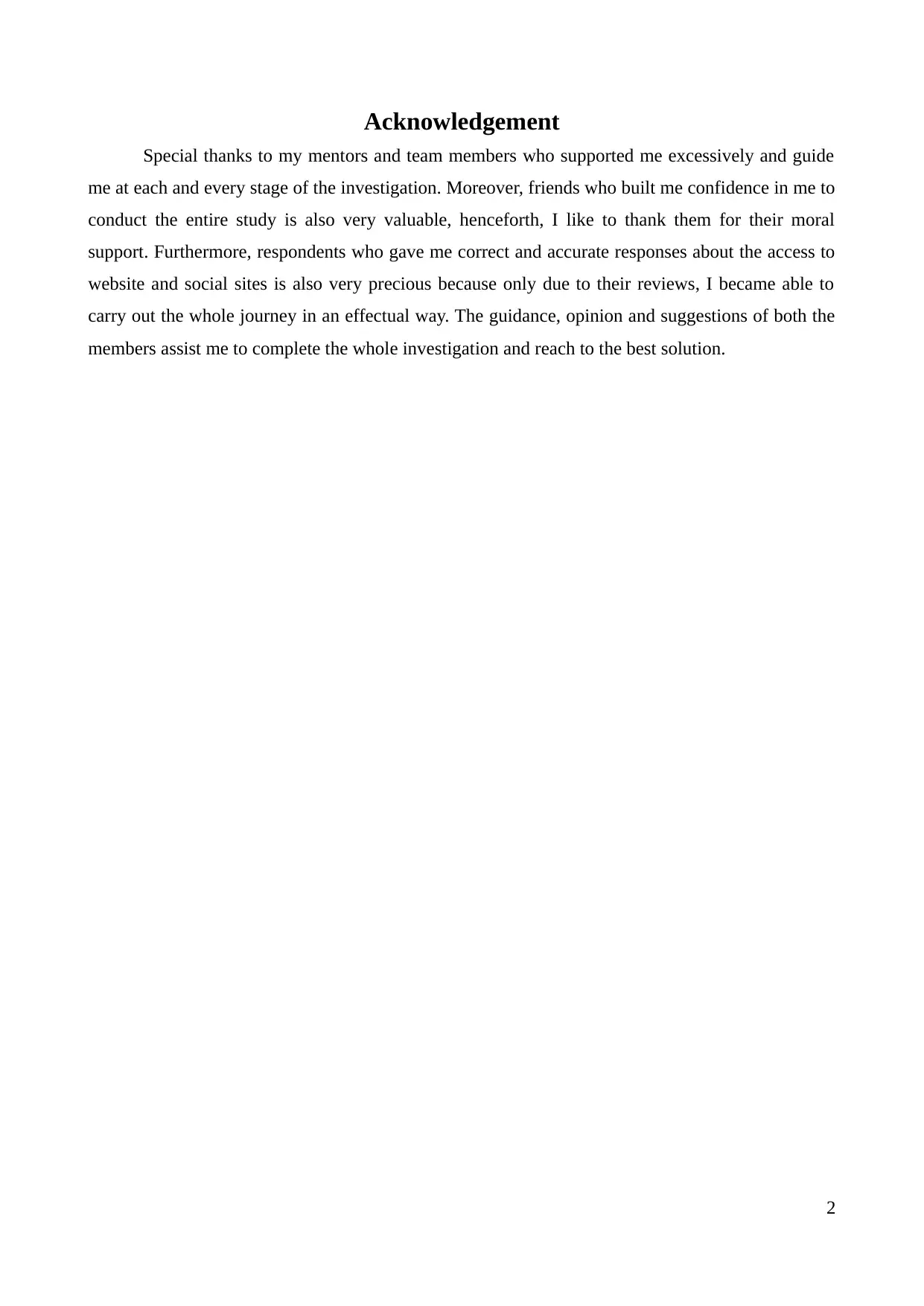
Acknowledgement
Special thanks to my mentors and team members who supported me excessively and guide
me at each and every stage of the investigation. Moreover, friends who built me confidence in me to
conduct the entire study is also very valuable, henceforth, I like to thank them for their moral
support. Furthermore, respondents who gave me correct and accurate responses about the access to
website and social sites is also very precious because only due to their reviews, I became able to
carry out the whole journey in an effectual way. The guidance, opinion and suggestions of both the
members assist me to complete the whole investigation and reach to the best solution.
2
Special thanks to my mentors and team members who supported me excessively and guide
me at each and every stage of the investigation. Moreover, friends who built me confidence in me to
conduct the entire study is also very valuable, henceforth, I like to thank them for their moral
support. Furthermore, respondents who gave me correct and accurate responses about the access to
website and social sites is also very precious because only due to their reviews, I became able to
carry out the whole journey in an effectual way. The guidance, opinion and suggestions of both the
members assist me to complete the whole investigation and reach to the best solution.
2
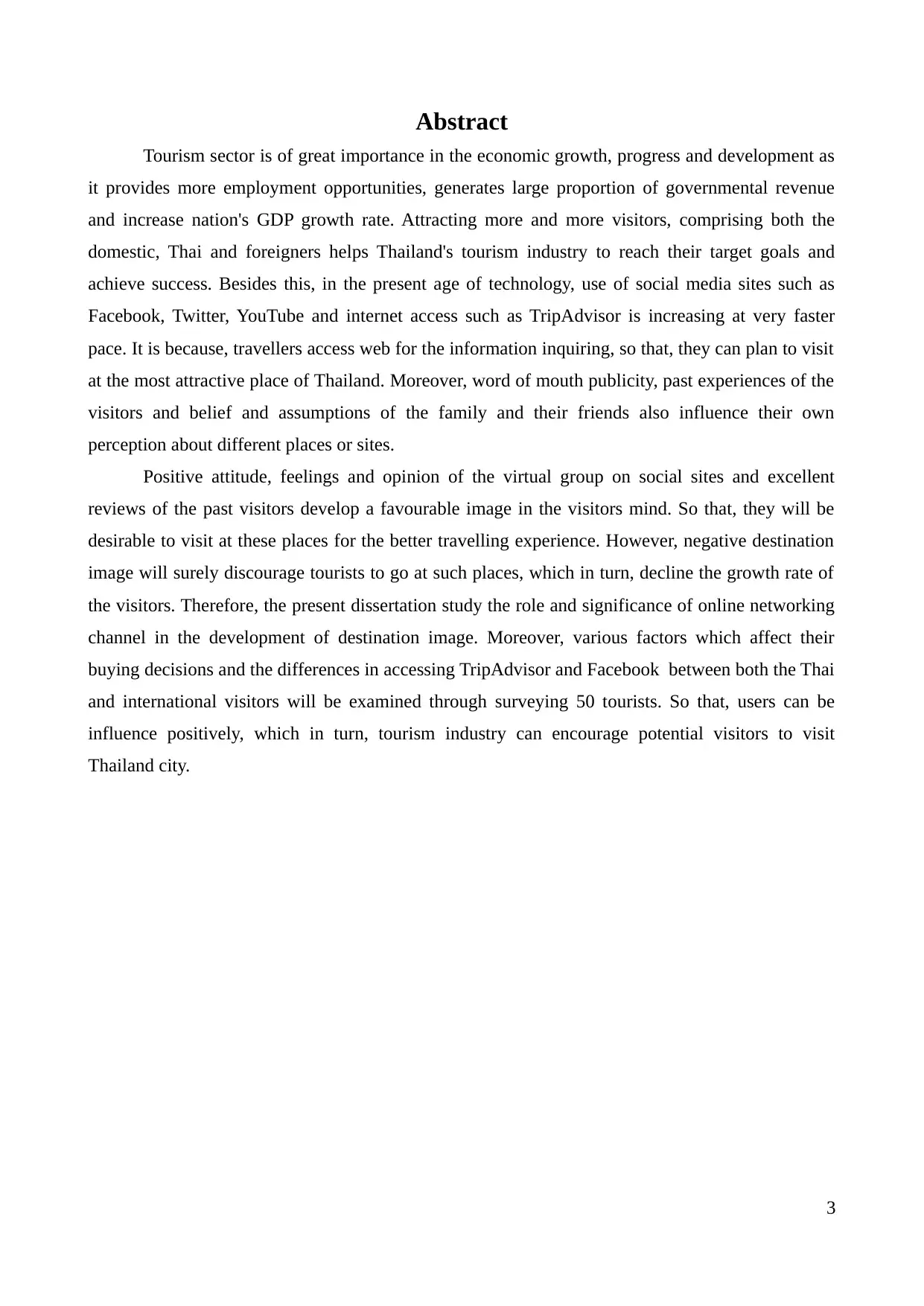
Abstract
Tourism sector is of great importance in the economic growth, progress and development as
it provides more employment opportunities, generates large proportion of governmental revenue
and increase nation's GDP growth rate. Attracting more and more visitors, comprising both the
domestic, Thai and foreigners helps Thailand's tourism industry to reach their target goals and
achieve success. Besides this, in the present age of technology, use of social media sites such as
Facebook, Twitter, YouTube and internet access such as TripAdvisor is increasing at very faster
pace. It is because, travellers access web for the information inquiring, so that, they can plan to visit
at the most attractive place of Thailand. Moreover, word of mouth publicity, past experiences of the
visitors and belief and assumptions of the family and their friends also influence their own
perception about different places or sites.
Positive attitude, feelings and opinion of the virtual group on social sites and excellent
reviews of the past visitors develop a favourable image in the visitors mind. So that, they will be
desirable to visit at these places for the better travelling experience. However, negative destination
image will surely discourage tourists to go at such places, which in turn, decline the growth rate of
the visitors. Therefore, the present dissertation study the role and significance of online networking
channel in the development of destination image. Moreover, various factors which affect their
buying decisions and the differences in accessing TripAdvisor and Facebook between both the Thai
and international visitors will be examined through surveying 50 tourists. So that, users can be
influence positively, which in turn, tourism industry can encourage potential visitors to visit
Thailand city.
3
Tourism sector is of great importance in the economic growth, progress and development as
it provides more employment opportunities, generates large proportion of governmental revenue
and increase nation's GDP growth rate. Attracting more and more visitors, comprising both the
domestic, Thai and foreigners helps Thailand's tourism industry to reach their target goals and
achieve success. Besides this, in the present age of technology, use of social media sites such as
Facebook, Twitter, YouTube and internet access such as TripAdvisor is increasing at very faster
pace. It is because, travellers access web for the information inquiring, so that, they can plan to visit
at the most attractive place of Thailand. Moreover, word of mouth publicity, past experiences of the
visitors and belief and assumptions of the family and their friends also influence their own
perception about different places or sites.
Positive attitude, feelings and opinion of the virtual group on social sites and excellent
reviews of the past visitors develop a favourable image in the visitors mind. So that, they will be
desirable to visit at these places for the better travelling experience. However, negative destination
image will surely discourage tourists to go at such places, which in turn, decline the growth rate of
the visitors. Therefore, the present dissertation study the role and significance of online networking
channel in the development of destination image. Moreover, various factors which affect their
buying decisions and the differences in accessing TripAdvisor and Facebook between both the Thai
and international visitors will be examined through surveying 50 tourists. So that, users can be
influence positively, which in turn, tourism industry can encourage potential visitors to visit
Thailand city.
3

Table of Contents
CHAPTER - 1 INTRODUCTION.......................................................................................................5
1.1 Background of the research.......................................................................................................5
1.2 Rationale of the study................................................................................................................6
1.3 Potential significance of the research........................................................................................6
1.4 Research aims and objectives....................................................................................................6
1.5 Research questions.....................................................................................................................7
1.6 Structure of the study ................................................................................................................7
CHAPTER – 2 Literature review.........................................................................................................9
2.1 Sharing practices in tourism social media...............................................................................13
2.2 Real-time sharing.....................................................................................................................14
2.3 Social media types...................................................................................................................14
2.4 Textual versus visual content...................................................................................................15
2.5 Impacts on tourism culture and knowledge.............................................................................15
2.6 Tourism and Mediatiazation....................................................................................................16
CHAPTER – 3 RESEARCH METHODOLOGY..............................................................................18
3.1 Introduction..............................................................................................................................18
3.2 Research philosophy................................................................................................................18
3.3 Research approach...................................................................................................................19
3.4 Research design.......................................................................................................................19
3.5 Research type...........................................................................................................................20
3.6 Data collection methods...........................................................................................................20
3.7 Research instrument.................................................................................................................21
3.8 Sampling..................................................................................................................................21
3.9 Data analysis............................................................................................................................21
3.10 Ethical considerations............................................................................................................21
3.11 Limitation of the study...........................................................................................................22
3.12 Time Frame............................................................................................................................22
CHAPTER – 4 DATA FINDINGS AND ANALYSIS .......................................................................24
4.1 Introduction..............................................................................................................................24
4.2 Data findings and analysis.......................................................................................................24
CHAPTER – 5 CONCLUSION AND RECOMMENDATION.........................................................40
5.1 Conclusion...............................................................................................................................40
5.2 Recommendations....................................................................................................................41
REFERENCES...................................................................................................................................42
APPENDIX........................................................................................................................................46
Survey Questionnaire.....................................................................................................................47
4
CHAPTER - 1 INTRODUCTION.......................................................................................................5
1.1 Background of the research.......................................................................................................5
1.2 Rationale of the study................................................................................................................6
1.3 Potential significance of the research........................................................................................6
1.4 Research aims and objectives....................................................................................................6
1.5 Research questions.....................................................................................................................7
1.6 Structure of the study ................................................................................................................7
CHAPTER – 2 Literature review.........................................................................................................9
2.1 Sharing practices in tourism social media...............................................................................13
2.2 Real-time sharing.....................................................................................................................14
2.3 Social media types...................................................................................................................14
2.4 Textual versus visual content...................................................................................................15
2.5 Impacts on tourism culture and knowledge.............................................................................15
2.6 Tourism and Mediatiazation....................................................................................................16
CHAPTER – 3 RESEARCH METHODOLOGY..............................................................................18
3.1 Introduction..............................................................................................................................18
3.2 Research philosophy................................................................................................................18
3.3 Research approach...................................................................................................................19
3.4 Research design.......................................................................................................................19
3.5 Research type...........................................................................................................................20
3.6 Data collection methods...........................................................................................................20
3.7 Research instrument.................................................................................................................21
3.8 Sampling..................................................................................................................................21
3.9 Data analysis............................................................................................................................21
3.10 Ethical considerations............................................................................................................21
3.11 Limitation of the study...........................................................................................................22
3.12 Time Frame............................................................................................................................22
CHAPTER – 4 DATA FINDINGS AND ANALYSIS .......................................................................24
4.1 Introduction..............................................................................................................................24
4.2 Data findings and analysis.......................................................................................................24
CHAPTER – 5 CONCLUSION AND RECOMMENDATION.........................................................40
5.1 Conclusion...............................................................................................................................40
5.2 Recommendations....................................................................................................................41
REFERENCES...................................................................................................................................42
APPENDIX........................................................................................................................................46
Survey Questionnaire.....................................................................................................................47
4
Secure Best Marks with AI Grader
Need help grading? Try our AI Grader for instant feedback on your assignments.
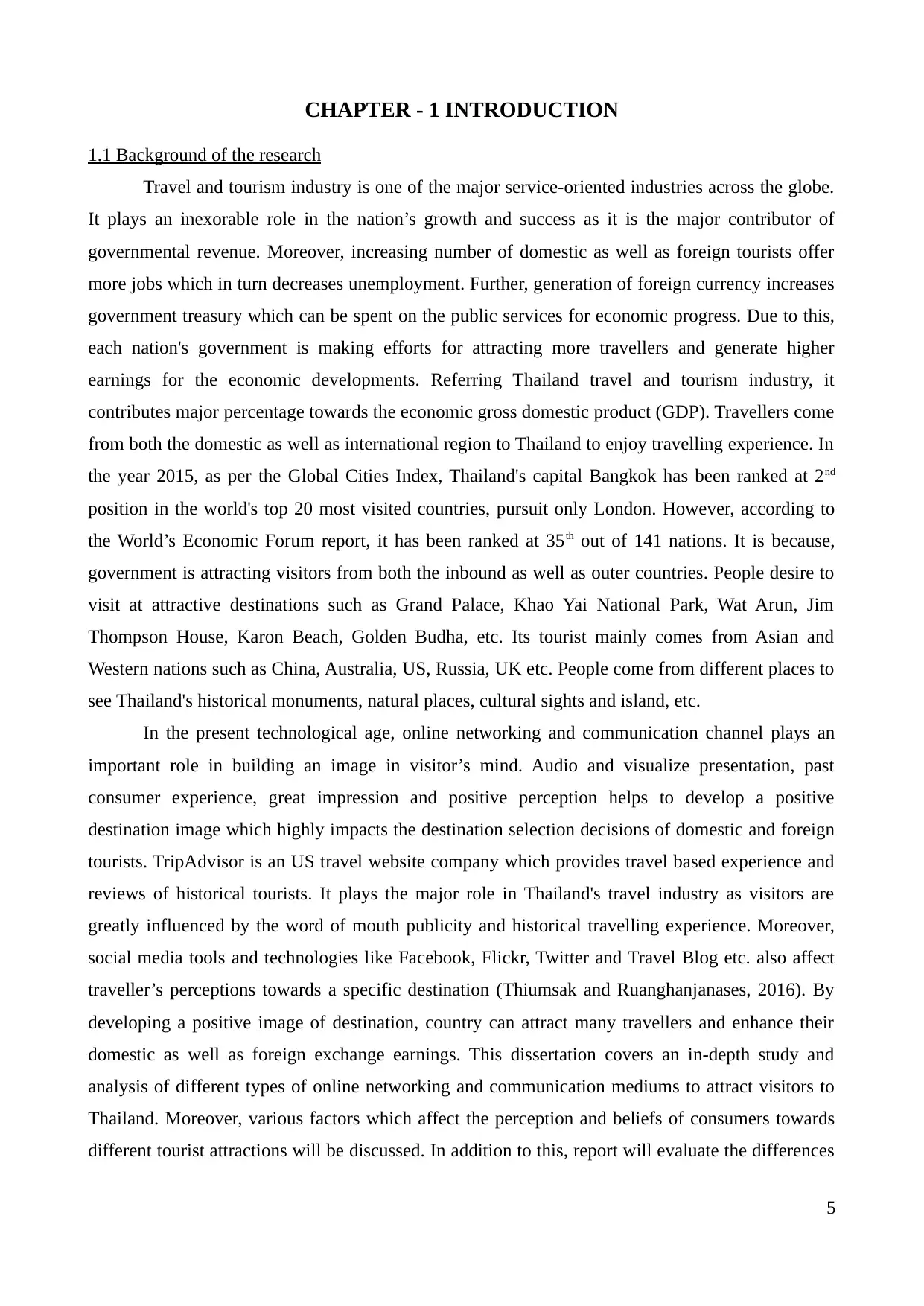
CHAPTER - 1 INTRODUCTION
1.1 Background of the research
Travel and tourism industry is one of the major service-oriented industries across the globe.
It plays an inexorable role in the nation’s growth and success as it is the major contributor of
governmental revenue. Moreover, increasing number of domestic as well as foreign tourists offer
more jobs which in turn decreases unemployment. Further, generation of foreign currency increases
government treasury which can be spent on the public services for economic progress. Due to this,
each nation's government is making efforts for attracting more travellers and generate higher
earnings for the economic developments. Referring Thailand travel and tourism industry, it
contributes major percentage towards the economic gross domestic product (GDP). Travellers come
from both the domestic as well as international region to Thailand to enjoy travelling experience. In
the year 2015, as per the Global Cities Index, Thailand's capital Bangkok has been ranked at 2nd
position in the world's top 20 most visited countries, pursuit only London. However, according to
the World’s Economic Forum report, it has been ranked at 35th out of 141 nations. It is because,
government is attracting visitors from both the inbound as well as outer countries. People desire to
visit at attractive destinations such as Grand Palace, Khao Yai National Park, Wat Arun, Jim
Thompson House, Karon Beach, Golden Budha, etc. Its tourist mainly comes from Asian and
Western nations such as China, Australia, US, Russia, UK etc. People come from different places to
see Thailand's historical monuments, natural places, cultural sights and island, etc.
In the present technological age, online networking and communication channel plays an
important role in building an image in visitor’s mind. Audio and visualize presentation, past
consumer experience, great impression and positive perception helps to develop a positive
destination image which highly impacts the destination selection decisions of domestic and foreign
tourists. TripAdvisor is an US travel website company which provides travel based experience and
reviews of historical tourists. It plays the major role in Thailand's travel industry as visitors are
greatly influenced by the word of mouth publicity and historical travelling experience. Moreover,
social media tools and technologies like Facebook, Flickr, Twitter and Travel Blog etc. also affect
traveller’s perceptions towards a specific destination (Thiumsak and Ruanghanjanases, 2016). By
developing a positive image of destination, country can attract many travellers and enhance their
domestic as well as foreign exchange earnings. This dissertation covers an in-depth study and
analysis of different types of online networking and communication mediums to attract visitors to
Thailand. Moreover, various factors which affect the perception and beliefs of consumers towards
different tourist attractions will be discussed. In addition to this, report will evaluate the differences
5
1.1 Background of the research
Travel and tourism industry is one of the major service-oriented industries across the globe.
It plays an inexorable role in the nation’s growth and success as it is the major contributor of
governmental revenue. Moreover, increasing number of domestic as well as foreign tourists offer
more jobs which in turn decreases unemployment. Further, generation of foreign currency increases
government treasury which can be spent on the public services for economic progress. Due to this,
each nation's government is making efforts for attracting more travellers and generate higher
earnings for the economic developments. Referring Thailand travel and tourism industry, it
contributes major percentage towards the economic gross domestic product (GDP). Travellers come
from both the domestic as well as international region to Thailand to enjoy travelling experience. In
the year 2015, as per the Global Cities Index, Thailand's capital Bangkok has been ranked at 2nd
position in the world's top 20 most visited countries, pursuit only London. However, according to
the World’s Economic Forum report, it has been ranked at 35th out of 141 nations. It is because,
government is attracting visitors from both the inbound as well as outer countries. People desire to
visit at attractive destinations such as Grand Palace, Khao Yai National Park, Wat Arun, Jim
Thompson House, Karon Beach, Golden Budha, etc. Its tourist mainly comes from Asian and
Western nations such as China, Australia, US, Russia, UK etc. People come from different places to
see Thailand's historical monuments, natural places, cultural sights and island, etc.
In the present technological age, online networking and communication channel plays an
important role in building an image in visitor’s mind. Audio and visualize presentation, past
consumer experience, great impression and positive perception helps to develop a positive
destination image which highly impacts the destination selection decisions of domestic and foreign
tourists. TripAdvisor is an US travel website company which provides travel based experience and
reviews of historical tourists. It plays the major role in Thailand's travel industry as visitors are
greatly influenced by the word of mouth publicity and historical travelling experience. Moreover,
social media tools and technologies like Facebook, Flickr, Twitter and Travel Blog etc. also affect
traveller’s perceptions towards a specific destination (Thiumsak and Ruanghanjanases, 2016). By
developing a positive image of destination, country can attract many travellers and enhance their
domestic as well as foreign exchange earnings. This dissertation covers an in-depth study and
analysis of different types of online networking and communication mediums to attract visitors to
Thailand. Moreover, various factors which affect the perception and beliefs of consumers towards
different tourist attractions will be discussed. In addition to this, report will evaluate the differences
5
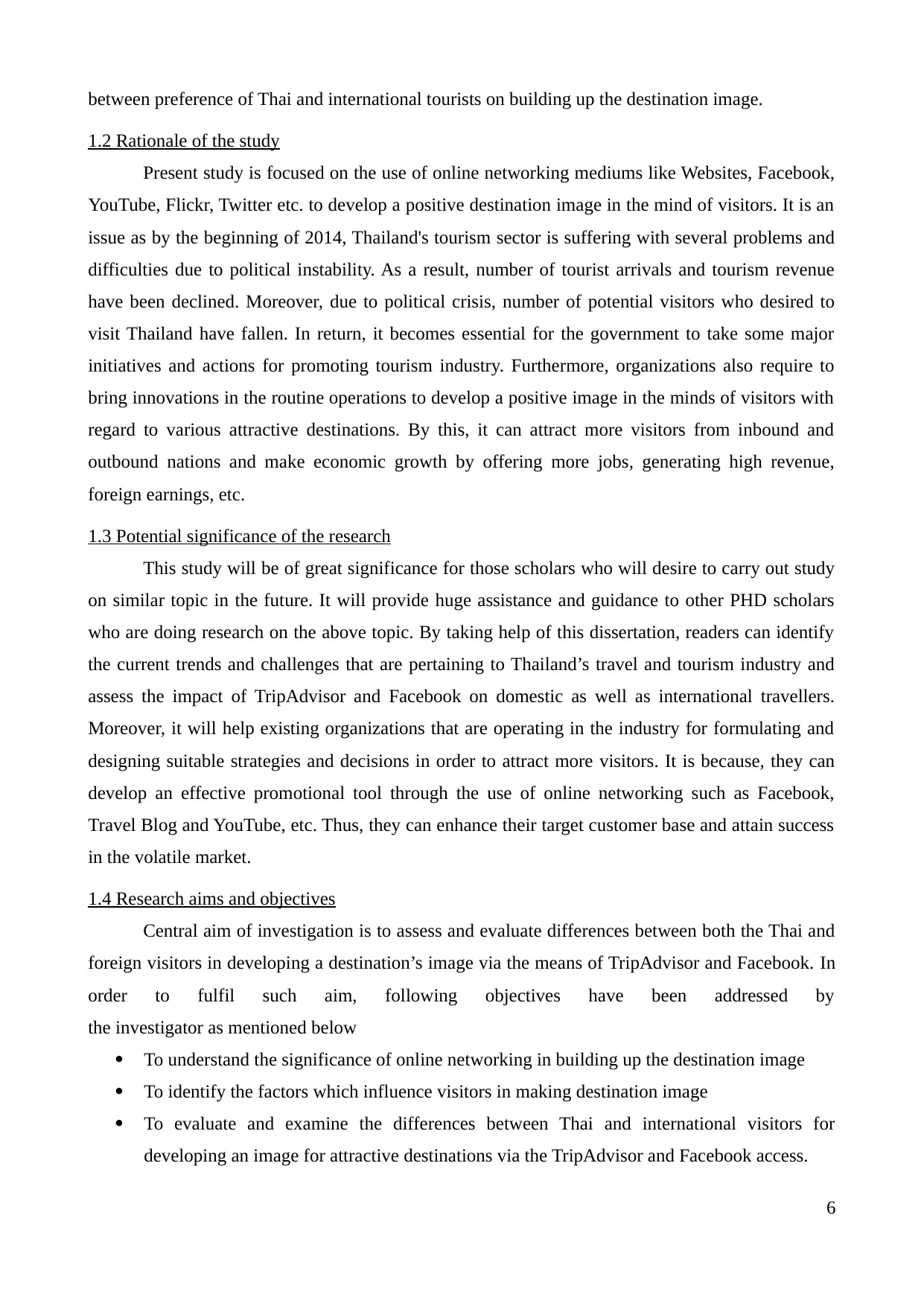
between preference of Thai and international tourists on building up the destination image.
1.2 Rationale of the study
Present study is focused on the use of online networking mediums like Websites, Facebook,
YouTube, Flickr, Twitter etc. to develop a positive destination image in the mind of visitors. It is an
issue as by the beginning of 2014, Thailand's tourism sector is suffering with several problems and
difficulties due to political instability. As a result, number of tourist arrivals and tourism revenue
have been declined. Moreover, due to political crisis, number of potential visitors who desired to
visit Thailand have fallen. In return, it becomes essential for the government to take some major
initiatives and actions for promoting tourism industry. Furthermore, organizations also require to
bring innovations in the routine operations to develop a positive image in the minds of visitors with
regard to various attractive destinations. By this, it can attract more visitors from inbound and
outbound nations and make economic growth by offering more jobs, generating high revenue,
foreign earnings, etc.
1.3 Potential significance of the research
This study will be of great significance for those scholars who will desire to carry out study
on similar topic in the future. It will provide huge assistance and guidance to other PHD scholars
who are doing research on the above topic. By taking help of this dissertation, readers can identify
the current trends and challenges that are pertaining to Thailand’s travel and tourism industry and
assess the impact of TripAdvisor and Facebook on domestic as well as international travellers.
Moreover, it will help existing organizations that are operating in the industry for formulating and
designing suitable strategies and decisions in order to attract more visitors. It is because, they can
develop an effective promotional tool through the use of online networking such as Facebook,
Travel Blog and YouTube, etc. Thus, they can enhance their target customer base and attain success
in the volatile market.
1.4 Research aims and objectives
Central aim of investigation is to assess and evaluate differences between both the Thai and
foreign visitors in developing a destination’s image via the means of TripAdvisor and Facebook. In
order to fulfil such aim, following objectives have been addressed by
the investigator as mentioned below
To understand the significance of online networking in building up the destination image
To identify the factors which influence visitors in making destination image
To evaluate and examine the differences between Thai and international visitors for
developing an image for attractive destinations via the TripAdvisor and Facebook access.
6
1.2 Rationale of the study
Present study is focused on the use of online networking mediums like Websites, Facebook,
YouTube, Flickr, Twitter etc. to develop a positive destination image in the mind of visitors. It is an
issue as by the beginning of 2014, Thailand's tourism sector is suffering with several problems and
difficulties due to political instability. As a result, number of tourist arrivals and tourism revenue
have been declined. Moreover, due to political crisis, number of potential visitors who desired to
visit Thailand have fallen. In return, it becomes essential for the government to take some major
initiatives and actions for promoting tourism industry. Furthermore, organizations also require to
bring innovations in the routine operations to develop a positive image in the minds of visitors with
regard to various attractive destinations. By this, it can attract more visitors from inbound and
outbound nations and make economic growth by offering more jobs, generating high revenue,
foreign earnings, etc.
1.3 Potential significance of the research
This study will be of great significance for those scholars who will desire to carry out study
on similar topic in the future. It will provide huge assistance and guidance to other PHD scholars
who are doing research on the above topic. By taking help of this dissertation, readers can identify
the current trends and challenges that are pertaining to Thailand’s travel and tourism industry and
assess the impact of TripAdvisor and Facebook on domestic as well as international travellers.
Moreover, it will help existing organizations that are operating in the industry for formulating and
designing suitable strategies and decisions in order to attract more visitors. It is because, they can
develop an effective promotional tool through the use of online networking such as Facebook,
Travel Blog and YouTube, etc. Thus, they can enhance their target customer base and attain success
in the volatile market.
1.4 Research aims and objectives
Central aim of investigation is to assess and evaluate differences between both the Thai and
foreign visitors in developing a destination’s image via the means of TripAdvisor and Facebook. In
order to fulfil such aim, following objectives have been addressed by
the investigator as mentioned below
To understand the significance of online networking in building up the destination image
To identify the factors which influence visitors in making destination image
To evaluate and examine the differences between Thai and international visitors for
developing an image for attractive destinations via the TripAdvisor and Facebook access.
6
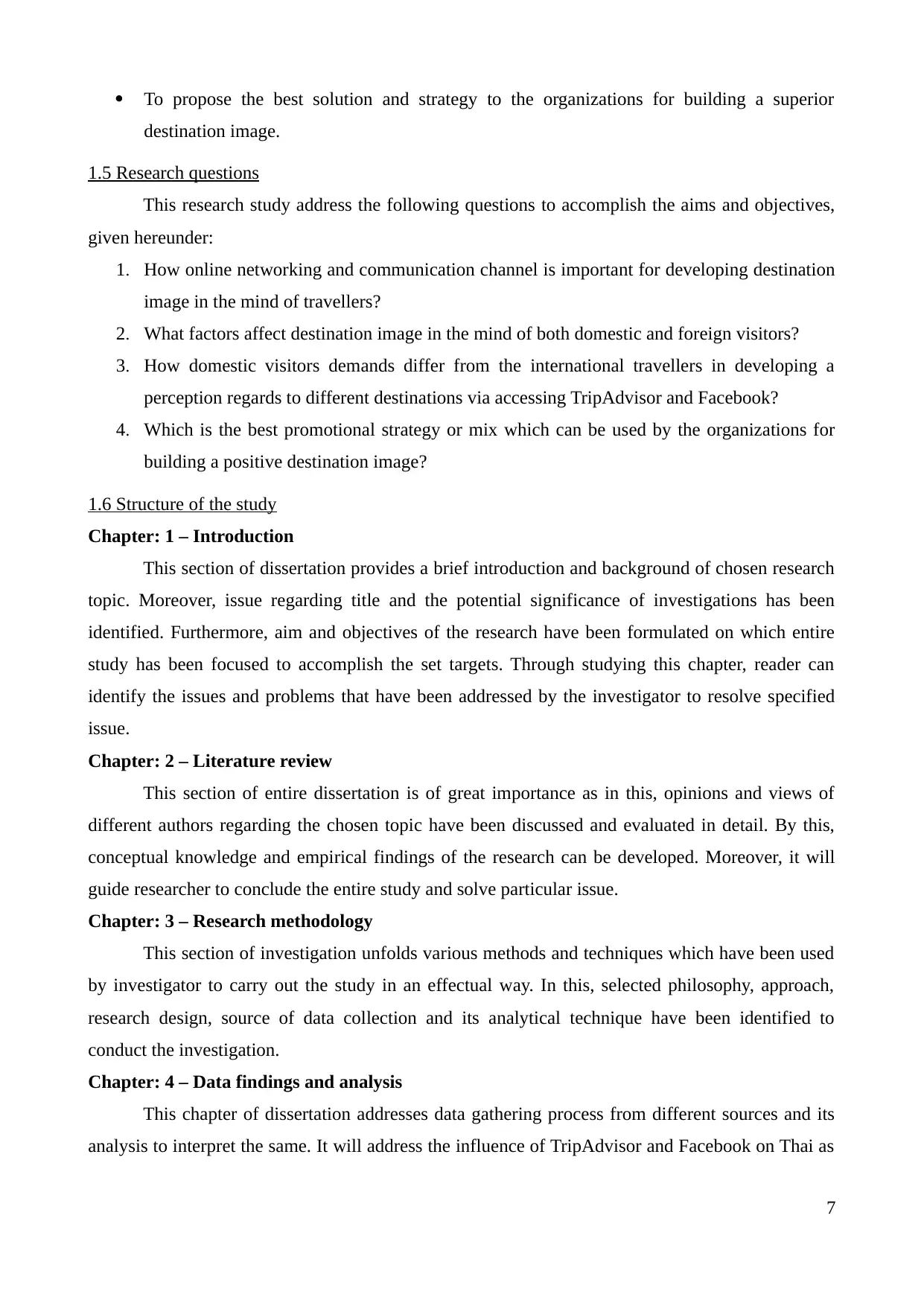
To propose the best solution and strategy to the organizations for building a superior
destination image.
1.5 Research questions
This research study address the following questions to accomplish the aims and objectives,
given hereunder:
1. How online networking and communication channel is important for developing destination
image in the mind of travellers?
2. What factors affect destination image in the mind of both domestic and foreign visitors?
3. How domestic visitors demands differ from the international travellers in developing a
perception regards to different destinations via accessing TripAdvisor and Facebook?
4. Which is the best promotional strategy or mix which can be used by the organizations for
building a positive destination image?
1.6 Structure of the study
Chapter: 1 – Introduction
This section of dissertation provides a brief introduction and background of chosen research
topic. Moreover, issue regarding title and the potential significance of investigations has been
identified. Furthermore, aim and objectives of the research have been formulated on which entire
study has been focused to accomplish the set targets. Through studying this chapter, reader can
identify the issues and problems that have been addressed by the investigator to resolve specified
issue.
Chapter: 2 – Literature review
This section of entire dissertation is of great importance as in this, opinions and views of
different authors regarding the chosen topic have been discussed and evaluated in detail. By this,
conceptual knowledge and empirical findings of the research can be developed. Moreover, it will
guide researcher to conclude the entire study and solve particular issue.
Chapter: 3 – Research methodology
This section of investigation unfolds various methods and techniques which have been used
by investigator to carry out the study in an effectual way. In this, selected philosophy, approach,
research design, source of data collection and its analytical technique have been identified to
conduct the investigation.
Chapter: 4 – Data findings and analysis
This chapter of dissertation addresses data gathering process from different sources and its
analysis to interpret the same. It will address the influence of TripAdvisor and Facebook on Thai as
7
destination image.
1.5 Research questions
This research study address the following questions to accomplish the aims and objectives,
given hereunder:
1. How online networking and communication channel is important for developing destination
image in the mind of travellers?
2. What factors affect destination image in the mind of both domestic and foreign visitors?
3. How domestic visitors demands differ from the international travellers in developing a
perception regards to different destinations via accessing TripAdvisor and Facebook?
4. Which is the best promotional strategy or mix which can be used by the organizations for
building a positive destination image?
1.6 Structure of the study
Chapter: 1 – Introduction
This section of dissertation provides a brief introduction and background of chosen research
topic. Moreover, issue regarding title and the potential significance of investigations has been
identified. Furthermore, aim and objectives of the research have been formulated on which entire
study has been focused to accomplish the set targets. Through studying this chapter, reader can
identify the issues and problems that have been addressed by the investigator to resolve specified
issue.
Chapter: 2 – Literature review
This section of entire dissertation is of great importance as in this, opinions and views of
different authors regarding the chosen topic have been discussed and evaluated in detail. By this,
conceptual knowledge and empirical findings of the research can be developed. Moreover, it will
guide researcher to conclude the entire study and solve particular issue.
Chapter: 3 – Research methodology
This section of investigation unfolds various methods and techniques which have been used
by investigator to carry out the study in an effectual way. In this, selected philosophy, approach,
research design, source of data collection and its analytical technique have been identified to
conduct the investigation.
Chapter: 4 – Data findings and analysis
This chapter of dissertation addresses data gathering process from different sources and its
analysis to interpret the same. It will address the influence of TripAdvisor and Facebook on Thai as
7
Paraphrase This Document
Need a fresh take? Get an instant paraphrase of this document with our AI Paraphraser
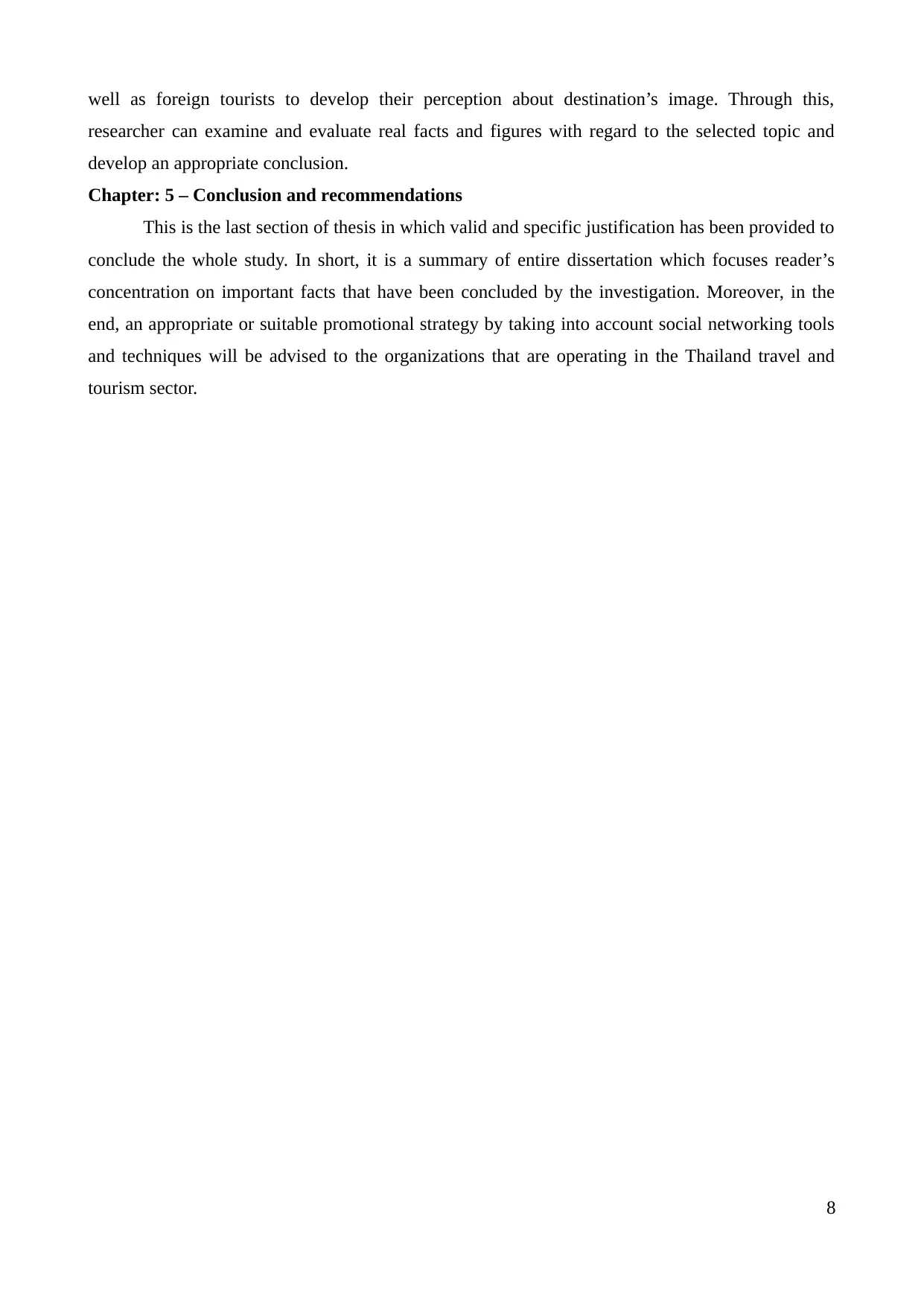
well as foreign tourists to develop their perception about destination’s image. Through this,
researcher can examine and evaluate real facts and figures with regard to the selected topic and
develop an appropriate conclusion.
Chapter: 5 – Conclusion and recommendations
This is the last section of thesis in which valid and specific justification has been provided to
conclude the whole study. In short, it is a summary of entire dissertation which focuses reader’s
concentration on important facts that have been concluded by the investigation. Moreover, in the
end, an appropriate or suitable promotional strategy by taking into account social networking tools
and techniques will be advised to the organizations that are operating in the Thailand travel and
tourism sector.
8
researcher can examine and evaluate real facts and figures with regard to the selected topic and
develop an appropriate conclusion.
Chapter: 5 – Conclusion and recommendations
This is the last section of thesis in which valid and specific justification has been provided to
conclude the whole study. In short, it is a summary of entire dissertation which focuses reader’s
concentration on important facts that have been concluded by the investigation. Moreover, in the
end, an appropriate or suitable promotional strategy by taking into account social networking tools
and techniques will be advised to the organizations that are operating in the Thailand travel and
tourism sector.
8
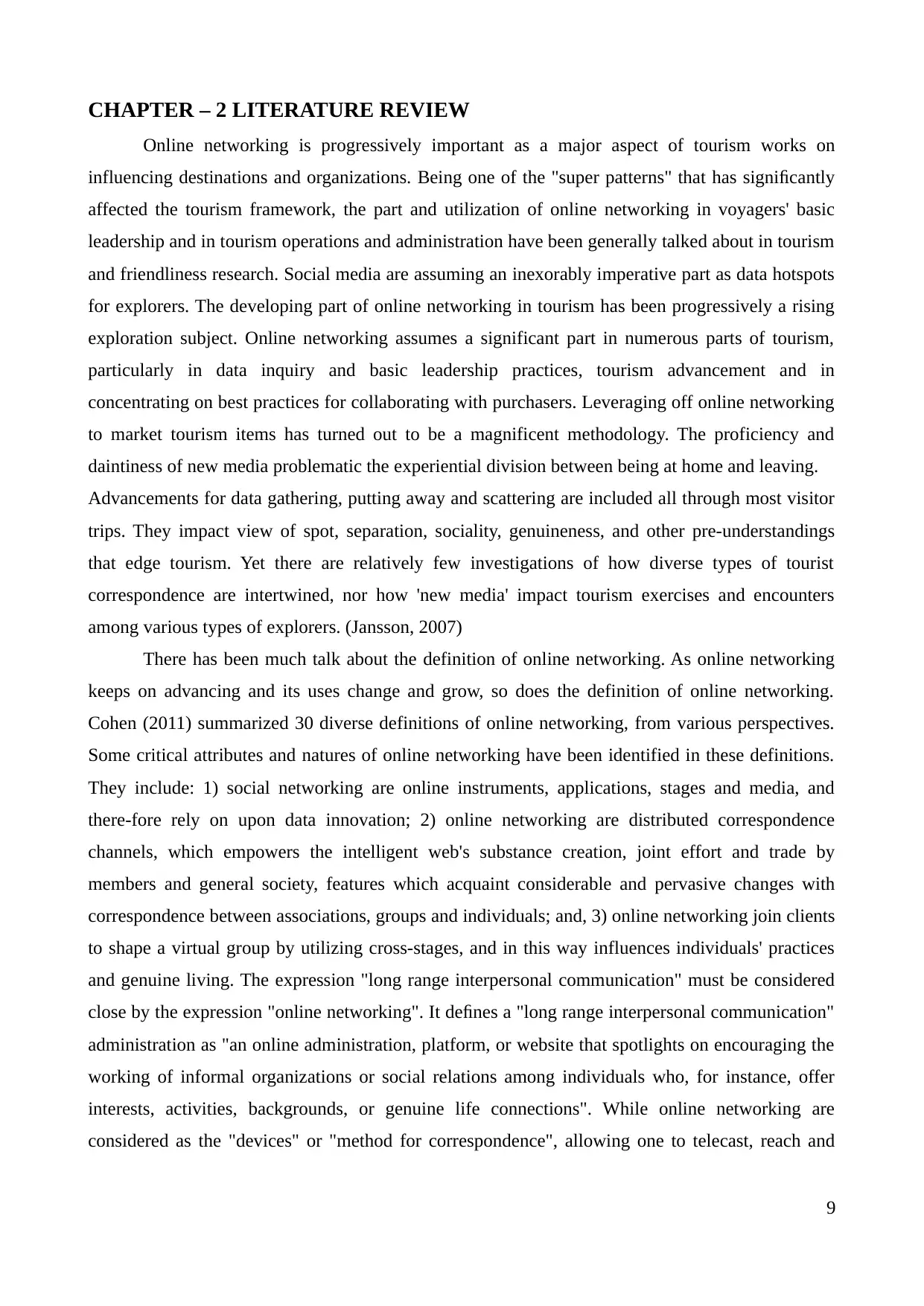
CHAPTER – 2 LITERATURE REVIEW
Online networking is progressively important as a major aspect of tourism works on
influencing destinations and organizations. Being one of the "super patterns" that has significantly
affected the tourism framework, the part and utilization of online networking in voyagers' basic
leadership and in tourism operations and administration have been generally talked about in tourism
and friendliness research. Social media are assuming an inexorably imperative part as data hotspots
for explorers. The developing part of online networking in tourism has been progressively a rising
exploration subject. Online networking assumes a significant part in numerous parts of tourism,
particularly in data inquiry and basic leadership practices, tourism advancement and in
concentrating on best practices for collaborating with purchasers. Leveraging off online networking
to market tourism items has turned out to be a magnificent methodology. The proficiency and
daintiness of new media problematic the experiential division between being at home and leaving.
Advancements for data gathering, putting away and scattering are included all through most visitor
trips. They impact view of spot, separation, sociality, genuineness, and other pre-understandings
that edge tourism. Yet there are relatively few investigations of how diverse types of tourist
correspondence are intertwined, nor how 'new media' impact tourism exercises and encounters
among various types of explorers. (Jansson, 2007)
There has been much talk about the definition of online networking. As online networking
keeps on advancing and its uses change and grow, so does the definition of online networking.
Cohen (2011) summarized 30 diverse definitions of online networking, from various perspectives.
Some critical attributes and natures of online networking have been identified in these definitions.
They include: 1) social networking are online instruments, applications, stages and media, and
there-fore rely on upon data innovation; 2) online networking are distributed correspondence
channels, which empowers the intelligent web's substance creation, joint effort and trade by
members and general society, features which acquaint considerable and pervasive changes with
correspondence between associations, groups and individuals; and, 3) online networking join clients
to shape a virtual group by utilizing cross-stages, and in this way influences individuals' practices
and genuine living. The expression "long range interpersonal communication" must be considered
close by the expression "online networking". It defines a "long range interpersonal communication"
administration as "an online administration, platform, or website that spotlights on encouraging the
working of informal organizations or social relations among individuals who, for instance, offer
interests, activities, backgrounds, or genuine life connections". While online networking are
considered as the "devices" or "method for correspondence", allowing one to telecast, reach and
9
Online networking is progressively important as a major aspect of tourism works on
influencing destinations and organizations. Being one of the "super patterns" that has significantly
affected the tourism framework, the part and utilization of online networking in voyagers' basic
leadership and in tourism operations and administration have been generally talked about in tourism
and friendliness research. Social media are assuming an inexorably imperative part as data hotspots
for explorers. The developing part of online networking in tourism has been progressively a rising
exploration subject. Online networking assumes a significant part in numerous parts of tourism,
particularly in data inquiry and basic leadership practices, tourism advancement and in
concentrating on best practices for collaborating with purchasers. Leveraging off online networking
to market tourism items has turned out to be a magnificent methodology. The proficiency and
daintiness of new media problematic the experiential division between being at home and leaving.
Advancements for data gathering, putting away and scattering are included all through most visitor
trips. They impact view of spot, separation, sociality, genuineness, and other pre-understandings
that edge tourism. Yet there are relatively few investigations of how diverse types of tourist
correspondence are intertwined, nor how 'new media' impact tourism exercises and encounters
among various types of explorers. (Jansson, 2007)
There has been much talk about the definition of online networking. As online networking
keeps on advancing and its uses change and grow, so does the definition of online networking.
Cohen (2011) summarized 30 diverse definitions of online networking, from various perspectives.
Some critical attributes and natures of online networking have been identified in these definitions.
They include: 1) social networking are online instruments, applications, stages and media, and
there-fore rely on upon data innovation; 2) online networking are distributed correspondence
channels, which empowers the intelligent web's substance creation, joint effort and trade by
members and general society, features which acquaint considerable and pervasive changes with
correspondence between associations, groups and individuals; and, 3) online networking join clients
to shape a virtual group by utilizing cross-stages, and in this way influences individuals' practices
and genuine living. The expression "long range interpersonal communication" must be considered
close by the expression "online networking". It defines a "long range interpersonal communication"
administration as "an online administration, platform, or website that spotlights on encouraging the
working of informal organizations or social relations among individuals who, for instance, offer
interests, activities, backgrounds, or genuine life connections". While online networking are
considered as the "devices" or "method for correspondence", allowing one to telecast, reach and
9
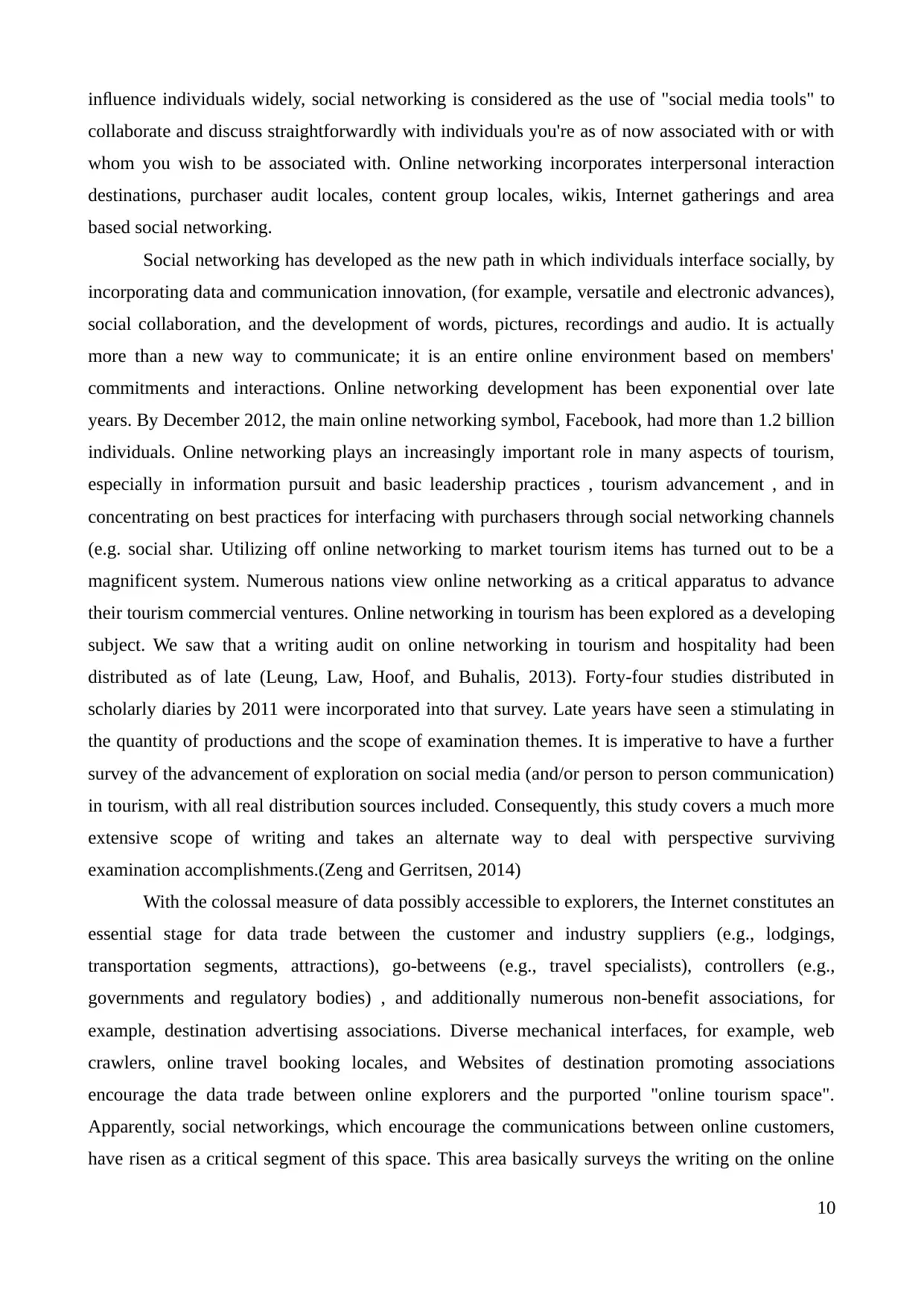
influence individuals widely, social networking is considered as the use of "social media tools" to
collaborate and discuss straightforwardly with individuals you're as of now associated with or with
whom you wish to be associated with. Online networking incorporates interpersonal interaction
destinations, purchaser audit locales, content group locales, wikis, Internet gatherings and area
based social networking.
Social networking has developed as the new path in which individuals interface socially, by
incorporating data and communication innovation, (for example, versatile and electronic advances),
social collaboration, and the development of words, pictures, recordings and audio. It is actually
more than a new way to communicate; it is an entire online environment based on members'
commitments and interactions. Online networking development has been exponential over late
years. By December 2012, the main online networking symbol, Facebook, had more than 1.2 billion
individuals. Online networking plays an increasingly important role in many aspects of tourism,
especially in information pursuit and basic leadership practices , tourism advancement , and in
concentrating on best practices for interfacing with purchasers through social networking channels
(e.g. social shar. Utilizing off online networking to market tourism items has turned out to be a
magnificent system. Numerous nations view online networking as a critical apparatus to advance
their tourism commercial ventures. Online networking in tourism has been explored as a developing
subject. We saw that a writing audit on online networking in tourism and hospitality had been
distributed as of late (Leung, Law, Hoof, and Buhalis, 2013). Forty-four studies distributed in
scholarly diaries by 2011 were incorporated into that survey. Late years have seen a stimulating in
the quantity of productions and the scope of examination themes. It is imperative to have a further
survey of the advancement of exploration on social media (and/or person to person communication)
in tourism, with all real distribution sources included. Consequently, this study covers a much more
extensive scope of writing and takes an alternate way to deal with perspective surviving
examination accomplishments.(Zeng and Gerritsen, 2014)
With the colossal measure of data possibly accessible to explorers, the Internet constitutes an
essential stage for data trade between the customer and industry suppliers (e.g., lodgings,
transportation segments, attractions), go-betweens (e.g., travel specialists), controllers (e.g.,
governments and regulatory bodies) , and additionally numerous non-benefit associations, for
example, destination advertising associations. Diverse mechanical interfaces, for example, web
crawlers, online travel booking locales, and Websites of destination promoting associations
encourage the data trade between online explorers and the purported "online tourism space".
Apparently, social networkings, which encourage the communications between online customers,
have risen as a critical segment of this space. This area basically surveys the writing on the online
10
collaborate and discuss straightforwardly with individuals you're as of now associated with or with
whom you wish to be associated with. Online networking incorporates interpersonal interaction
destinations, purchaser audit locales, content group locales, wikis, Internet gatherings and area
based social networking.
Social networking has developed as the new path in which individuals interface socially, by
incorporating data and communication innovation, (for example, versatile and electronic advances),
social collaboration, and the development of words, pictures, recordings and audio. It is actually
more than a new way to communicate; it is an entire online environment based on members'
commitments and interactions. Online networking development has been exponential over late
years. By December 2012, the main online networking symbol, Facebook, had more than 1.2 billion
individuals. Online networking plays an increasingly important role in many aspects of tourism,
especially in information pursuit and basic leadership practices , tourism advancement , and in
concentrating on best practices for interfacing with purchasers through social networking channels
(e.g. social shar. Utilizing off online networking to market tourism items has turned out to be a
magnificent system. Numerous nations view online networking as a critical apparatus to advance
their tourism commercial ventures. Online networking in tourism has been explored as a developing
subject. We saw that a writing audit on online networking in tourism and hospitality had been
distributed as of late (Leung, Law, Hoof, and Buhalis, 2013). Forty-four studies distributed in
scholarly diaries by 2011 were incorporated into that survey. Late years have seen a stimulating in
the quantity of productions and the scope of examination themes. It is imperative to have a further
survey of the advancement of exploration on social media (and/or person to person communication)
in tourism, with all real distribution sources included. Consequently, this study covers a much more
extensive scope of writing and takes an alternate way to deal with perspective surviving
examination accomplishments.(Zeng and Gerritsen, 2014)
With the colossal measure of data possibly accessible to explorers, the Internet constitutes an
essential stage for data trade between the customer and industry suppliers (e.g., lodgings,
transportation segments, attractions), go-betweens (e.g., travel specialists), controllers (e.g.,
governments and regulatory bodies) , and additionally numerous non-benefit associations, for
example, destination advertising associations. Diverse mechanical interfaces, for example, web
crawlers, online travel booking locales, and Websites of destination promoting associations
encourage the data trade between online explorers and the purported "online tourism space".
Apparently, social networkings, which encourage the communications between online customers,
have risen as a critical segment of this space. This area basically surveys the writing on the online
10
Secure Best Marks with AI Grader
Need help grading? Try our AI Grader for instant feedback on your assignments.
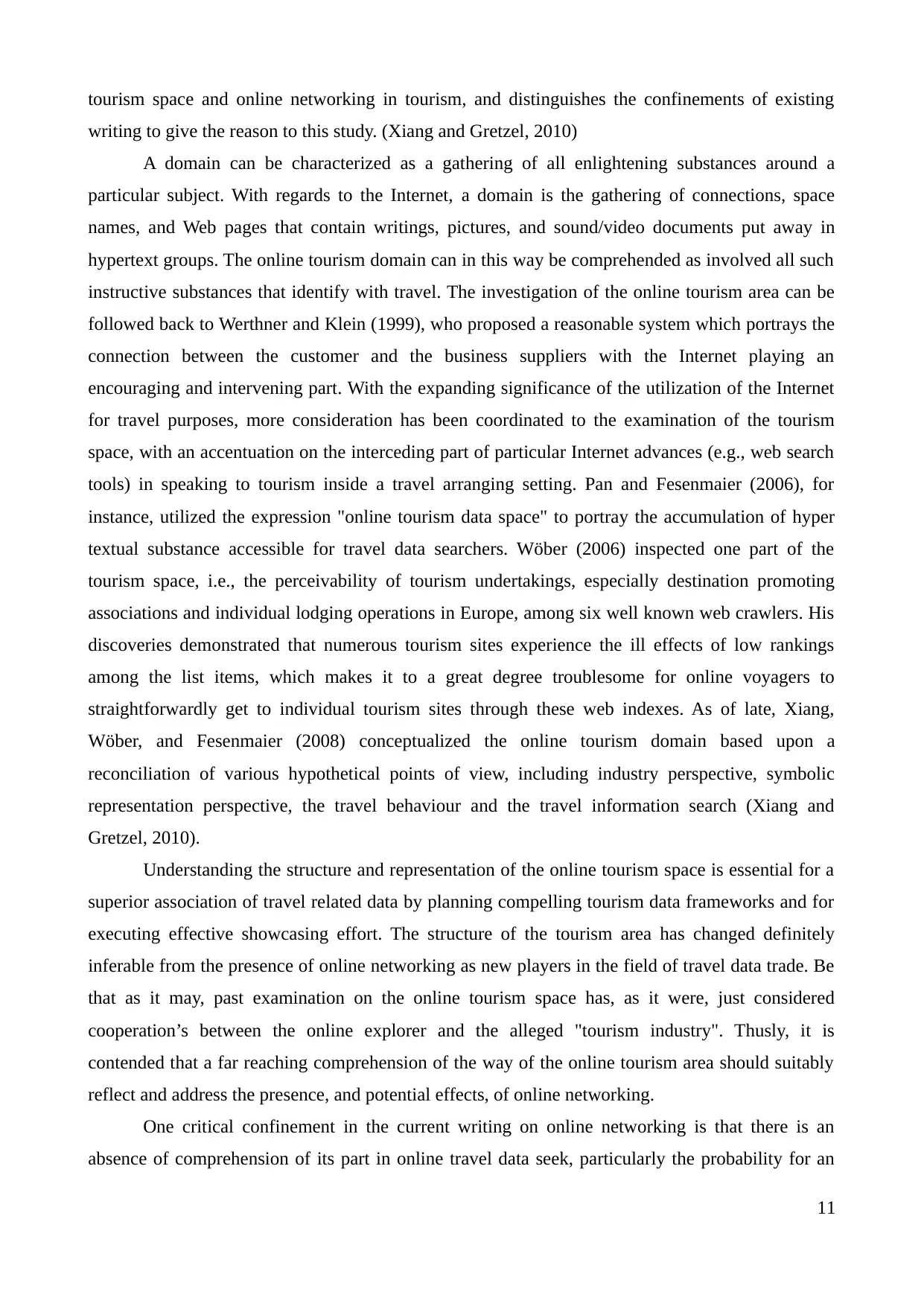
tourism space and online networking in tourism, and distinguishes the confinements of existing
writing to give the reason to this study. (Xiang and Gretzel, 2010)
A domain can be characterized as a gathering of all enlightening substances around a
particular subject. With regards to the Internet, a domain is the gathering of connections, space
names, and Web pages that contain writings, pictures, and sound/video documents put away in
hypertext groups. The online tourism domain can in this way be comprehended as involved all such
instructive substances that identify with travel. The investigation of the online tourism area can be
followed back to Werthner and Klein (1999), who proposed a reasonable system which portrays the
connection between the customer and the business suppliers with the Internet playing an
encouraging and intervening part. With the expanding significance of the utilization of the Internet
for travel purposes, more consideration has been coordinated to the examination of the tourism
space, with an accentuation on the interceding part of particular Internet advances (e.g., web search
tools) in speaking to tourism inside a travel arranging setting. Pan and Fesenmaier (2006), for
instance, utilized the expression "online tourism data space" to portray the accumulation of hyper
textual substance accessible for travel data searchers. Wöber (2006) inspected one part of the
tourism space, i.e., the perceivability of tourism undertakings, especially destination promoting
associations and individual lodging operations in Europe, among six well known web crawlers. His
discoveries demonstrated that numerous tourism sites experience the ill effects of low rankings
among the list items, which makes it to a great degree troublesome for online voyagers to
straightforwardly get to individual tourism sites through these web indexes. As of late, Xiang,
Wöber, and Fesenmaier (2008) conceptualized the online tourism domain based upon a
reconciliation of various hypothetical points of view, including industry perspective, symbolic
representation perspective, the travel behaviour and the travel information search (Xiang and
Gretzel, 2010).
Understanding the structure and representation of the online tourism space is essential for a
superior association of travel related data by planning compelling tourism data frameworks and for
executing effective showcasing effort. The structure of the tourism area has changed definitely
inferable from the presence of online networking as new players in the field of travel data trade. Be
that as it may, past examination on the online tourism space has, as it were, just considered
cooperation’s between the online explorer and the alleged "tourism industry". Thusly, it is
contended that a far reaching comprehension of the way of the online tourism area should suitably
reflect and address the presence, and potential effects, of online networking.
One critical confinement in the current writing on online networking is that there is an
absence of comprehension of its part in online travel data seek, particularly the probability for an
11
writing to give the reason to this study. (Xiang and Gretzel, 2010)
A domain can be characterized as a gathering of all enlightening substances around a
particular subject. With regards to the Internet, a domain is the gathering of connections, space
names, and Web pages that contain writings, pictures, and sound/video documents put away in
hypertext groups. The online tourism domain can in this way be comprehended as involved all such
instructive substances that identify with travel. The investigation of the online tourism area can be
followed back to Werthner and Klein (1999), who proposed a reasonable system which portrays the
connection between the customer and the business suppliers with the Internet playing an
encouraging and intervening part. With the expanding significance of the utilization of the Internet
for travel purposes, more consideration has been coordinated to the examination of the tourism
space, with an accentuation on the interceding part of particular Internet advances (e.g., web search
tools) in speaking to tourism inside a travel arranging setting. Pan and Fesenmaier (2006), for
instance, utilized the expression "online tourism data space" to portray the accumulation of hyper
textual substance accessible for travel data searchers. Wöber (2006) inspected one part of the
tourism space, i.e., the perceivability of tourism undertakings, especially destination promoting
associations and individual lodging operations in Europe, among six well known web crawlers. His
discoveries demonstrated that numerous tourism sites experience the ill effects of low rankings
among the list items, which makes it to a great degree troublesome for online voyagers to
straightforwardly get to individual tourism sites through these web indexes. As of late, Xiang,
Wöber, and Fesenmaier (2008) conceptualized the online tourism domain based upon a
reconciliation of various hypothetical points of view, including industry perspective, symbolic
representation perspective, the travel behaviour and the travel information search (Xiang and
Gretzel, 2010).
Understanding the structure and representation of the online tourism space is essential for a
superior association of travel related data by planning compelling tourism data frameworks and for
executing effective showcasing effort. The structure of the tourism area has changed definitely
inferable from the presence of online networking as new players in the field of travel data trade. Be
that as it may, past examination on the online tourism space has, as it were, just considered
cooperation’s between the online explorer and the alleged "tourism industry". Thusly, it is
contended that a far reaching comprehension of the way of the online tourism area should suitably
reflect and address the presence, and potential effects, of online networking.
One critical confinement in the current writing on online networking is that there is an
absence of comprehension of its part in online travel data seek, particularly the probability for an
11

online voyager to be presented to and really utilize these social networking Websites when
searching for travel data. In particular, as of now accessible data about voyagers' utilization of
online networking was based upon information gathered through self-reported surveys (e.g.,
utilizing an inquiry, for example, "how regularly do you utilize a particular social networking
Website") and accordingly, the level of objectivity is exceptionally restricted. Then again, it was
based upon controlled trial settings by requesting that subjects lead an excursion arranging
assignment online to comprehend the mental impacts of social networking on explorers. Given
these impediments, the degree to which online networking constitute the online tourism area is not
surely knew in a goal, far reaching way.
Given the potential effect of social networking in online tourism, learning about the part of
online networking in travel data hunt is viewed as fundamental to better educate tourism
showcasing hones. Above all else, the development of online networking has offered ascend to
issues as for how tourism advertisers can influence online networking keeping in mind the end goal
to bolster their internet showcasing endeavours. Numerous travel and tourism operations have
likewise perceived the significance of including buyer created content on their Web locales, for the
most part as altered testimonials (e.g., VisitPA.com and Sheraton.com). Promoting specialists
frequently utilize the mark "electronic verbal" to depict the effect of such media content.
Schmallegger and Carson (2008) proposed that methodologies of utilizing web journals as a data
channel incorporate correspondence, advancement, item circulation, administration, and
examination. It appears that present tourism showcasing rehearse centres consideration on using
online networking to make positive picture and informal exchange for vacationer destinations and
organizations. In any case, without a strong comprehension of the part of online networking in
online travel data seek, tourism advertisers' capacity to take advantage this "business sector
knowledge" is exceptionally constrained (Xiang and Gretzel, 2010).
This study will be based on the theory of destination perception formation (or DI).
Destination formation occurs through a complex process of evaluating a destination upon visit or
non-visit by an individual. As noted from the relevant literature, DI bears no one unique definition,
and studies have taken various divergent perspectives on its meaning in the context of their
research. Audience DI formation occurs in an evolving cycle that starts from pre-visit, participation
at the tourist destination, well into post-visit phases (Tasci & Gartner, 2007).
Psychologically, destination image is seen as a composite of both holistic constructions and
visual representation of the destination, and consists all associated knowledge, impressions,
emotions, beliefs as well as individual values (Chi & Hailin, 2008). From this perspective, DI will
be explored in terms of the mental images that foreigners and local Thai tourists hold in their minds
12
searching for travel data. In particular, as of now accessible data about voyagers' utilization of
online networking was based upon information gathered through self-reported surveys (e.g.,
utilizing an inquiry, for example, "how regularly do you utilize a particular social networking
Website") and accordingly, the level of objectivity is exceptionally restricted. Then again, it was
based upon controlled trial settings by requesting that subjects lead an excursion arranging
assignment online to comprehend the mental impacts of social networking on explorers. Given
these impediments, the degree to which online networking constitute the online tourism area is not
surely knew in a goal, far reaching way.
Given the potential effect of social networking in online tourism, learning about the part of
online networking in travel data hunt is viewed as fundamental to better educate tourism
showcasing hones. Above all else, the development of online networking has offered ascend to
issues as for how tourism advertisers can influence online networking keeping in mind the end goal
to bolster their internet showcasing endeavours. Numerous travel and tourism operations have
likewise perceived the significance of including buyer created content on their Web locales, for the
most part as altered testimonials (e.g., VisitPA.com and Sheraton.com). Promoting specialists
frequently utilize the mark "electronic verbal" to depict the effect of such media content.
Schmallegger and Carson (2008) proposed that methodologies of utilizing web journals as a data
channel incorporate correspondence, advancement, item circulation, administration, and
examination. It appears that present tourism showcasing rehearse centres consideration on using
online networking to make positive picture and informal exchange for vacationer destinations and
organizations. In any case, without a strong comprehension of the part of online networking in
online travel data seek, tourism advertisers' capacity to take advantage this "business sector
knowledge" is exceptionally constrained (Xiang and Gretzel, 2010).
This study will be based on the theory of destination perception formation (or DI).
Destination formation occurs through a complex process of evaluating a destination upon visit or
non-visit by an individual. As noted from the relevant literature, DI bears no one unique definition,
and studies have taken various divergent perspectives on its meaning in the context of their
research. Audience DI formation occurs in an evolving cycle that starts from pre-visit, participation
at the tourist destination, well into post-visit phases (Tasci & Gartner, 2007).
Psychologically, destination image is seen as a composite of both holistic constructions and
visual representation of the destination, and consists all associated knowledge, impressions,
emotions, beliefs as well as individual values (Chi & Hailin, 2008). From this perspective, DI will
be explored in terms of the mental images that foreigners and local Thai tourists hold in their minds
12
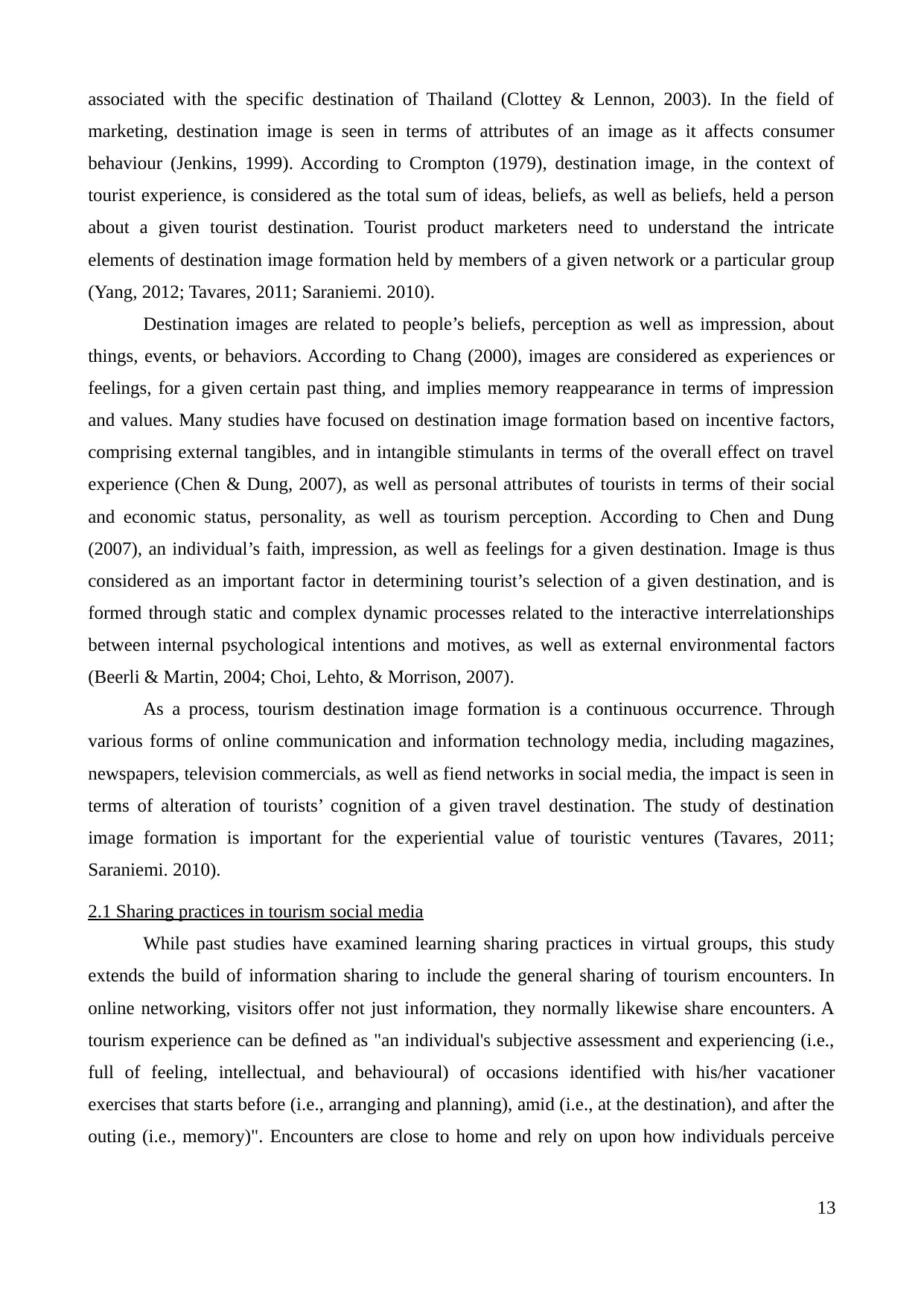
associated with the specific destination of Thailand (Clottey & Lennon, 2003). In the field of
marketing, destination image is seen in terms of attributes of an image as it affects consumer
behaviour (Jenkins, 1999). According to Crompton (1979), destination image, in the context of
tourist experience, is considered as the total sum of ideas, beliefs, as well as beliefs, held a person
about a given tourist destination. Tourist product marketers need to understand the intricate
elements of destination image formation held by members of a given network or a particular group
(Yang, 2012; Tavares, 2011; Saraniemi. 2010).
Destination images are related to people’s beliefs, perception as well as impression, about
things, events, or behaviors. According to Chang (2000), images are considered as experiences or
feelings, for a given certain past thing, and implies memory reappearance in terms of impression
and values. Many studies have focused on destination image formation based on incentive factors,
comprising external tangibles, and in intangible stimulants in terms of the overall effect on travel
experience (Chen & Dung, 2007), as well as personal attributes of tourists in terms of their social
and economic status, personality, as well as tourism perception. According to Chen and Dung
(2007), an individual’s faith, impression, as well as feelings for a given destination. Image is thus
considered as an important factor in determining tourist’s selection of a given destination, and is
formed through static and complex dynamic processes related to the interactive interrelationships
between internal psychological intentions and motives, as well as external environmental factors
(Beerli & Martin, 2004; Choi, Lehto, & Morrison, 2007).
As a process, tourism destination image formation is a continuous occurrence. Through
various forms of online communication and information technology media, including magazines,
newspapers, television commercials, as well as fiend networks in social media, the impact is seen in
terms of alteration of tourists’ cognition of a given travel destination. The study of destination
image formation is important for the experiential value of touristic ventures (Tavares, 2011;
Saraniemi. 2010).
2.1 Sharing practices in tourism social media
While past studies have examined learning sharing practices in virtual groups, this study
extends the build of information sharing to include the general sharing of tourism encounters. In
online networking, visitors offer not just information, they normally likewise share encounters. A
tourism experience can be defined as "an individual's subjective assessment and experiencing (i.e.,
full of feeling, intellectual, and behavioural) of occasions identified with his/her vacationer
exercises that starts before (i.e., arranging and planning), amid (i.e., at the destination), and after the
outing (i.e., memory)". Encounters are close to home and rely on upon how individuals perceive
13
marketing, destination image is seen in terms of attributes of an image as it affects consumer
behaviour (Jenkins, 1999). According to Crompton (1979), destination image, in the context of
tourist experience, is considered as the total sum of ideas, beliefs, as well as beliefs, held a person
about a given tourist destination. Tourist product marketers need to understand the intricate
elements of destination image formation held by members of a given network or a particular group
(Yang, 2012; Tavares, 2011; Saraniemi. 2010).
Destination images are related to people’s beliefs, perception as well as impression, about
things, events, or behaviors. According to Chang (2000), images are considered as experiences or
feelings, for a given certain past thing, and implies memory reappearance in terms of impression
and values. Many studies have focused on destination image formation based on incentive factors,
comprising external tangibles, and in intangible stimulants in terms of the overall effect on travel
experience (Chen & Dung, 2007), as well as personal attributes of tourists in terms of their social
and economic status, personality, as well as tourism perception. According to Chen and Dung
(2007), an individual’s faith, impression, as well as feelings for a given destination. Image is thus
considered as an important factor in determining tourist’s selection of a given destination, and is
formed through static and complex dynamic processes related to the interactive interrelationships
between internal psychological intentions and motives, as well as external environmental factors
(Beerli & Martin, 2004; Choi, Lehto, & Morrison, 2007).
As a process, tourism destination image formation is a continuous occurrence. Through
various forms of online communication and information technology media, including magazines,
newspapers, television commercials, as well as fiend networks in social media, the impact is seen in
terms of alteration of tourists’ cognition of a given travel destination. The study of destination
image formation is important for the experiential value of touristic ventures (Tavares, 2011;
Saraniemi. 2010).
2.1 Sharing practices in tourism social media
While past studies have examined learning sharing practices in virtual groups, this study
extends the build of information sharing to include the general sharing of tourism encounters. In
online networking, visitors offer not just information, they normally likewise share encounters. A
tourism experience can be defined as "an individual's subjective assessment and experiencing (i.e.,
full of feeling, intellectual, and behavioural) of occasions identified with his/her vacationer
exercises that starts before (i.e., arranging and planning), amid (i.e., at the destination), and after the
outing (i.e., memory)". Encounters are close to home and rely on upon how individuals perceive
13
Paraphrase This Document
Need a fresh take? Get an instant paraphrase of this document with our AI Paraphraser

and respond to specific tourism spots and items (e.g. destinations, attractions, and settlement). The
sharing of encounters incorporates not just information related perspectives, for example, realities
about occasion properties (e.g. costs, climate conditions, shorelines and different attractions)
however may furthermore incorporate imparting feelings, creative energies and dreams about
elements of a holiday, for case through photographs, emotions and other phonetic markers in online
correspondence. Research has additionally demonstrated that counsel on common-sense matters and
typified sentiments of solace or distress are pertinent in online surveys of tourism attractions. The
discernments and know edge of tourism are considered not just along the spatial movement of really
going by spots; it is similarly moulded by encounters of interceded, reproduced, and envisioned
space as likewise by touristic protests, for example, gifts and postcards. Online networking gives
new channels to the creation and flow of significance in tourism encounters and creative abilities.
(Munar and Jacobsen, 2014)
2.2 Real-time sharing
Visitors can make and share their encounters online over various time horizons. The
development of new media and portable advancements builds the likelihood of ongoing background
sharing and energizes synchronic correspondence sorts. Progressively, phone calls as well as
constant electronic media, for example, short message administrations (SMS) permit vacationers to
keep up connections while away on vacation. Vacationers may along these lines pick up a feeling of
constant coordination into home occasions by starting messages about their encounters by
messaging, sending photos/video by telephone, utilizing email and posting on Internet locales.
(Munar and Jacobsen, 2014)
2.3 Social media types
Web 1.0 alludes to the first phase of improvement of the World Wide Web when sites were
not yet giving intelligent and client created content. The advancement of Web 1.0 is known as Web
2.0 or online networking. Online networking receives a wide range of structures. Well known sorts
are wikis (e.g. Wikitravel), online journals (e.g. Travel blog) and small scale web journals (e.g.
Twitter), interpersonal organization destinations (e.g. Facebook), media-sharing locales (e.g. Flickr,
YouTube), audit locales (e.g. TripAdvisor) and voting destinations (e.g. Digg). These sorts contrast
in levels of empowered social intuitiveness, worldly structure and reach of correspondence, measure
of expressive gestures and connection wealth (e.g. data about individual characters and
spatial/natural connections), and additionally levels of pecking order and control set up by site
chairmen. Informal organization destinations as a rule give meaningful gestures that are wealthier
than that found in different sorts of stages, for example, survey locales or media sharing
14
sharing of encounters incorporates not just information related perspectives, for example, realities
about occasion properties (e.g. costs, climate conditions, shorelines and different attractions)
however may furthermore incorporate imparting feelings, creative energies and dreams about
elements of a holiday, for case through photographs, emotions and other phonetic markers in online
correspondence. Research has additionally demonstrated that counsel on common-sense matters and
typified sentiments of solace or distress are pertinent in online surveys of tourism attractions. The
discernments and know edge of tourism are considered not just along the spatial movement of really
going by spots; it is similarly moulded by encounters of interceded, reproduced, and envisioned
space as likewise by touristic protests, for example, gifts and postcards. Online networking gives
new channels to the creation and flow of significance in tourism encounters and creative abilities.
(Munar and Jacobsen, 2014)
2.2 Real-time sharing
Visitors can make and share their encounters online over various time horizons. The
development of new media and portable advancements builds the likelihood of ongoing background
sharing and energizes synchronic correspondence sorts. Progressively, phone calls as well as
constant electronic media, for example, short message administrations (SMS) permit vacationers to
keep up connections while away on vacation. Vacationers may along these lines pick up a feeling of
constant coordination into home occasions by starting messages about their encounters by
messaging, sending photos/video by telephone, utilizing email and posting on Internet locales.
(Munar and Jacobsen, 2014)
2.3 Social media types
Web 1.0 alludes to the first phase of improvement of the World Wide Web when sites were
not yet giving intelligent and client created content. The advancement of Web 1.0 is known as Web
2.0 or online networking. Online networking receives a wide range of structures. Well known sorts
are wikis (e.g. Wikitravel), online journals (e.g. Travel blog) and small scale web journals (e.g.
Twitter), interpersonal organization destinations (e.g. Facebook), media-sharing locales (e.g. Flickr,
YouTube), audit locales (e.g. TripAdvisor) and voting destinations (e.g. Digg). These sorts contrast
in levels of empowered social intuitiveness, worldly structure and reach of correspondence, measure
of expressive gestures and connection wealth (e.g. data about individual characters and
spatial/natural connections), and additionally levels of pecking order and control set up by site
chairmen. Informal organization destinations as a rule give meaningful gestures that are wealthier
than that found in different sorts of stages, for example, survey locales or media sharing
14

destinations. Here one can recognize private and open sharing, on stages that permit the clients to
tailor correspondence reach. For instance, sightseers can pick between making their substance
accessible to all web clients, their companions, or specific bunches/people. It has been demonstrated
that sorts of online networking are significant to travellers' association and use. (Munar and
Jacobsen, 2014).
2.4 Textual versus visual content
Tourism as touring is profoundly identified with picture making media and this is to some
degree additionally the case for occasion making, for example, unwinding in ocean side resorts.
While data sharing is regularly identified with literary and account informative practices (e.g. writes
and composed surveys), the sharing of encounters specifically recognizes creation and sharing of
(sound)- visual substance on the web. Photos or short recordings sent from cellular telephones act
progressively as the new postcard. While makers of visual substance regularly have been spurred by
the ludic breathing easy, makers of account substance want to scatter data. (Munar and Jacobsen,
2014)
2.5 Impacts on tourism culture and knowledge
Online networking is changing the tourism society. Paris has focused on explorers utilizing
online networking, and even authored another word "flashpacker" to depict a hiker who depends
vigorously upon online networking in his/her whole travel process including some time recently,
amid and after travel. He proposed that online networking utilization has had a tendency to add to
the arrangement of another tourism society, and the proceeding with joining of physical go with
data and correspondence advancements. Regular topics rose up out of online networking
exploration, for example, the conceptualization of association and disengagement, the effect of
advances on the conventional physical spaces of hikers' social communication, and the expanding
fluidity amongst "vacationer" and 'non-traveler' encounters. Nature of tourism is going to change
forever through the influence of the social web on media landscapes, media utilization and the
development of tourism creative energies.
Online networking use can likewise add to tourism information creation. Chalkiti and Sigala
(2008) uncovered that as a result of the learning creation capacity and reasonableness of online
networking platforms, web organizing decidedly adds to data sharing, information creation and
thought era abilities of distributed virtual groups. Social networking and online data including UGC
would influence valuation and evaluation frameworks, e.g. the positioning arrangement of tourism
industry members, for example, inns and the recommender framework. Online networking has
turned into an examination instrument leading scholastic investigations of tourism and friendliness.
15
tailor correspondence reach. For instance, sightseers can pick between making their substance
accessible to all web clients, their companions, or specific bunches/people. It has been demonstrated
that sorts of online networking are significant to travellers' association and use. (Munar and
Jacobsen, 2014).
2.4 Textual versus visual content
Tourism as touring is profoundly identified with picture making media and this is to some
degree additionally the case for occasion making, for example, unwinding in ocean side resorts.
While data sharing is regularly identified with literary and account informative practices (e.g. writes
and composed surveys), the sharing of encounters specifically recognizes creation and sharing of
(sound)- visual substance on the web. Photos or short recordings sent from cellular telephones act
progressively as the new postcard. While makers of visual substance regularly have been spurred by
the ludic breathing easy, makers of account substance want to scatter data. (Munar and Jacobsen,
2014)
2.5 Impacts on tourism culture and knowledge
Online networking is changing the tourism society. Paris has focused on explorers utilizing
online networking, and even authored another word "flashpacker" to depict a hiker who depends
vigorously upon online networking in his/her whole travel process including some time recently,
amid and after travel. He proposed that online networking utilization has had a tendency to add to
the arrangement of another tourism society, and the proceeding with joining of physical go with
data and correspondence advancements. Regular topics rose up out of online networking
exploration, for example, the conceptualization of association and disengagement, the effect of
advances on the conventional physical spaces of hikers' social communication, and the expanding
fluidity amongst "vacationer" and 'non-traveler' encounters. Nature of tourism is going to change
forever through the influence of the social web on media landscapes, media utilization and the
development of tourism creative energies.
Online networking use can likewise add to tourism information creation. Chalkiti and Sigala
(2008) uncovered that as a result of the learning creation capacity and reasonableness of online
networking platforms, web organizing decidedly adds to data sharing, information creation and
thought era abilities of distributed virtual groups. Social networking and online data including UGC
would influence valuation and evaluation frameworks, e.g. the positioning arrangement of tourism
industry members, for example, inns and the recommender framework. Online networking has
turned into an examination instrument leading scholastic investigations of tourism and friendliness.
15
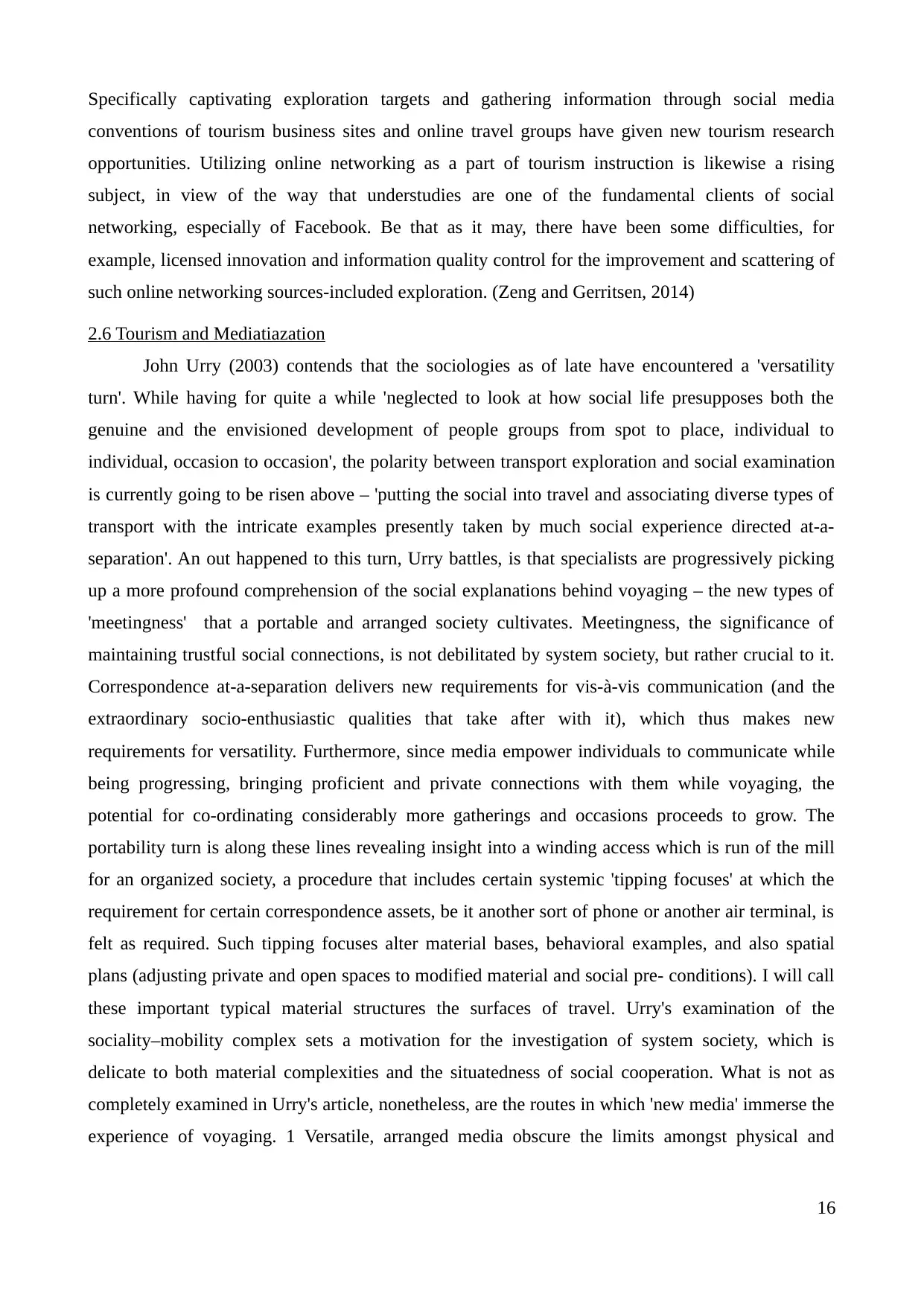
Specifically captivating exploration targets and gathering information through social media
conventions of tourism business sites and online travel groups have given new tourism research
opportunities. Utilizing online networking as a part of tourism instruction is likewise a rising
subject, in view of the way that understudies are one of the fundamental clients of social
networking, especially of Facebook. Be that as it may, there have been some difficulties, for
example, licensed innovation and information quality control for the improvement and scattering of
such online networking sources-included exploration. (Zeng and Gerritsen, 2014)
2.6 Tourism and Mediatiazation
John Urry (2003) contends that the sociologies as of late have encountered a 'versatility
turn'. While having for quite a while 'neglected to look at how social life presupposes both the
genuine and the envisioned development of people groups from spot to place, individual to
individual, occasion to occasion', the polarity between transport exploration and social examination
is currently going to be risen above – 'putting the social into travel and associating diverse types of
transport with the intricate examples presently taken by much social experience directed at-a-
separation'. An out happened to this turn, Urry battles, is that specialists are progressively picking
up a more profound comprehension of the social explanations behind voyaging – the new types of
'meetingness' that a portable and arranged society cultivates. Meetingness, the significance of
maintaining trustful social connections, is not debilitated by system society, but rather crucial to it.
Correspondence at-a-separation delivers new requirements for vis-à-vis communication (and the
extraordinary socio-enthusiastic qualities that take after with it), which thus makes new
requirements for versatility. Furthermore, since media empower individuals to communicate while
being progressing, bringing proficient and private connections with them while voyaging, the
potential for co-ordinating considerably more gatherings and occasions proceeds to grow. The
portability turn is along these lines revealing insight into a winding access which is run of the mill
for an organized society, a procedure that includes certain systemic 'tipping focuses' at which the
requirement for certain correspondence assets, be it another sort of phone or another air terminal, is
felt as required. Such tipping focuses alter material bases, behavioral examples, and also spatial
plans (adjusting private and open spaces to modified material and social pre- conditions). I will call
these important typical material structures the surfaces of travel. Urry's examination of the
sociality–mobility complex sets a motivation for the investigation of system society, which is
delicate to both material complexities and the situatedness of social cooperation. What is not as
completely examined in Urry's article, nonetheless, are the routes in which 'new media' immerse the
experience of voyaging. 1 Versatile, arranged media obscure the limits amongst physical and
16
conventions of tourism business sites and online travel groups have given new tourism research
opportunities. Utilizing online networking as a part of tourism instruction is likewise a rising
subject, in view of the way that understudies are one of the fundamental clients of social
networking, especially of Facebook. Be that as it may, there have been some difficulties, for
example, licensed innovation and information quality control for the improvement and scattering of
such online networking sources-included exploration. (Zeng and Gerritsen, 2014)
2.6 Tourism and Mediatiazation
John Urry (2003) contends that the sociologies as of late have encountered a 'versatility
turn'. While having for quite a while 'neglected to look at how social life presupposes both the
genuine and the envisioned development of people groups from spot to place, individual to
individual, occasion to occasion', the polarity between transport exploration and social examination
is currently going to be risen above – 'putting the social into travel and associating diverse types of
transport with the intricate examples presently taken by much social experience directed at-a-
separation'. An out happened to this turn, Urry battles, is that specialists are progressively picking
up a more profound comprehension of the social explanations behind voyaging – the new types of
'meetingness' that a portable and arranged society cultivates. Meetingness, the significance of
maintaining trustful social connections, is not debilitated by system society, but rather crucial to it.
Correspondence at-a-separation delivers new requirements for vis-à-vis communication (and the
extraordinary socio-enthusiastic qualities that take after with it), which thus makes new
requirements for versatility. Furthermore, since media empower individuals to communicate while
being progressing, bringing proficient and private connections with them while voyaging, the
potential for co-ordinating considerably more gatherings and occasions proceeds to grow. The
portability turn is along these lines revealing insight into a winding access which is run of the mill
for an organized society, a procedure that includes certain systemic 'tipping focuses' at which the
requirement for certain correspondence assets, be it another sort of phone or another air terminal, is
felt as required. Such tipping focuses alter material bases, behavioral examples, and also spatial
plans (adjusting private and open spaces to modified material and social pre- conditions). I will call
these important typical material structures the surfaces of travel. Urry's examination of the
sociality–mobility complex sets a motivation for the investigation of system society, which is
delicate to both material complexities and the situatedness of social cooperation. What is not as
completely examined in Urry's article, nonetheless, are the routes in which 'new media' immerse the
experience of voyaging. 1 Versatile, arranged media obscure the limits amongst physical and
16
Secure Best Marks with AI Grader
Need help grading? Try our AI Grader for instant feedback on your assignments.
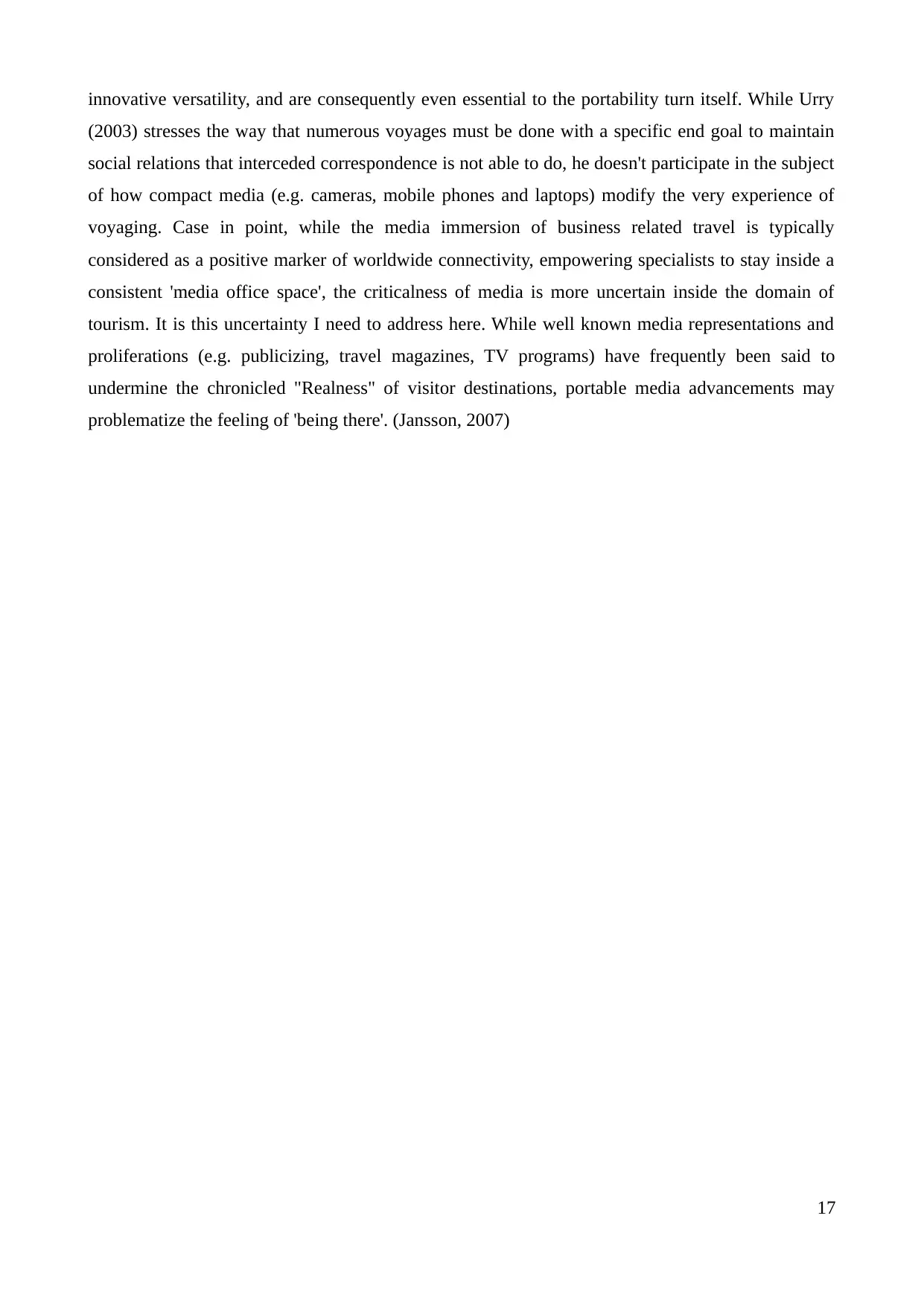
innovative versatility, and are consequently even essential to the portability turn itself. While Urry
(2003) stresses the way that numerous voyages must be done with a specific end goal to maintain
social relations that interceded correspondence is not able to do, he doesn't participate in the subject
of how compact media (e.g. cameras, mobile phones and laptops) modify the very experience of
voyaging. Case in point, while the media immersion of business related travel is typically
considered as a positive marker of worldwide connectivity, empowering specialists to stay inside a
consistent 'media office space', the criticalness of media is more uncertain inside the domain of
tourism. It is this uncertainty I need to address here. While well known media representations and
proliferations (e.g. publicizing, travel magazines, TV programs) have frequently been said to
undermine the chronicled "Realness" of visitor destinations, portable media advancements may
problematize the feeling of 'being there'. (Jansson, 2007)
17
(2003) stresses the way that numerous voyages must be done with a specific end goal to maintain
social relations that interceded correspondence is not able to do, he doesn't participate in the subject
of how compact media (e.g. cameras, mobile phones and laptops) modify the very experience of
voyaging. Case in point, while the media immersion of business related travel is typically
considered as a positive marker of worldwide connectivity, empowering specialists to stay inside a
consistent 'media office space', the criticalness of media is more uncertain inside the domain of
tourism. It is this uncertainty I need to address here. While well known media representations and
proliferations (e.g. publicizing, travel magazines, TV programs) have frequently been said to
undermine the chronicled "Realness" of visitor destinations, portable media advancements may
problematize the feeling of 'being there'. (Jansson, 2007)
17
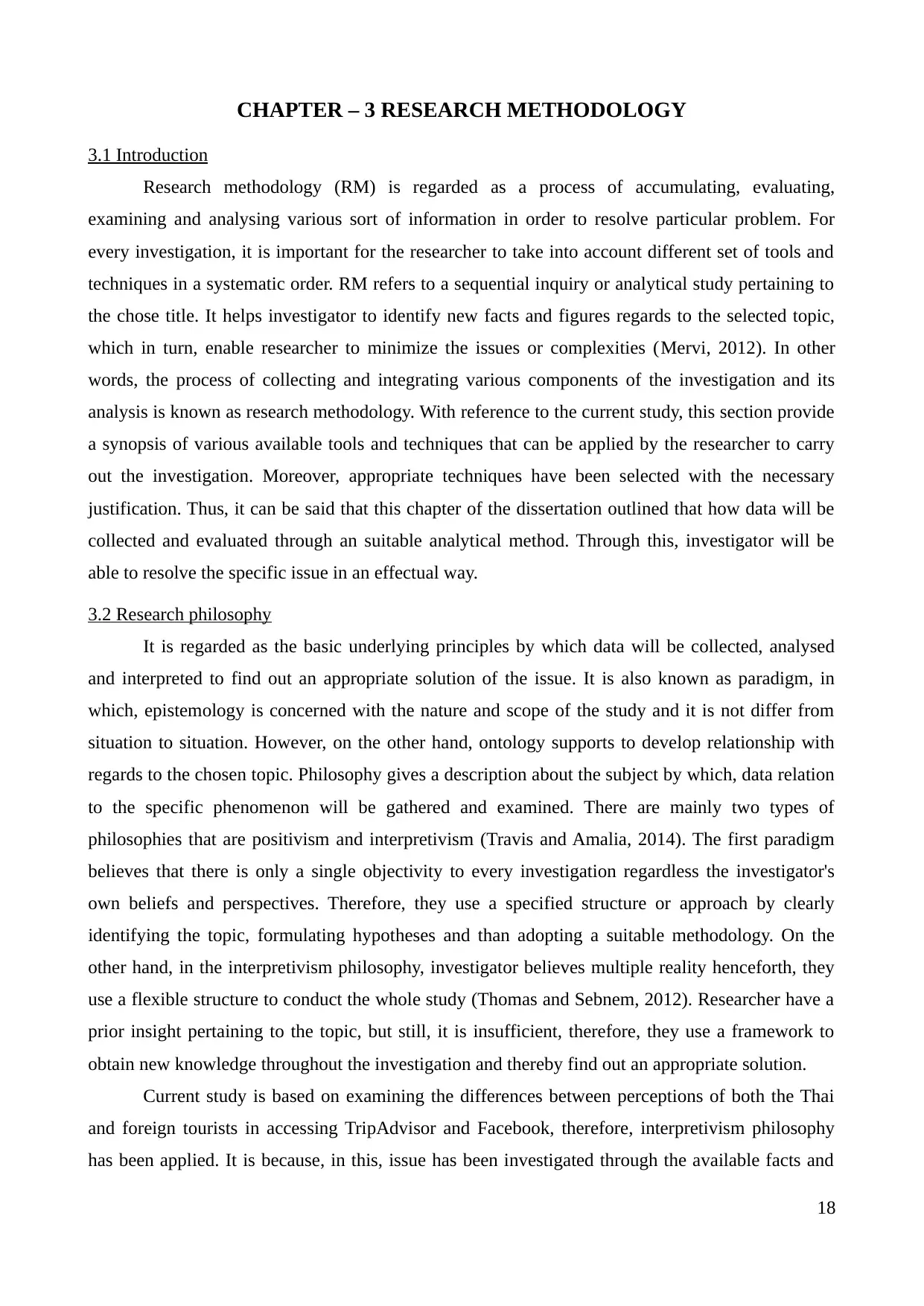
CHAPTER – 3 RESEARCH METHODOLOGY
3.1 Introduction
Research methodology (RM) is regarded as a process of accumulating, evaluating,
examining and analysing various sort of information in order to resolve particular problem. For
every investigation, it is important for the researcher to take into account different set of tools and
techniques in a systematic order. RM refers to a sequential inquiry or analytical study pertaining to
the chose title. It helps investigator to identify new facts and figures regards to the selected topic,
which in turn, enable researcher to minimize the issues or complexities (Mervi, 2012). In other
words, the process of collecting and integrating various components of the investigation and its
analysis is known as research methodology. With reference to the current study, this section provide
a synopsis of various available tools and techniques that can be applied by the researcher to carry
out the investigation. Moreover, appropriate techniques have been selected with the necessary
justification. Thus, it can be said that this chapter of the dissertation outlined that how data will be
collected and evaluated through an suitable analytical method. Through this, investigator will be
able to resolve the specific issue in an effectual way.
3.2 Research philosophy
It is regarded as the basic underlying principles by which data will be collected, analysed
and interpreted to find out an appropriate solution of the issue. It is also known as paradigm, in
which, epistemology is concerned with the nature and scope of the study and it is not differ from
situation to situation. However, on the other hand, ontology supports to develop relationship with
regards to the chosen topic. Philosophy gives a description about the subject by which, data relation
to the specific phenomenon will be gathered and examined. There are mainly two types of
philosophies that are positivism and interpretivism (Travis and Amalia, 2014). The first paradigm
believes that there is only a single objectivity to every investigation regardless the investigator's
own beliefs and perspectives. Therefore, they use a specified structure or approach by clearly
identifying the topic, formulating hypotheses and than adopting a suitable methodology. On the
other hand, in the interpretivism philosophy, investigator believes multiple reality henceforth, they
use a flexible structure to conduct the whole study (Thomas and Sebnem, 2012). Researcher have a
prior insight pertaining to the topic, but still, it is insufficient, therefore, they use a framework to
obtain new knowledge throughout the investigation and thereby find out an appropriate solution.
Current study is based on examining the differences between perceptions of both the Thai
and foreign tourists in accessing TripAdvisor and Facebook, therefore, interpretivism philosophy
has been applied. It is because, in this, issue has been investigated through the available facts and
18
3.1 Introduction
Research methodology (RM) is regarded as a process of accumulating, evaluating,
examining and analysing various sort of information in order to resolve particular problem. For
every investigation, it is important for the researcher to take into account different set of tools and
techniques in a systematic order. RM refers to a sequential inquiry or analytical study pertaining to
the chose title. It helps investigator to identify new facts and figures regards to the selected topic,
which in turn, enable researcher to minimize the issues or complexities (Mervi, 2012). In other
words, the process of collecting and integrating various components of the investigation and its
analysis is known as research methodology. With reference to the current study, this section provide
a synopsis of various available tools and techniques that can be applied by the researcher to carry
out the investigation. Moreover, appropriate techniques have been selected with the necessary
justification. Thus, it can be said that this chapter of the dissertation outlined that how data will be
collected and evaluated through an suitable analytical method. Through this, investigator will be
able to resolve the specific issue in an effectual way.
3.2 Research philosophy
It is regarded as the basic underlying principles by which data will be collected, analysed
and interpreted to find out an appropriate solution of the issue. It is also known as paradigm, in
which, epistemology is concerned with the nature and scope of the study and it is not differ from
situation to situation. However, on the other hand, ontology supports to develop relationship with
regards to the chosen topic. Philosophy gives a description about the subject by which, data relation
to the specific phenomenon will be gathered and examined. There are mainly two types of
philosophies that are positivism and interpretivism (Travis and Amalia, 2014). The first paradigm
believes that there is only a single objectivity to every investigation regardless the investigator's
own beliefs and perspectives. Therefore, they use a specified structure or approach by clearly
identifying the topic, formulating hypotheses and than adopting a suitable methodology. On the
other hand, in the interpretivism philosophy, investigator believes multiple reality henceforth, they
use a flexible structure to conduct the whole study (Thomas and Sebnem, 2012). Researcher have a
prior insight pertaining to the topic, but still, it is insufficient, therefore, they use a framework to
obtain new knowledge throughout the investigation and thereby find out an appropriate solution.
Current study is based on examining the differences between perceptions of both the Thai
and foreign tourists in accessing TripAdvisor and Facebook, therefore, interpretivism philosophy
has been applied. It is because, in this, issue has been investigated through the available facts and
18
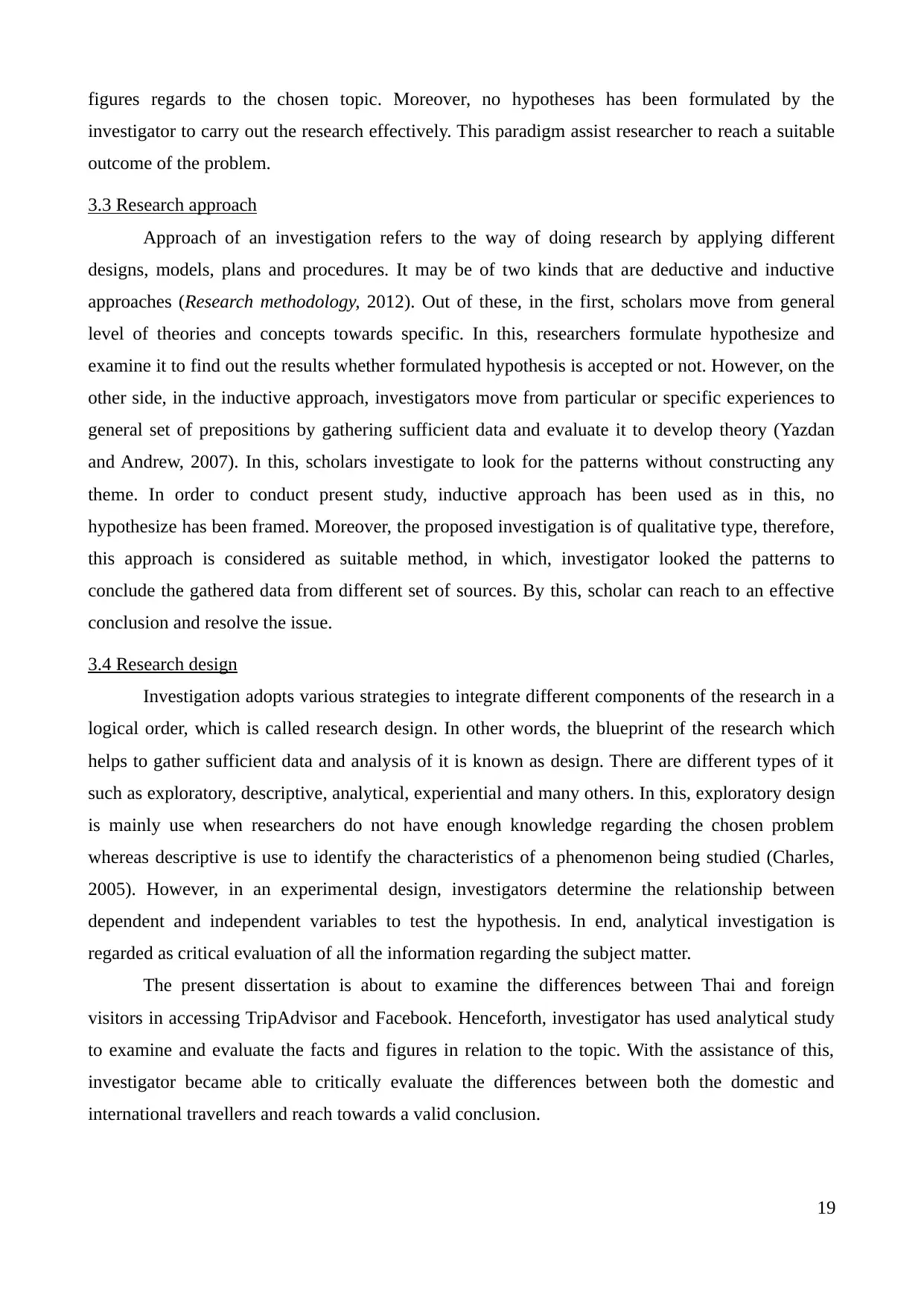
figures regards to the chosen topic. Moreover, no hypotheses has been formulated by the
investigator to carry out the research effectively. This paradigm assist researcher to reach a suitable
outcome of the problem.
3.3 Research approach
Approach of an investigation refers to the way of doing research by applying different
designs, models, plans and procedures. It may be of two kinds that are deductive and inductive
approaches (Research methodology, 2012). Out of these, in the first, scholars move from general
level of theories and concepts towards specific. In this, researchers formulate hypothesize and
examine it to find out the results whether formulated hypothesis is accepted or not. However, on the
other side, in the inductive approach, investigators move from particular or specific experiences to
general set of prepositions by gathering sufficient data and evaluate it to develop theory (Yazdan
and Andrew, 2007). In this, scholars investigate to look for the patterns without constructing any
theme. In order to conduct present study, inductive approach has been used as in this, no
hypothesize has been framed. Moreover, the proposed investigation is of qualitative type, therefore,
this approach is considered as suitable method, in which, investigator looked the patterns to
conclude the gathered data from different set of sources. By this, scholar can reach to an effective
conclusion and resolve the issue.
3.4 Research design
Investigation adopts various strategies to integrate different components of the research in a
logical order, which is called research design. In other words, the blueprint of the research which
helps to gather sufficient data and analysis of it is known as design. There are different types of it
such as exploratory, descriptive, analytical, experiential and many others. In this, exploratory design
is mainly use when researchers do not have enough knowledge regarding the chosen problem
whereas descriptive is use to identify the characteristics of a phenomenon being studied (Charles,
2005). However, in an experimental design, investigators determine the relationship between
dependent and independent variables to test the hypothesis. In end, analytical investigation is
regarded as critical evaluation of all the information regarding the subject matter.
The present dissertation is about to examine the differences between Thai and foreign
visitors in accessing TripAdvisor and Facebook. Henceforth, investigator has used analytical study
to examine and evaluate the facts and figures in relation to the topic. With the assistance of this,
investigator became able to critically evaluate the differences between both the domestic and
international travellers and reach towards a valid conclusion.
19
investigator to carry out the research effectively. This paradigm assist researcher to reach a suitable
outcome of the problem.
3.3 Research approach
Approach of an investigation refers to the way of doing research by applying different
designs, models, plans and procedures. It may be of two kinds that are deductive and inductive
approaches (Research methodology, 2012). Out of these, in the first, scholars move from general
level of theories and concepts towards specific. In this, researchers formulate hypothesize and
examine it to find out the results whether formulated hypothesis is accepted or not. However, on the
other side, in the inductive approach, investigators move from particular or specific experiences to
general set of prepositions by gathering sufficient data and evaluate it to develop theory (Yazdan
and Andrew, 2007). In this, scholars investigate to look for the patterns without constructing any
theme. In order to conduct present study, inductive approach has been used as in this, no
hypothesize has been framed. Moreover, the proposed investigation is of qualitative type, therefore,
this approach is considered as suitable method, in which, investigator looked the patterns to
conclude the gathered data from different set of sources. By this, scholar can reach to an effective
conclusion and resolve the issue.
3.4 Research design
Investigation adopts various strategies to integrate different components of the research in a
logical order, which is called research design. In other words, the blueprint of the research which
helps to gather sufficient data and analysis of it is known as design. There are different types of it
such as exploratory, descriptive, analytical, experiential and many others. In this, exploratory design
is mainly use when researchers do not have enough knowledge regarding the chosen problem
whereas descriptive is use to identify the characteristics of a phenomenon being studied (Charles,
2005). However, in an experimental design, investigators determine the relationship between
dependent and independent variables to test the hypothesis. In end, analytical investigation is
regarded as critical evaluation of all the information regarding the subject matter.
The present dissertation is about to examine the differences between Thai and foreign
visitors in accessing TripAdvisor and Facebook. Henceforth, investigator has used analytical study
to examine and evaluate the facts and figures in relation to the topic. With the assistance of this,
investigator became able to critically evaluate the differences between both the domestic and
international travellers and reach towards a valid conclusion.
19
Paraphrase This Document
Need a fresh take? Get an instant paraphrase of this document with our AI Paraphraser
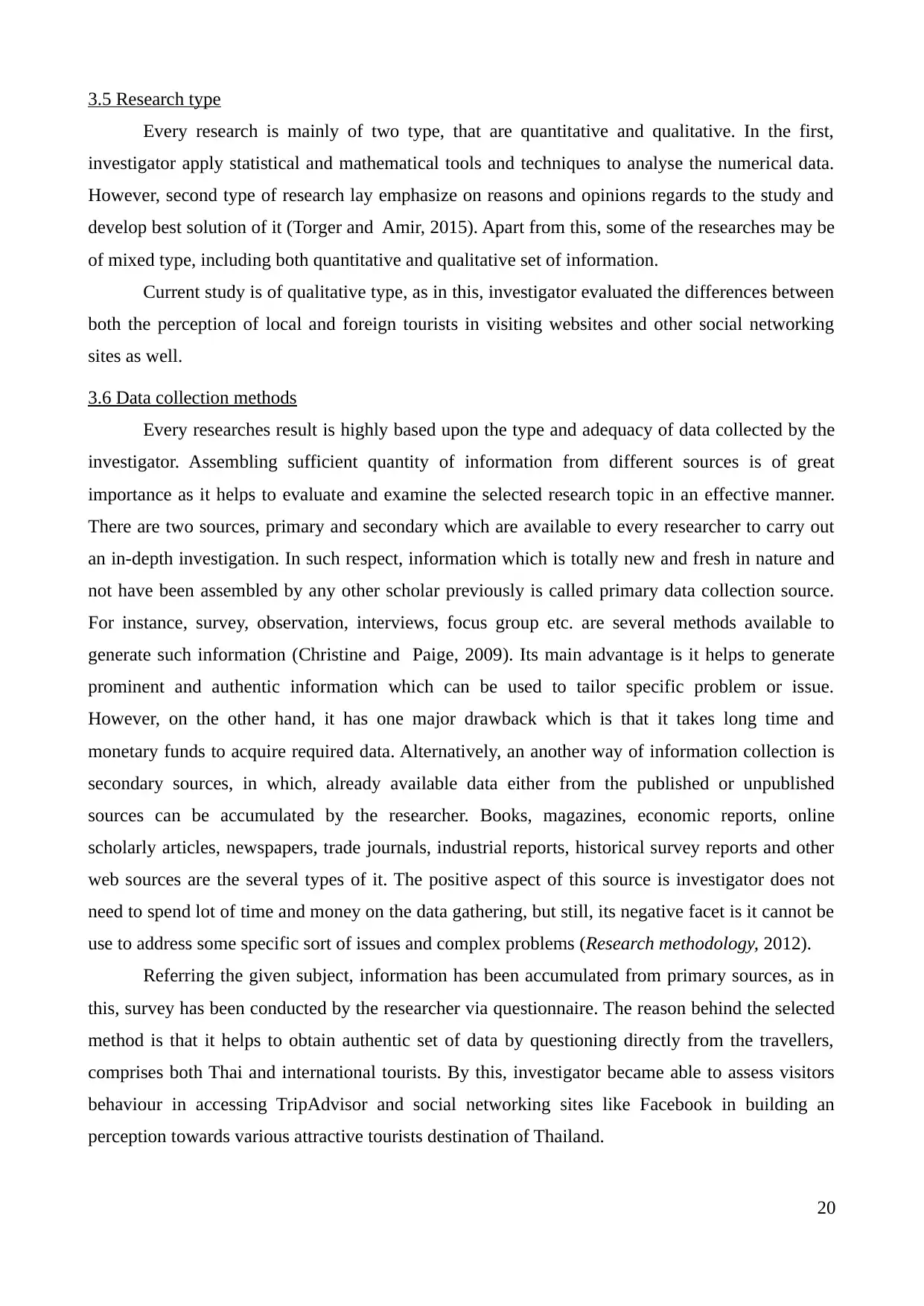
3.5 Research type
Every research is mainly of two type, that are quantitative and qualitative. In the first,
investigator apply statistical and mathematical tools and techniques to analyse the numerical data.
However, second type of research lay emphasize on reasons and opinions regards to the study and
develop best solution of it (Torger and Amir, 2015). Apart from this, some of the researches may be
of mixed type, including both quantitative and qualitative set of information.
Current study is of qualitative type, as in this, investigator evaluated the differences between
both the perception of local and foreign tourists in visiting websites and other social networking
sites as well.
3.6 Data collection methods
Every researches result is highly based upon the type and adequacy of data collected by the
investigator. Assembling sufficient quantity of information from different sources is of great
importance as it helps to evaluate and examine the selected research topic in an effective manner.
There are two sources, primary and secondary which are available to every researcher to carry out
an in-depth investigation. In such respect, information which is totally new and fresh in nature and
not have been assembled by any other scholar previously is called primary data collection source.
For instance, survey, observation, interviews, focus group etc. are several methods available to
generate such information (Christine and Paige, 2009). Its main advantage is it helps to generate
prominent and authentic information which can be used to tailor specific problem or issue.
However, on the other hand, it has one major drawback which is that it takes long time and
monetary funds to acquire required data. Alternatively, an another way of information collection is
secondary sources, in which, already available data either from the published or unpublished
sources can be accumulated by the researcher. Books, magazines, economic reports, online
scholarly articles, newspapers, trade journals, industrial reports, historical survey reports and other
web sources are the several types of it. The positive aspect of this source is investigator does not
need to spend lot of time and money on the data gathering, but still, its negative facet is it cannot be
use to address some specific sort of issues and complex problems (Research methodology, 2012).
Referring the given subject, information has been accumulated from primary sources, as in
this, survey has been conducted by the researcher via questionnaire. The reason behind the selected
method is that it helps to obtain authentic set of data by questioning directly from the travellers,
comprises both Thai and international tourists. By this, investigator became able to assess visitors
behaviour in accessing TripAdvisor and social networking sites like Facebook in building an
perception towards various attractive tourists destination of Thailand.
20
Every research is mainly of two type, that are quantitative and qualitative. In the first,
investigator apply statistical and mathematical tools and techniques to analyse the numerical data.
However, second type of research lay emphasize on reasons and opinions regards to the study and
develop best solution of it (Torger and Amir, 2015). Apart from this, some of the researches may be
of mixed type, including both quantitative and qualitative set of information.
Current study is of qualitative type, as in this, investigator evaluated the differences between
both the perception of local and foreign tourists in visiting websites and other social networking
sites as well.
3.6 Data collection methods
Every researches result is highly based upon the type and adequacy of data collected by the
investigator. Assembling sufficient quantity of information from different sources is of great
importance as it helps to evaluate and examine the selected research topic in an effective manner.
There are two sources, primary and secondary which are available to every researcher to carry out
an in-depth investigation. In such respect, information which is totally new and fresh in nature and
not have been assembled by any other scholar previously is called primary data collection source.
For instance, survey, observation, interviews, focus group etc. are several methods available to
generate such information (Christine and Paige, 2009). Its main advantage is it helps to generate
prominent and authentic information which can be used to tailor specific problem or issue.
However, on the other hand, it has one major drawback which is that it takes long time and
monetary funds to acquire required data. Alternatively, an another way of information collection is
secondary sources, in which, already available data either from the published or unpublished
sources can be accumulated by the researcher. Books, magazines, economic reports, online
scholarly articles, newspapers, trade journals, industrial reports, historical survey reports and other
web sources are the several types of it. The positive aspect of this source is investigator does not
need to spend lot of time and money on the data gathering, but still, its negative facet is it cannot be
use to address some specific sort of issues and complex problems (Research methodology, 2012).
Referring the given subject, information has been accumulated from primary sources, as in
this, survey has been conducted by the researcher via questionnaire. The reason behind the selected
method is that it helps to obtain authentic set of data by questioning directly from the travellers,
comprises both Thai and international tourists. By this, investigator became able to assess visitors
behaviour in accessing TripAdvisor and social networking sites like Facebook in building an
perception towards various attractive tourists destination of Thailand.
20
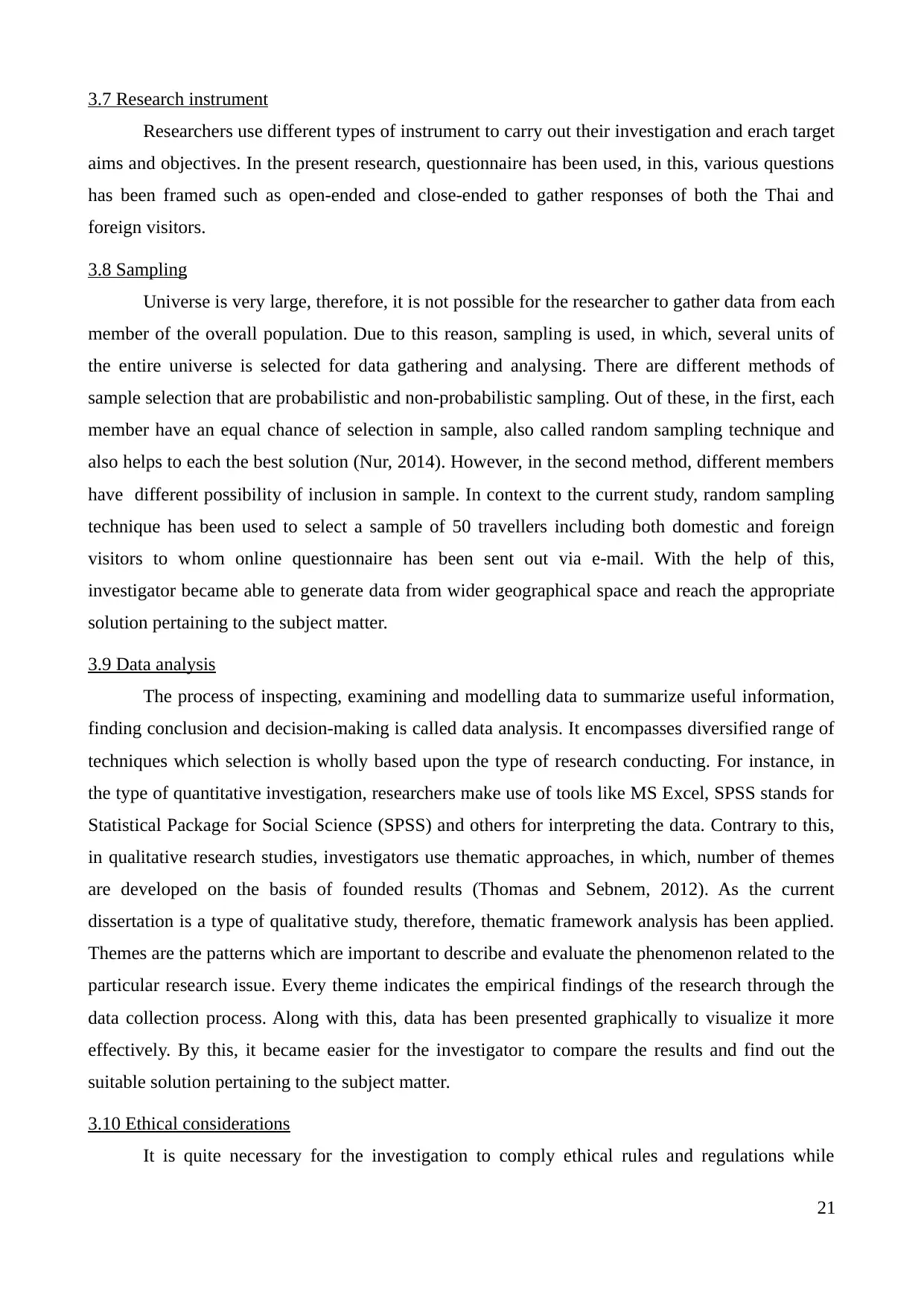
3.7 Research instrument
Researchers use different types of instrument to carry out their investigation and erach target
aims and objectives. In the present research, questionnaire has been used, in this, various questions
has been framed such as open-ended and close-ended to gather responses of both the Thai and
foreign visitors.
3.8 Sampling
Universe is very large, therefore, it is not possible for the researcher to gather data from each
member of the overall population. Due to this reason, sampling is used, in which, several units of
the entire universe is selected for data gathering and analysing. There are different methods of
sample selection that are probabilistic and non-probabilistic sampling. Out of these, in the first, each
member have an equal chance of selection in sample, also called random sampling technique and
also helps to each the best solution (Nur, 2014). However, in the second method, different members
have different possibility of inclusion in sample. In context to the current study, random sampling
technique has been used to select a sample of 50 travellers including both domestic and foreign
visitors to whom online questionnaire has been sent out via e-mail. With the help of this,
investigator became able to generate data from wider geographical space and reach the appropriate
solution pertaining to the subject matter.
3.9 Data analysis
The process of inspecting, examining and modelling data to summarize useful information,
finding conclusion and decision-making is called data analysis. It encompasses diversified range of
techniques which selection is wholly based upon the type of research conducting. For instance, in
the type of quantitative investigation, researchers make use of tools like MS Excel, SPSS stands for
Statistical Package for Social Science (SPSS) and others for interpreting the data. Contrary to this,
in qualitative research studies, investigators use thematic approaches, in which, number of themes
are developed on the basis of founded results (Thomas and Sebnem, 2012). As the current
dissertation is a type of qualitative study, therefore, thematic framework analysis has been applied.
Themes are the patterns which are important to describe and evaluate the phenomenon related to the
particular research issue. Every theme indicates the empirical findings of the research through the
data collection process. Along with this, data has been presented graphically to visualize it more
effectively. By this, it became easier for the investigator to compare the results and find out the
suitable solution pertaining to the subject matter.
3.10 Ethical considerations
It is quite necessary for the investigation to comply ethical rules and regulations while
21
Researchers use different types of instrument to carry out their investigation and erach target
aims and objectives. In the present research, questionnaire has been used, in this, various questions
has been framed such as open-ended and close-ended to gather responses of both the Thai and
foreign visitors.
3.8 Sampling
Universe is very large, therefore, it is not possible for the researcher to gather data from each
member of the overall population. Due to this reason, sampling is used, in which, several units of
the entire universe is selected for data gathering and analysing. There are different methods of
sample selection that are probabilistic and non-probabilistic sampling. Out of these, in the first, each
member have an equal chance of selection in sample, also called random sampling technique and
also helps to each the best solution (Nur, 2014). However, in the second method, different members
have different possibility of inclusion in sample. In context to the current study, random sampling
technique has been used to select a sample of 50 travellers including both domestic and foreign
visitors to whom online questionnaire has been sent out via e-mail. With the help of this,
investigator became able to generate data from wider geographical space and reach the appropriate
solution pertaining to the subject matter.
3.9 Data analysis
The process of inspecting, examining and modelling data to summarize useful information,
finding conclusion and decision-making is called data analysis. It encompasses diversified range of
techniques which selection is wholly based upon the type of research conducting. For instance, in
the type of quantitative investigation, researchers make use of tools like MS Excel, SPSS stands for
Statistical Package for Social Science (SPSS) and others for interpreting the data. Contrary to this,
in qualitative research studies, investigators use thematic approaches, in which, number of themes
are developed on the basis of founded results (Thomas and Sebnem, 2012). As the current
dissertation is a type of qualitative study, therefore, thematic framework analysis has been applied.
Themes are the patterns which are important to describe and evaluate the phenomenon related to the
particular research issue. Every theme indicates the empirical findings of the research through the
data collection process. Along with this, data has been presented graphically to visualize it more
effectively. By this, it became easier for the investigator to compare the results and find out the
suitable solution pertaining to the subject matter.
3.10 Ethical considerations
It is quite necessary for the investigation to comply ethical rules and regulations while
21
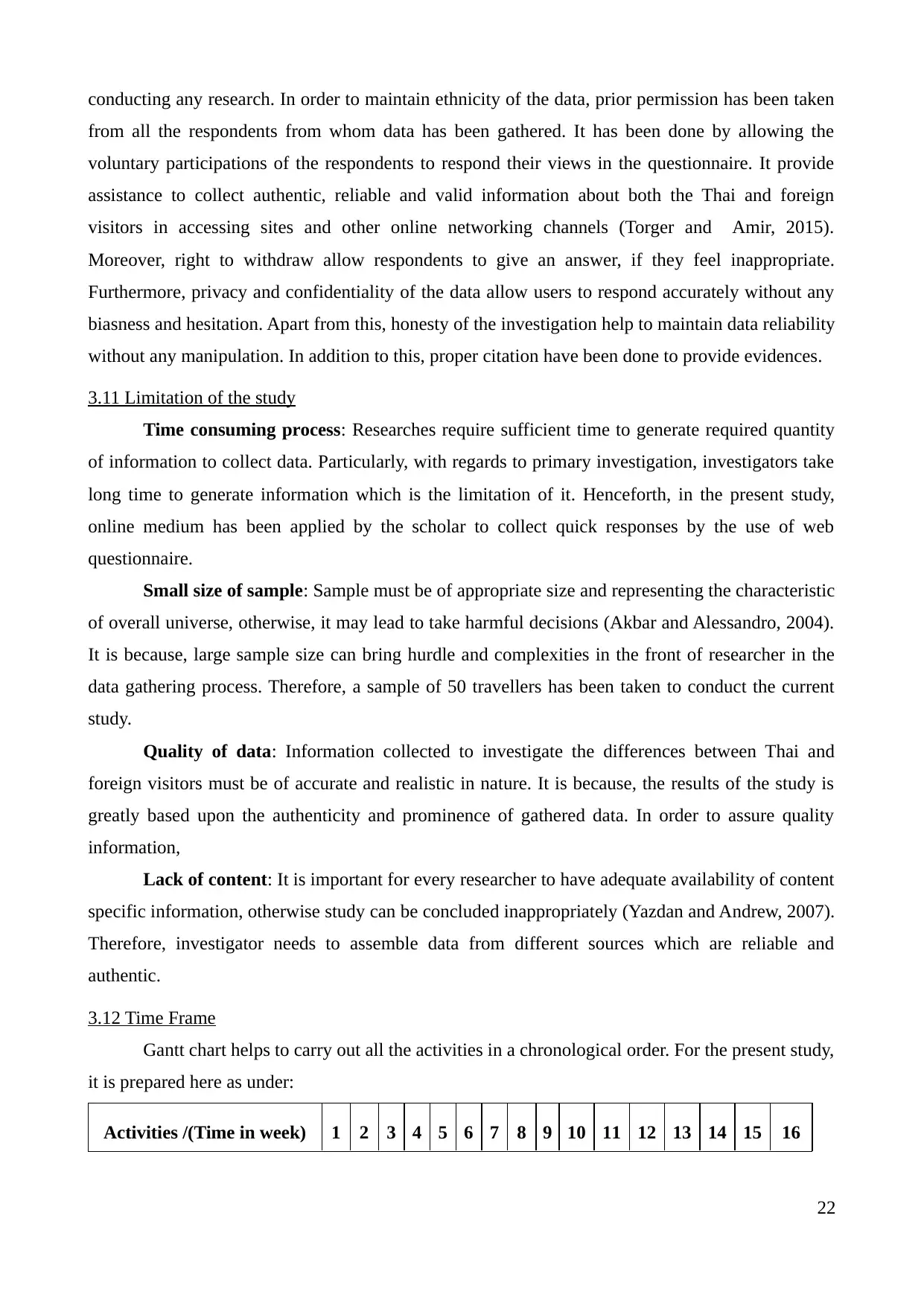
conducting any research. In order to maintain ethnicity of the data, prior permission has been taken
from all the respondents from whom data has been gathered. It has been done by allowing the
voluntary participations of the respondents to respond their views in the questionnaire. It provide
assistance to collect authentic, reliable and valid information about both the Thai and foreign
visitors in accessing sites and other online networking channels (Torger and Amir, 2015).
Moreover, right to withdraw allow respondents to give an answer, if they feel inappropriate.
Furthermore, privacy and confidentiality of the data allow users to respond accurately without any
biasness and hesitation. Apart from this, honesty of the investigation help to maintain data reliability
without any manipulation. In addition to this, proper citation have been done to provide evidences.
3.11 Limitation of the study
Time consuming process: Researches require sufficient time to generate required quantity
of information to collect data. Particularly, with regards to primary investigation, investigators take
long time to generate information which is the limitation of it. Henceforth, in the present study,
online medium has been applied by the scholar to collect quick responses by the use of web
questionnaire.
Small size of sample: Sample must be of appropriate size and representing the characteristic
of overall universe, otherwise, it may lead to take harmful decisions (Akbar and Alessandro, 2004).
It is because, large sample size can bring hurdle and complexities in the front of researcher in the
data gathering process. Therefore, a sample of 50 travellers has been taken to conduct the current
study.
Quality of data: Information collected to investigate the differences between Thai and
foreign visitors must be of accurate and realistic in nature. It is because, the results of the study is
greatly based upon the authenticity and prominence of gathered data. In order to assure quality
information,
Lack of content: It is important for every researcher to have adequate availability of content
specific information, otherwise study can be concluded inappropriately (Yazdan and Andrew, 2007).
Therefore, investigator needs to assemble data from different sources which are reliable and
authentic.
3.12 Time Frame
Gantt chart helps to carry out all the activities in a chronological order. For the present study,
it is prepared here as under:
Activities /(Time in week) 1 2 3 4 5 6 7 8 9 10 11 12 13 14 15 16
22
from all the respondents from whom data has been gathered. It has been done by allowing the
voluntary participations of the respondents to respond their views in the questionnaire. It provide
assistance to collect authentic, reliable and valid information about both the Thai and foreign
visitors in accessing sites and other online networking channels (Torger and Amir, 2015).
Moreover, right to withdraw allow respondents to give an answer, if they feel inappropriate.
Furthermore, privacy and confidentiality of the data allow users to respond accurately without any
biasness and hesitation. Apart from this, honesty of the investigation help to maintain data reliability
without any manipulation. In addition to this, proper citation have been done to provide evidences.
3.11 Limitation of the study
Time consuming process: Researches require sufficient time to generate required quantity
of information to collect data. Particularly, with regards to primary investigation, investigators take
long time to generate information which is the limitation of it. Henceforth, in the present study,
online medium has been applied by the scholar to collect quick responses by the use of web
questionnaire.
Small size of sample: Sample must be of appropriate size and representing the characteristic
of overall universe, otherwise, it may lead to take harmful decisions (Akbar and Alessandro, 2004).
It is because, large sample size can bring hurdle and complexities in the front of researcher in the
data gathering process. Therefore, a sample of 50 travellers has been taken to conduct the current
study.
Quality of data: Information collected to investigate the differences between Thai and
foreign visitors must be of accurate and realistic in nature. It is because, the results of the study is
greatly based upon the authenticity and prominence of gathered data. In order to assure quality
information,
Lack of content: It is important for every researcher to have adequate availability of content
specific information, otherwise study can be concluded inappropriately (Yazdan and Andrew, 2007).
Therefore, investigator needs to assemble data from different sources which are reliable and
authentic.
3.12 Time Frame
Gantt chart helps to carry out all the activities in a chronological order. For the present study,
it is prepared here as under:
Activities /(Time in week) 1 2 3 4 5 6 7 8 9 10 11 12 13 14 15 16
22
Secure Best Marks with AI Grader
Need help grading? Try our AI Grader for instant feedback on your assignments.
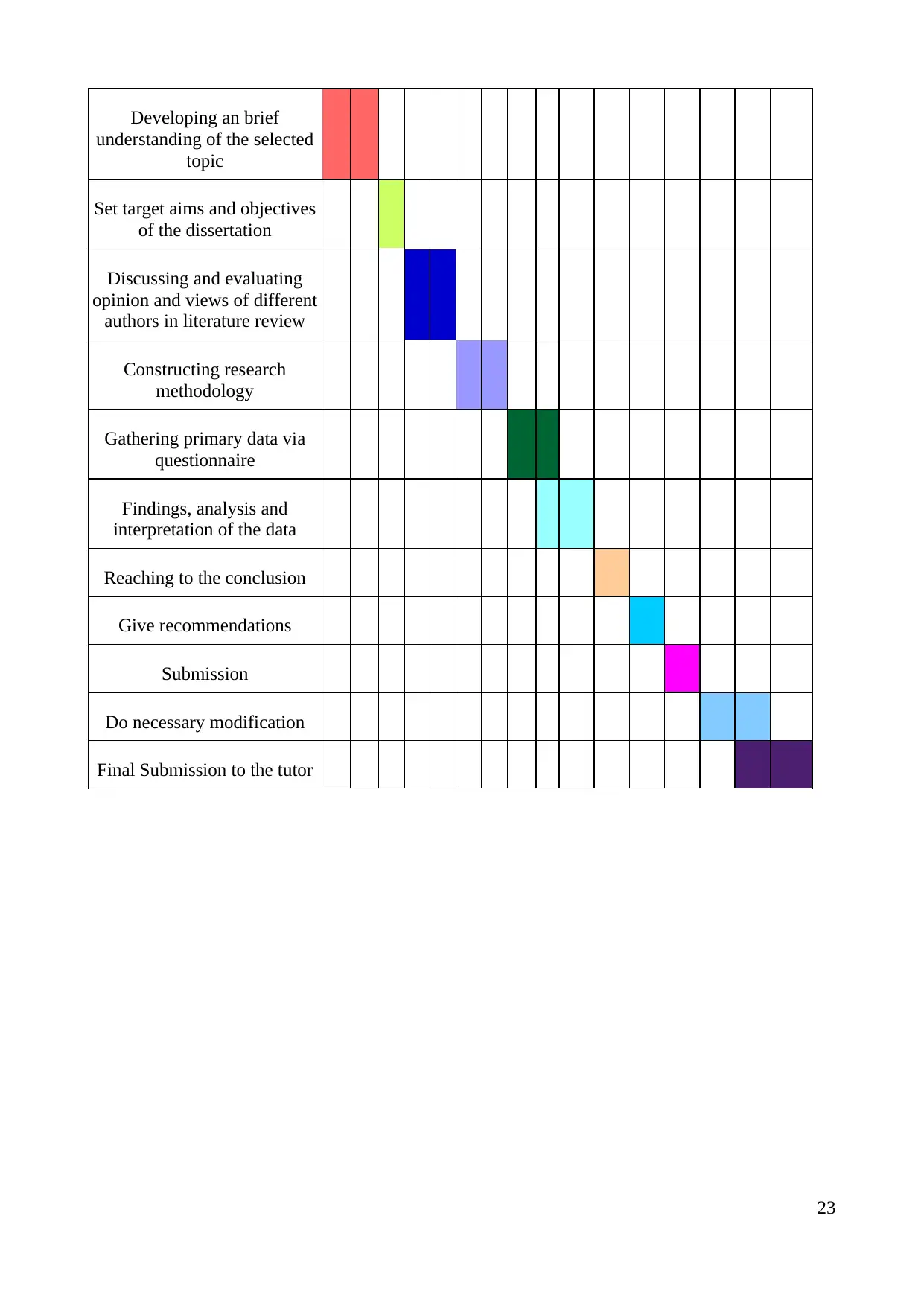
Developing an brief
understanding of the selected
topic
Set target aims and objectives
of the dissertation
Discussing and evaluating
opinion and views of different
authors in literature review
Constructing research
methodology
Gathering primary data via
questionnaire
Findings, analysis and
interpretation of the data
Reaching to the conclusion
Give recommendations
Submission
Do necessary modification
Final Submission to the tutor
23
understanding of the selected
topic
Set target aims and objectives
of the dissertation
Discussing and evaluating
opinion and views of different
authors in literature review
Constructing research
methodology
Gathering primary data via
questionnaire
Findings, analysis and
interpretation of the data
Reaching to the conclusion
Give recommendations
Submission
Do necessary modification
Final Submission to the tutor
23
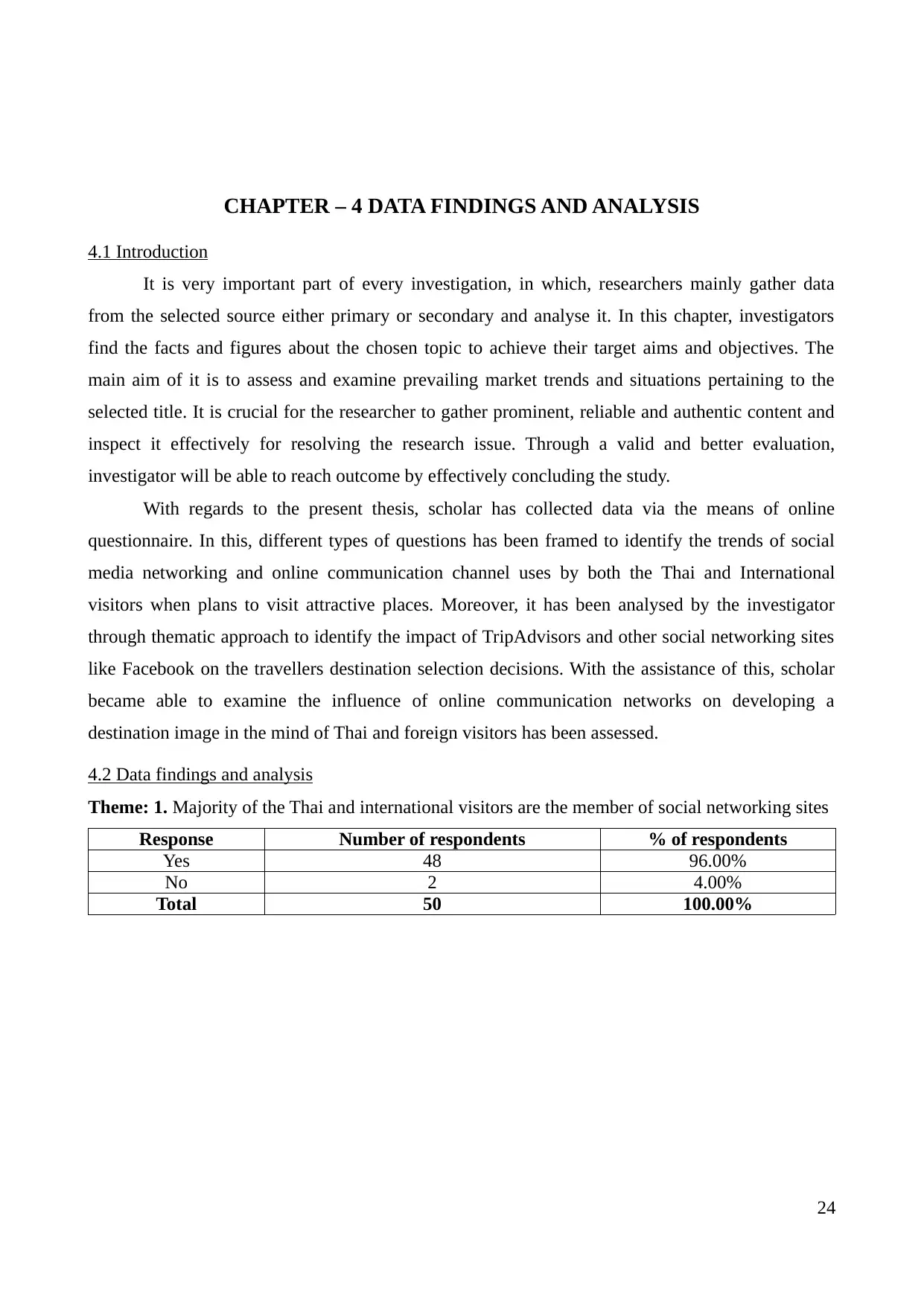
CHAPTER – 4 DATA FINDINGS AND ANALYSIS
4.1 Introduction
It is very important part of every investigation, in which, researchers mainly gather data
from the selected source either primary or secondary and analyse it. In this chapter, investigators
find the facts and figures about the chosen topic to achieve their target aims and objectives. The
main aim of it is to assess and examine prevailing market trends and situations pertaining to the
selected title. It is crucial for the researcher to gather prominent, reliable and authentic content and
inspect it effectively for resolving the research issue. Through a valid and better evaluation,
investigator will be able to reach outcome by effectively concluding the study.
With regards to the present thesis, scholar has collected data via the means of online
questionnaire. In this, different types of questions has been framed to identify the trends of social
media networking and online communication channel uses by both the Thai and International
visitors when plans to visit attractive places. Moreover, it has been analysed by the investigator
through thematic approach to identify the impact of TripAdvisors and other social networking sites
like Facebook on the travellers destination selection decisions. With the assistance of this, scholar
became able to examine the influence of online communication networks on developing a
destination image in the mind of Thai and foreign visitors has been assessed.
4.2 Data findings and analysis
Theme: 1. Majority of the Thai and international visitors are the member of social networking sites
Response Number of respondents % of respondents
Yes 48 96.00%
No 2 4.00%
Total 50 100.00%
24
4.1 Introduction
It is very important part of every investigation, in which, researchers mainly gather data
from the selected source either primary or secondary and analyse it. In this chapter, investigators
find the facts and figures about the chosen topic to achieve their target aims and objectives. The
main aim of it is to assess and examine prevailing market trends and situations pertaining to the
selected title. It is crucial for the researcher to gather prominent, reliable and authentic content and
inspect it effectively for resolving the research issue. Through a valid and better evaluation,
investigator will be able to reach outcome by effectively concluding the study.
With regards to the present thesis, scholar has collected data via the means of online
questionnaire. In this, different types of questions has been framed to identify the trends of social
media networking and online communication channel uses by both the Thai and International
visitors when plans to visit attractive places. Moreover, it has been analysed by the investigator
through thematic approach to identify the impact of TripAdvisors and other social networking sites
like Facebook on the travellers destination selection decisions. With the assistance of this, scholar
became able to examine the influence of online communication networks on developing a
destination image in the mind of Thai and foreign visitors has been assessed.
4.2 Data findings and analysis
Theme: 1. Majority of the Thai and international visitors are the member of social networking sites
Response Number of respondents % of respondents
Yes 48 96.00%
No 2 4.00%
Total 50 100.00%
24
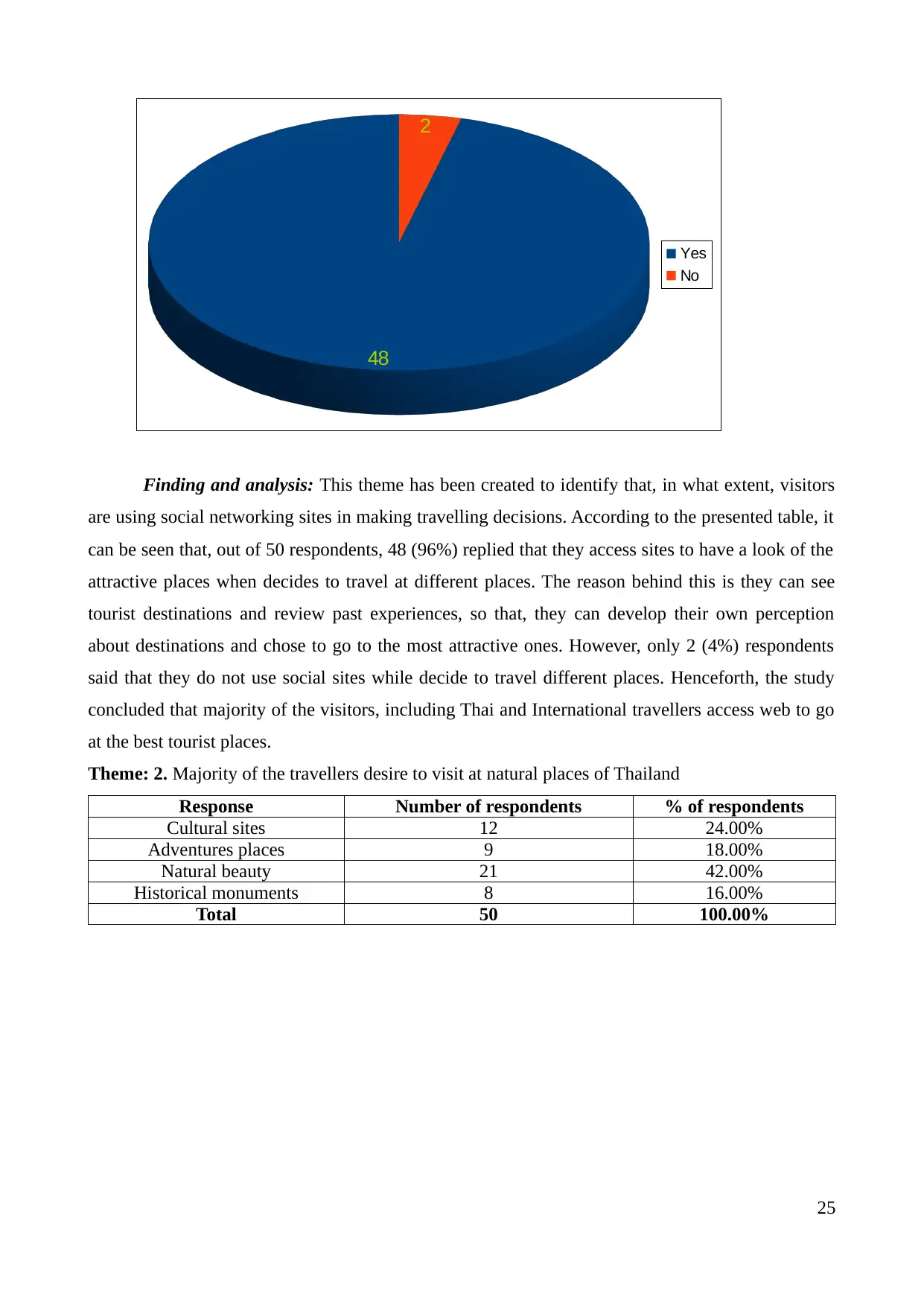
Finding and analysis: This theme has been created to identify that, in what extent, visitors
are using social networking sites in making travelling decisions. According to the presented table, it
can be seen that, out of 50 respondents, 48 (96%) replied that they access sites to have a look of the
attractive places when decides to travel at different places. The reason behind this is they can see
tourist destinations and review past experiences, so that, they can develop their own perception
about destinations and chose to go to the most attractive ones. However, only 2 (4%) respondents
said that they do not use social sites while decide to travel different places. Henceforth, the study
concluded that majority of the visitors, including Thai and International travellers access web to go
at the best tourist places.
Theme: 2. Majority of the travellers desire to visit at natural places of Thailand
Response Number of respondents % of respondents
Cultural sites 12 24.00%
Adventures places 9 18.00%
Natural beauty 21 42.00%
Historical monuments 8 16.00%
Total 50 100.00%
25
48
2
Yes
No
are using social networking sites in making travelling decisions. According to the presented table, it
can be seen that, out of 50 respondents, 48 (96%) replied that they access sites to have a look of the
attractive places when decides to travel at different places. The reason behind this is they can see
tourist destinations and review past experiences, so that, they can develop their own perception
about destinations and chose to go to the most attractive ones. However, only 2 (4%) respondents
said that they do not use social sites while decide to travel different places. Henceforth, the study
concluded that majority of the visitors, including Thai and International travellers access web to go
at the best tourist places.
Theme: 2. Majority of the travellers desire to visit at natural places of Thailand
Response Number of respondents % of respondents
Cultural sites 12 24.00%
Adventures places 9 18.00%
Natural beauty 21 42.00%
Historical monuments 8 16.00%
Total 50 100.00%
25
48
2
Yes
No
Paraphrase This Document
Need a fresh take? Get an instant paraphrase of this document with our AI Paraphraser
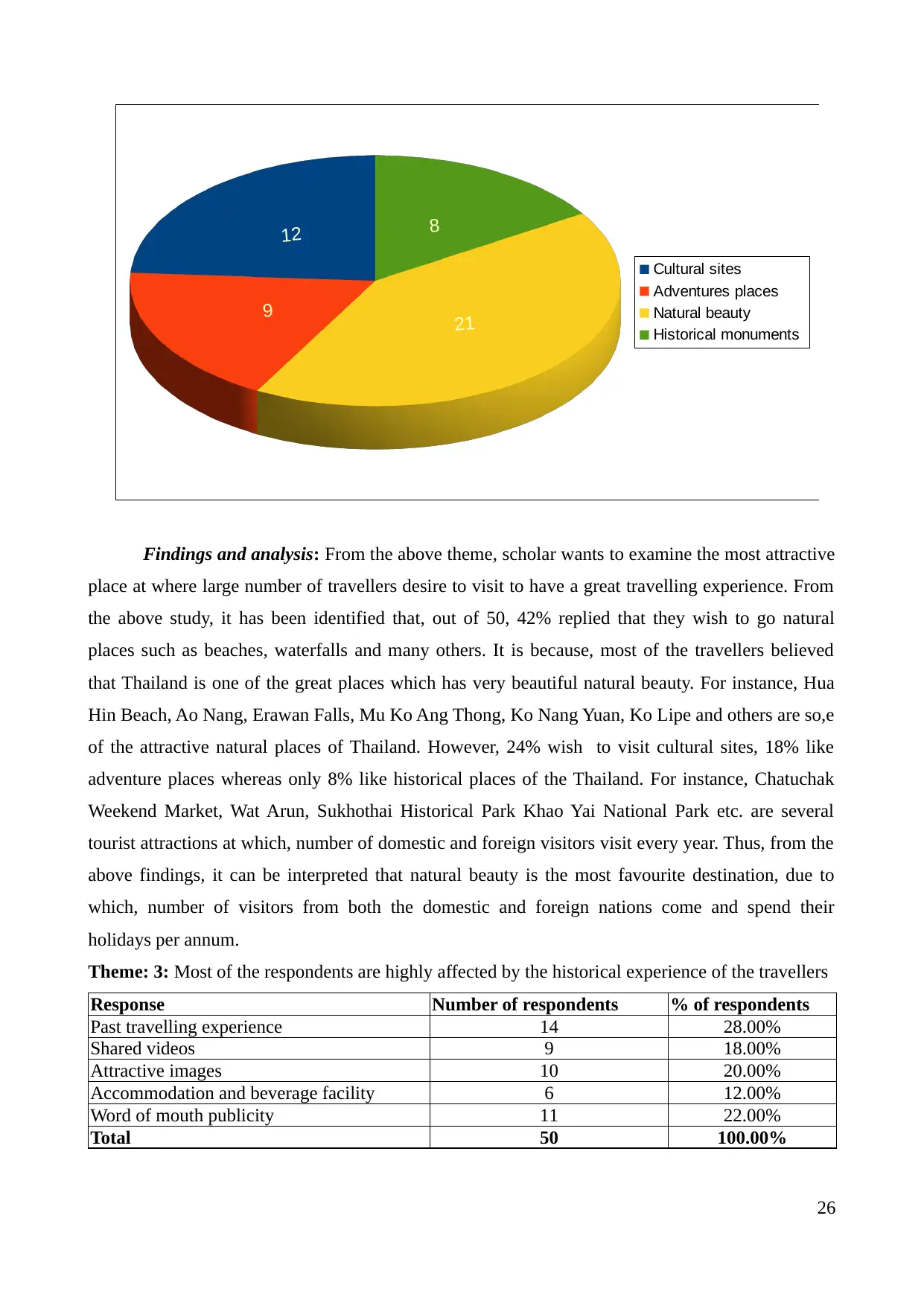
Findings and analysis: From the above theme, scholar wants to examine the most attractive
place at where large number of travellers desire to visit to have a great travelling experience. From
the above study, it has been identified that, out of 50, 42% replied that they wish to go natural
places such as beaches, waterfalls and many others. It is because, most of the travellers believed
that Thailand is one of the great places which has very beautiful natural beauty. For instance, Hua
Hin Beach, Ao Nang, Erawan Falls, Mu Ko Ang Thong, Ko Nang Yuan, Ko Lipe and others are so,e
of the attractive natural places of Thailand. However, 24% wish to visit cultural sites, 18% like
adventure places whereas only 8% like historical places of the Thailand. For instance, Chatuchak
Weekend Market, Wat Arun, Sukhothai Historical Park Khao Yai National Park etc. are several
tourist attractions at which, number of domestic and foreign visitors visit every year. Thus, from the
above findings, it can be interpreted that natural beauty is the most favourite destination, due to
which, number of visitors from both the domestic and foreign nations come and spend their
holidays per annum.
Theme: 3: Most of the respondents are highly affected by the historical experience of the travellers
Response Number of respondents % of respondents
Past travelling experience 14 28.00%
Shared videos 9 18.00%
Attractive images 10 20.00%
Accommodation and beverage facility 6 12.00%
Word of mouth publicity 11 22.00%
Total 50 100.00%
26
12
9
21
8
Cultural sites
Adventures places
Natural beauty
Historical monuments
place at where large number of travellers desire to visit to have a great travelling experience. From
the above study, it has been identified that, out of 50, 42% replied that they wish to go natural
places such as beaches, waterfalls and many others. It is because, most of the travellers believed
that Thailand is one of the great places which has very beautiful natural beauty. For instance, Hua
Hin Beach, Ao Nang, Erawan Falls, Mu Ko Ang Thong, Ko Nang Yuan, Ko Lipe and others are so,e
of the attractive natural places of Thailand. However, 24% wish to visit cultural sites, 18% like
adventure places whereas only 8% like historical places of the Thailand. For instance, Chatuchak
Weekend Market, Wat Arun, Sukhothai Historical Park Khao Yai National Park etc. are several
tourist attractions at which, number of domestic and foreign visitors visit every year. Thus, from the
above findings, it can be interpreted that natural beauty is the most favourite destination, due to
which, number of visitors from both the domestic and foreign nations come and spend their
holidays per annum.
Theme: 3: Most of the respondents are highly affected by the historical experience of the travellers
Response Number of respondents % of respondents
Past travelling experience 14 28.00%
Shared videos 9 18.00%
Attractive images 10 20.00%
Accommodation and beverage facility 6 12.00%
Word of mouth publicity 11 22.00%
Total 50 100.00%
26
12
9
21
8
Cultural sites
Adventures places
Natural beauty
Historical monuments
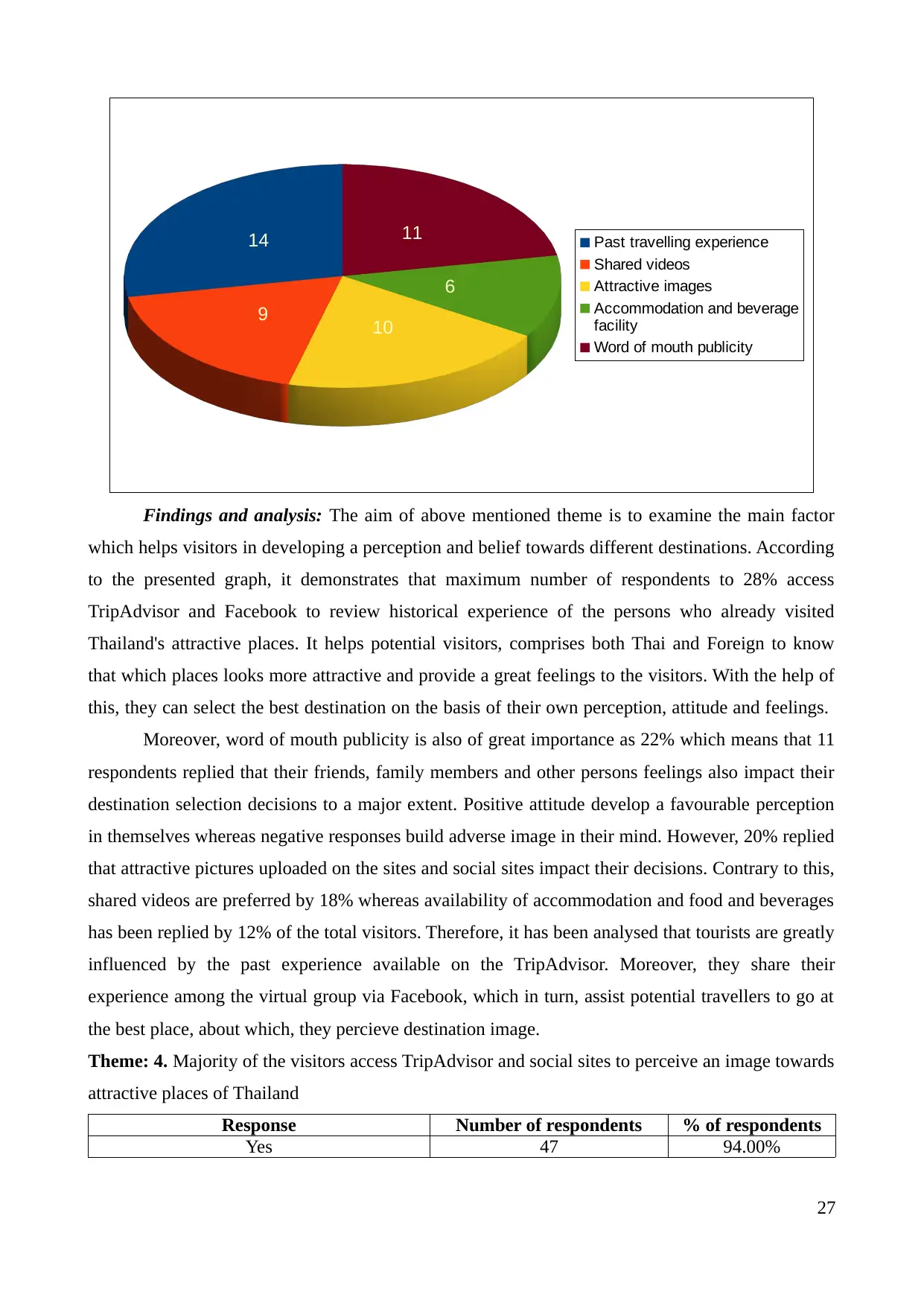
Findings and analysis: The aim of above mentioned theme is to examine the main factor
which helps visitors in developing a perception and belief towards different destinations. According
to the presented graph, it demonstrates that maximum number of respondents to 28% access
TripAdvisor and Facebook to review historical experience of the persons who already visited
Thailand's attractive places. It helps potential visitors, comprises both Thai and Foreign to know
that which places looks more attractive and provide a great feelings to the visitors. With the help of
this, they can select the best destination on the basis of their own perception, attitude and feelings.
Moreover, word of mouth publicity is also of great importance as 22% which means that 11
respondents replied that their friends, family members and other persons feelings also impact their
destination selection decisions to a major extent. Positive attitude develop a favourable perception
in themselves whereas negative responses build adverse image in their mind. However, 20% replied
that attractive pictures uploaded on the sites and social sites impact their decisions. Contrary to this,
shared videos are preferred by 18% whereas availability of accommodation and food and beverages
has been replied by 12% of the total visitors. Therefore, it has been analysed that tourists are greatly
influenced by the past experience available on the TripAdvisor. Moreover, they share their
experience among the virtual group via Facebook, which in turn, assist potential travellers to go at
the best place, about which, they percieve destination image.
Theme: 4. Majority of the visitors access TripAdvisor and social sites to perceive an image towards
attractive places of Thailand
Response Number of respondents % of respondents
Yes 47 94.00%
27
14
9 10
6
11 Past travelling experience
Shared videos
Attractive images
Accommodation and beverage
facility
Word of mouth publicity
which helps visitors in developing a perception and belief towards different destinations. According
to the presented graph, it demonstrates that maximum number of respondents to 28% access
TripAdvisor and Facebook to review historical experience of the persons who already visited
Thailand's attractive places. It helps potential visitors, comprises both Thai and Foreign to know
that which places looks more attractive and provide a great feelings to the visitors. With the help of
this, they can select the best destination on the basis of their own perception, attitude and feelings.
Moreover, word of mouth publicity is also of great importance as 22% which means that 11
respondents replied that their friends, family members and other persons feelings also impact their
destination selection decisions to a major extent. Positive attitude develop a favourable perception
in themselves whereas negative responses build adverse image in their mind. However, 20% replied
that attractive pictures uploaded on the sites and social sites impact their decisions. Contrary to this,
shared videos are preferred by 18% whereas availability of accommodation and food and beverages
has been replied by 12% of the total visitors. Therefore, it has been analysed that tourists are greatly
influenced by the past experience available on the TripAdvisor. Moreover, they share their
experience among the virtual group via Facebook, which in turn, assist potential travellers to go at
the best place, about which, they percieve destination image.
Theme: 4. Majority of the visitors access TripAdvisor and social sites to perceive an image towards
attractive places of Thailand
Response Number of respondents % of respondents
Yes 47 94.00%
27
14
9 10
6
11 Past travelling experience
Shared videos
Attractive images
Accommodation and beverage
facility
Word of mouth publicity
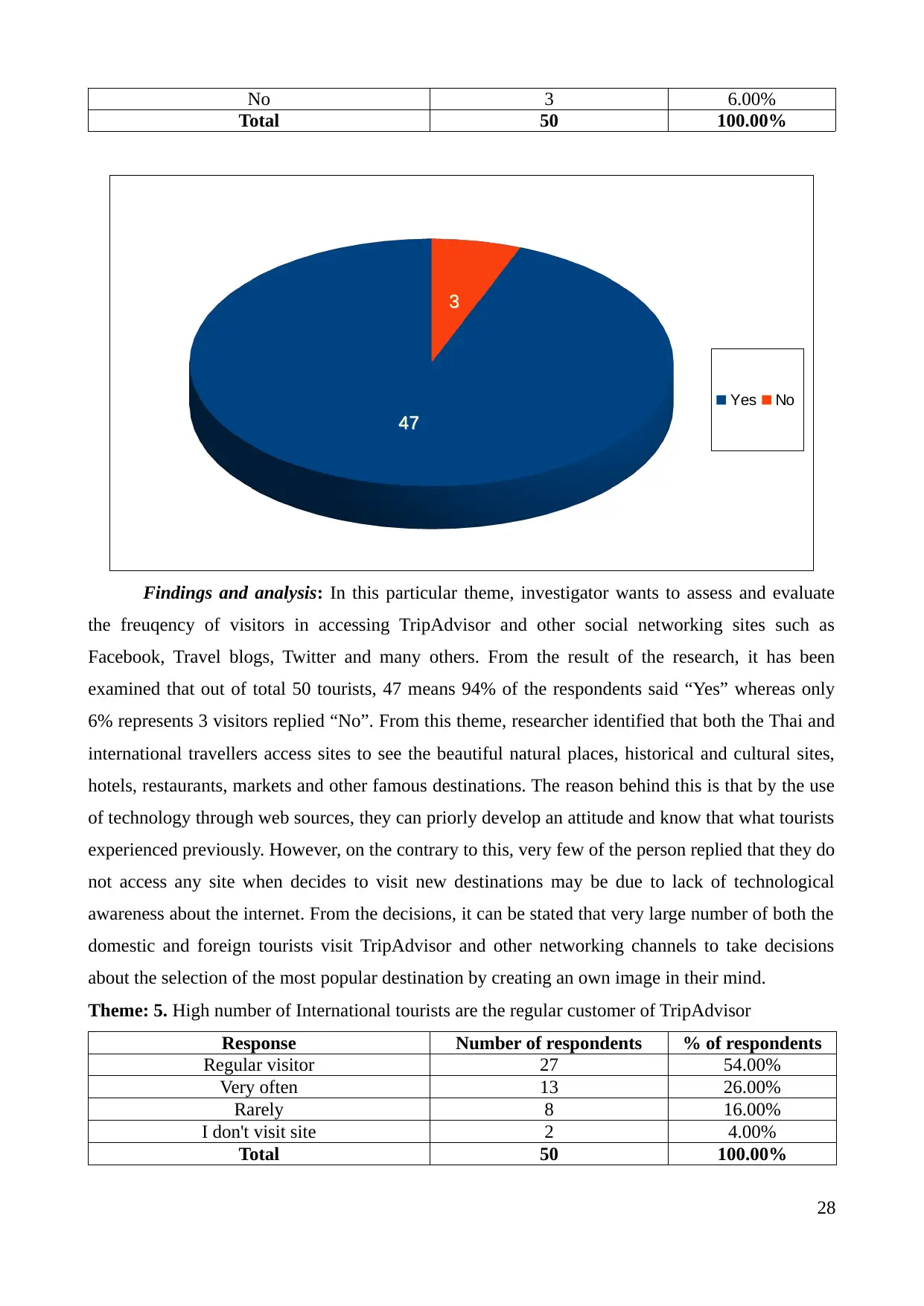
No 3 6.00%
Total 50 100.00%
Findings and analysis: In this particular theme, investigator wants to assess and evaluate
the freuqency of visitors in accessing TripAdvisor and other social networking sites such as
Facebook, Travel blogs, Twitter and many others. From the result of the research, it has been
examined that out of total 50 tourists, 47 means 94% of the respondents said “Yes” whereas only
6% represents 3 visitors replied “No”. From this theme, researcher identified that both the Thai and
international travellers access sites to see the beautiful natural places, historical and cultural sites,
hotels, restaurants, markets and other famous destinations. The reason behind this is that by the use
of technology through web sources, they can priorly develop an attitude and know that what tourists
experienced previously. However, on the contrary to this, very few of the person replied that they do
not access any site when decides to visit new destinations may be due to lack of technological
awareness about the internet. From the decisions, it can be stated that very large number of both the
domestic and foreign tourists visit TripAdvisor and other networking channels to take decisions
about the selection of the most popular destination by creating an own image in their mind.
Theme: 5. High number of International tourists are the regular customer of TripAdvisor
Response Number of respondents % of respondents
Regular visitor 27 54.00%
Very often 13 26.00%
Rarely 8 16.00%
I don't visit site 2 4.00%
Total 50 100.00%
28
4747
33
Yes No
Total 50 100.00%
Findings and analysis: In this particular theme, investigator wants to assess and evaluate
the freuqency of visitors in accessing TripAdvisor and other social networking sites such as
Facebook, Travel blogs, Twitter and many others. From the result of the research, it has been
examined that out of total 50 tourists, 47 means 94% of the respondents said “Yes” whereas only
6% represents 3 visitors replied “No”. From this theme, researcher identified that both the Thai and
international travellers access sites to see the beautiful natural places, historical and cultural sites,
hotels, restaurants, markets and other famous destinations. The reason behind this is that by the use
of technology through web sources, they can priorly develop an attitude and know that what tourists
experienced previously. However, on the contrary to this, very few of the person replied that they do
not access any site when decides to visit new destinations may be due to lack of technological
awareness about the internet. From the decisions, it can be stated that very large number of both the
domestic and foreign tourists visit TripAdvisor and other networking channels to take decisions
about the selection of the most popular destination by creating an own image in their mind.
Theme: 5. High number of International tourists are the regular customer of TripAdvisor
Response Number of respondents % of respondents
Regular visitor 27 54.00%
Very often 13 26.00%
Rarely 8 16.00%
I don't visit site 2 4.00%
Total 50 100.00%
28
4747
33
Yes No
Secure Best Marks with AI Grader
Need help grading? Try our AI Grader for instant feedback on your assignments.
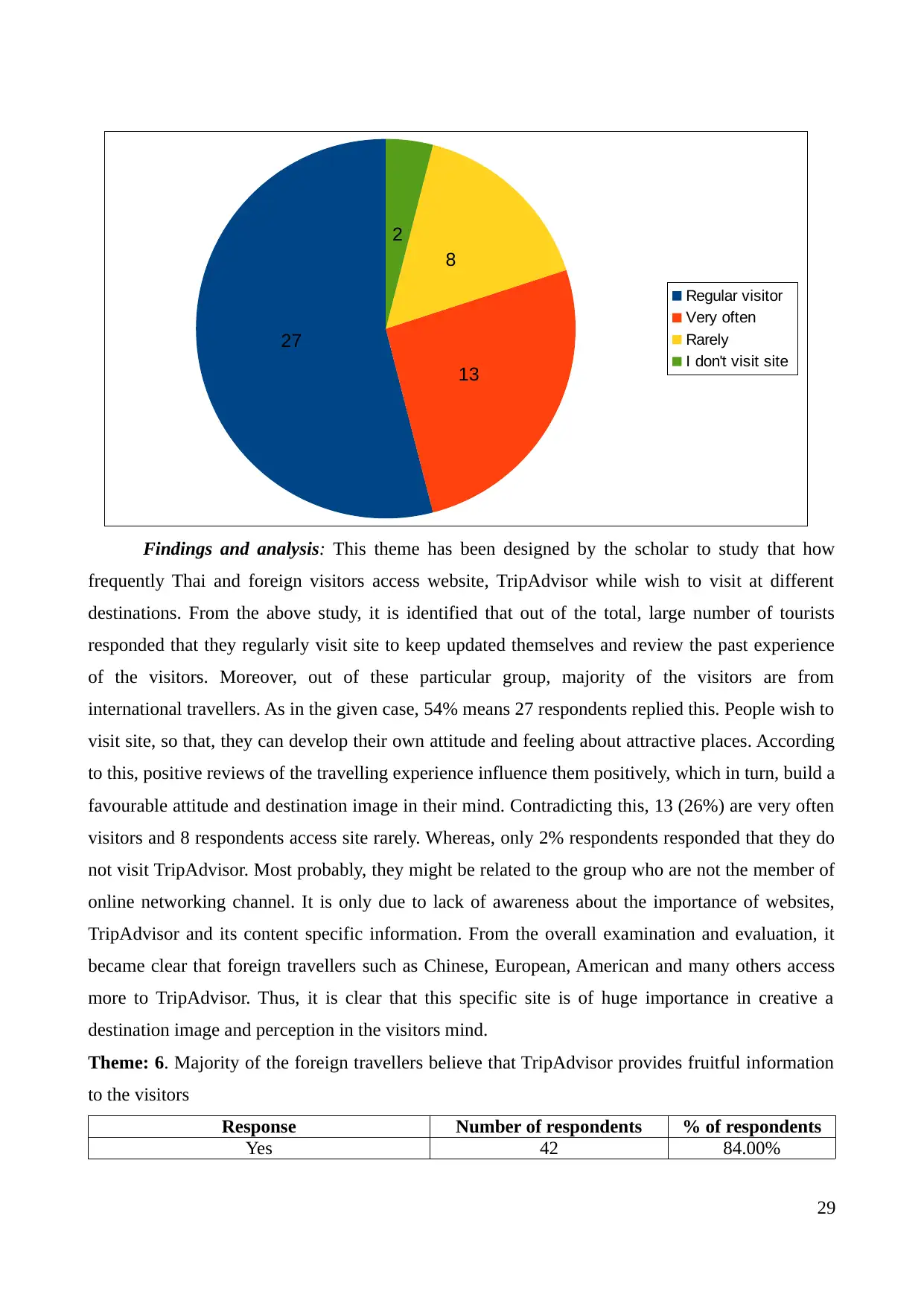
Findings and analysis: This theme has been designed by the scholar to study that how
frequently Thai and foreign visitors access website, TripAdvisor while wish to visit at different
destinations. From the above study, it is identified that out of the total, large number of tourists
responded that they regularly visit site to keep updated themselves and review the past experience
of the visitors. Moreover, out of these particular group, majority of the visitors are from
international travellers. As in the given case, 54% means 27 respondents replied this. People wish to
visit site, so that, they can develop their own attitude and feeling about attractive places. According
to this, positive reviews of the travelling experience influence them positively, which in turn, build a
favourable attitude and destination image in their mind. Contradicting this, 13 (26%) are very often
visitors and 8 respondents access site rarely. Whereas, only 2% respondents responded that they do
not visit TripAdvisor. Most probably, they might be related to the group who are not the member of
online networking channel. It is only due to lack of awareness about the importance of websites,
TripAdvisor and its content specific information. From the overall examination and evaluation, it
became clear that foreign travellers such as Chinese, European, American and many others access
more to TripAdvisor. Thus, it is clear that this specific site is of huge importance in creative a
destination image and perception in the visitors mind.
Theme: 6. Majority of the foreign travellers believe that TripAdvisor provides fruitful information
to the visitors
Response Number of respondents % of respondents
Yes 42 84.00%
29
27
13
8
2
Regular visitor
Very often
Rarely
I don't visit site
frequently Thai and foreign visitors access website, TripAdvisor while wish to visit at different
destinations. From the above study, it is identified that out of the total, large number of tourists
responded that they regularly visit site to keep updated themselves and review the past experience
of the visitors. Moreover, out of these particular group, majority of the visitors are from
international travellers. As in the given case, 54% means 27 respondents replied this. People wish to
visit site, so that, they can develop their own attitude and feeling about attractive places. According
to this, positive reviews of the travelling experience influence them positively, which in turn, build a
favourable attitude and destination image in their mind. Contradicting this, 13 (26%) are very often
visitors and 8 respondents access site rarely. Whereas, only 2% respondents responded that they do
not visit TripAdvisor. Most probably, they might be related to the group who are not the member of
online networking channel. It is only due to lack of awareness about the importance of websites,
TripAdvisor and its content specific information. From the overall examination and evaluation, it
became clear that foreign travellers such as Chinese, European, American and many others access
more to TripAdvisor. Thus, it is clear that this specific site is of huge importance in creative a
destination image and perception in the visitors mind.
Theme: 6. Majority of the foreign travellers believe that TripAdvisor provides fruitful information
to the visitors
Response Number of respondents % of respondents
Yes 42 84.00%
29
27
13
8
2
Regular visitor
Very often
Rarely
I don't visit site
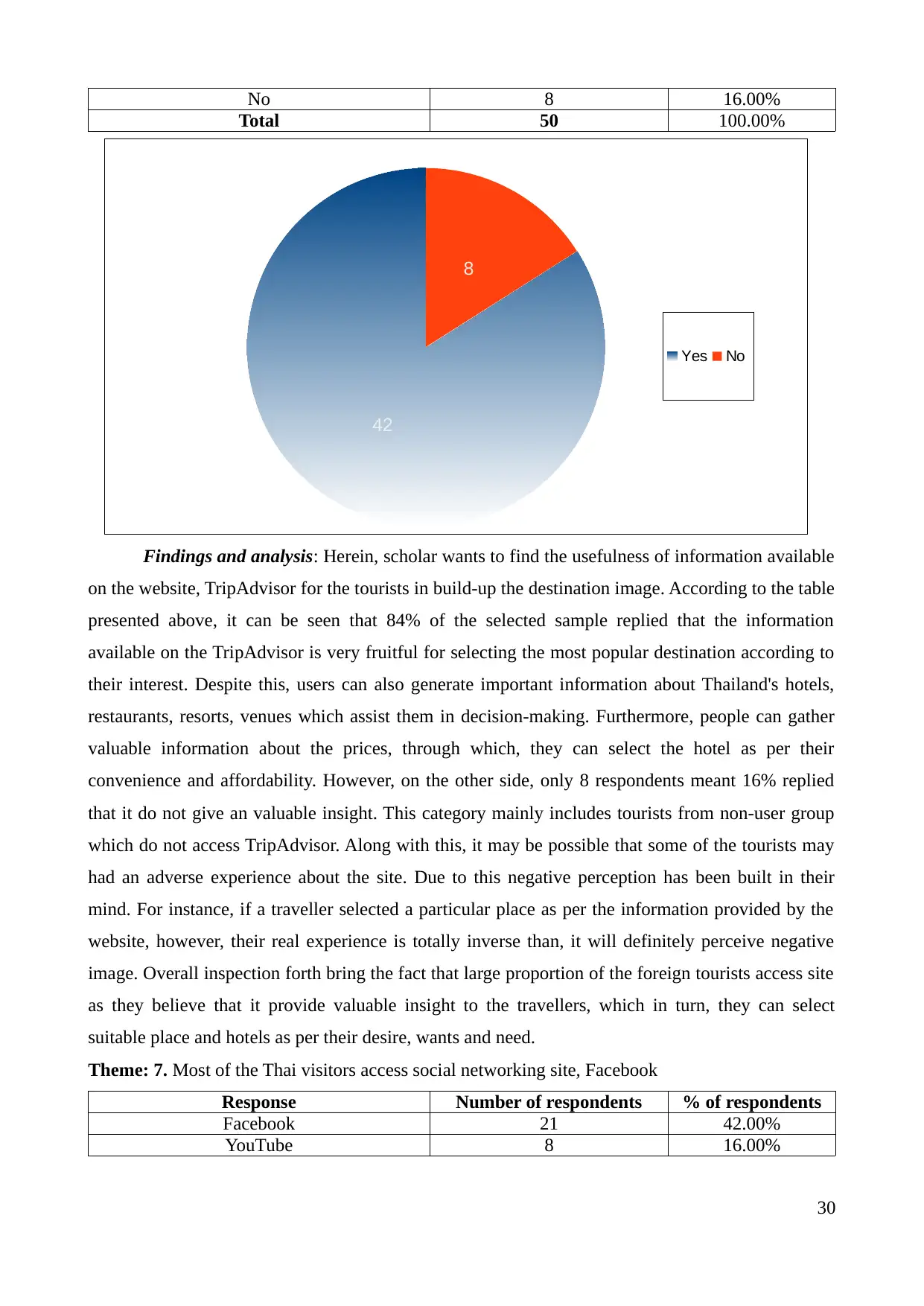
No 8 16.00%
Total 50 100.00%
Findings and analysis: Herein, scholar wants to find the usefulness of information available
on the website, TripAdvisor for the tourists in build-up the destination image. According to the table
presented above, it can be seen that 84% of the selected sample replied that the information
available on the TripAdvisor is very fruitful for selecting the most popular destination according to
their interest. Despite this, users can also generate important information about Thailand's hotels,
restaurants, resorts, venues which assist them in decision-making. Furthermore, people can gather
valuable information about the prices, through which, they can select the hotel as per their
convenience and affordability. However, on the other side, only 8 respondents meant 16% replied
that it do not give an valuable insight. This category mainly includes tourists from non-user group
which do not access TripAdvisor. Along with this, it may be possible that some of the tourists may
had an adverse experience about the site. Due to this negative perception has been built in their
mind. For instance, if a traveller selected a particular place as per the information provided by the
website, however, their real experience is totally inverse than, it will definitely perceive negative
image. Overall inspection forth bring the fact that large proportion of the foreign tourists access site
as they believe that it provide valuable insight to the travellers, which in turn, they can select
suitable place and hotels as per their desire, wants and need.
Theme: 7. Most of the Thai visitors access social networking site, Facebook
Response Number of respondents % of respondents
Facebook 21 42.00%
YouTube 8 16.00%
30
42
8
Yes No
Total 50 100.00%
Findings and analysis: Herein, scholar wants to find the usefulness of information available
on the website, TripAdvisor for the tourists in build-up the destination image. According to the table
presented above, it can be seen that 84% of the selected sample replied that the information
available on the TripAdvisor is very fruitful for selecting the most popular destination according to
their interest. Despite this, users can also generate important information about Thailand's hotels,
restaurants, resorts, venues which assist them in decision-making. Furthermore, people can gather
valuable information about the prices, through which, they can select the hotel as per their
convenience and affordability. However, on the other side, only 8 respondents meant 16% replied
that it do not give an valuable insight. This category mainly includes tourists from non-user group
which do not access TripAdvisor. Along with this, it may be possible that some of the tourists may
had an adverse experience about the site. Due to this negative perception has been built in their
mind. For instance, if a traveller selected a particular place as per the information provided by the
website, however, their real experience is totally inverse than, it will definitely perceive negative
image. Overall inspection forth bring the fact that large proportion of the foreign tourists access site
as they believe that it provide valuable insight to the travellers, which in turn, they can select
suitable place and hotels as per their desire, wants and need.
Theme: 7. Most of the Thai visitors access social networking site, Facebook
Response Number of respondents % of respondents
Facebook 21 42.00%
YouTube 8 16.00%
30
42
8
Yes No
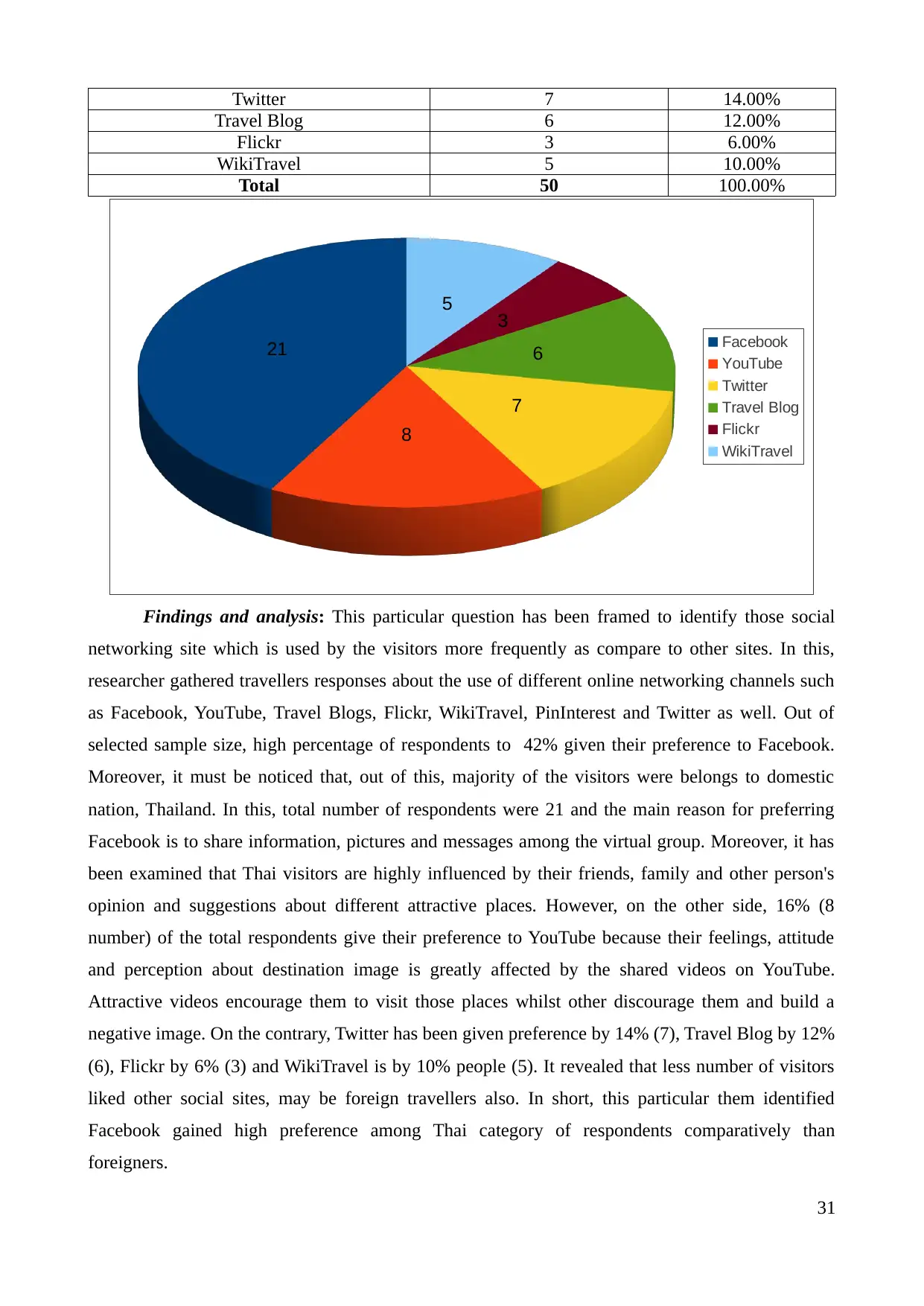
Twitter 7 14.00%
Travel Blog 6 12.00%
Flickr 3 6.00%
WikiTravel 5 10.00%
Total 50 100.00%
Findings and analysis: This particular question has been framed to identify those social
networking site which is used by the visitors more frequently as compare to other sites. In this,
researcher gathered travellers responses about the use of different online networking channels such
as Facebook, YouTube, Travel Blogs, Flickr, WikiTravel, PinInterest and Twitter as well. Out of
selected sample size, high percentage of respondents to 42% given their preference to Facebook.
Moreover, it must be noticed that, out of this, majority of the visitors were belongs to domestic
nation, Thailand. In this, total number of respondents were 21 and the main reason for preferring
Facebook is to share information, pictures and messages among the virtual group. Moreover, it has
been examined that Thai visitors are highly influenced by their friends, family and other person's
opinion and suggestions about different attractive places. However, on the other side, 16% (8
number) of the total respondents give their preference to YouTube because their feelings, attitude
and perception about destination image is greatly affected by the shared videos on YouTube.
Attractive videos encourage them to visit those places whilst other discourage them and build a
negative image. On the contrary, Twitter has been given preference by 14% (7), Travel Blog by 12%
(6), Flickr by 6% (3) and WikiTravel is by 10% people (5). It revealed that less number of visitors
liked other social sites, may be foreign travellers also. In short, this particular them identified
Facebook gained high preference among Thai category of respondents comparatively than
foreigners.
31
21
8
7
6
3
5
Facebook
YouTube
Twitter
Travel Blog
Flickr
WikiTravel
Travel Blog 6 12.00%
Flickr 3 6.00%
WikiTravel 5 10.00%
Total 50 100.00%
Findings and analysis: This particular question has been framed to identify those social
networking site which is used by the visitors more frequently as compare to other sites. In this,
researcher gathered travellers responses about the use of different online networking channels such
as Facebook, YouTube, Travel Blogs, Flickr, WikiTravel, PinInterest and Twitter as well. Out of
selected sample size, high percentage of respondents to 42% given their preference to Facebook.
Moreover, it must be noticed that, out of this, majority of the visitors were belongs to domestic
nation, Thailand. In this, total number of respondents were 21 and the main reason for preferring
Facebook is to share information, pictures and messages among the virtual group. Moreover, it has
been examined that Thai visitors are highly influenced by their friends, family and other person's
opinion and suggestions about different attractive places. However, on the other side, 16% (8
number) of the total respondents give their preference to YouTube because their feelings, attitude
and perception about destination image is greatly affected by the shared videos on YouTube.
Attractive videos encourage them to visit those places whilst other discourage them and build a
negative image. On the contrary, Twitter has been given preference by 14% (7), Travel Blog by 12%
(6), Flickr by 6% (3) and WikiTravel is by 10% people (5). It revealed that less number of visitors
liked other social sites, may be foreign travellers also. In short, this particular them identified
Facebook gained high preference among Thai category of respondents comparatively than
foreigners.
31
21
8
7
6
3
5
YouTube
Travel Blog
Flickr
WikiTravel
Paraphrase This Document
Need a fresh take? Get an instant paraphrase of this document with our AI Paraphraser
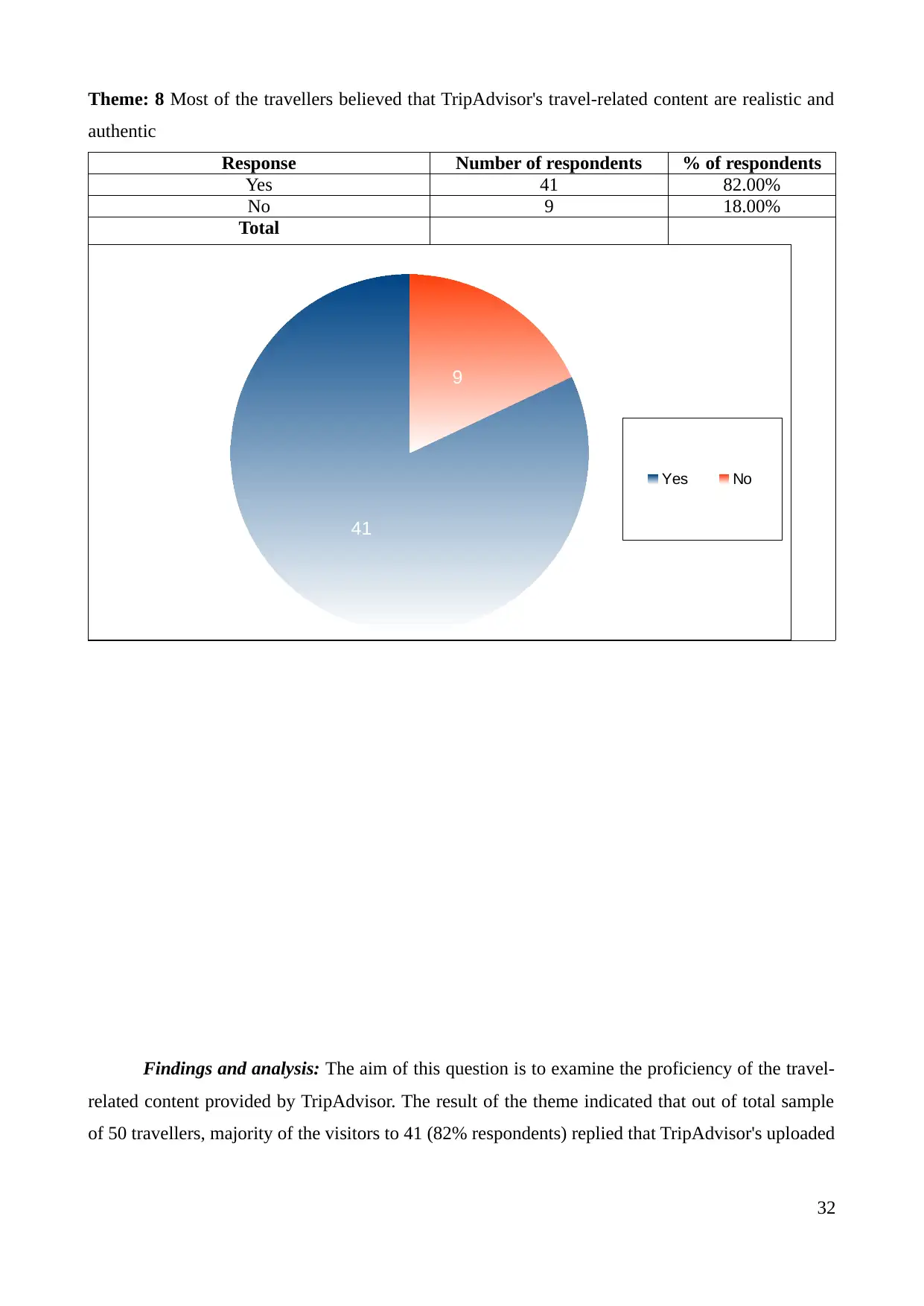
Theme: 8 Most of the travellers believed that TripAdvisor's travel-related content are realistic and
authentic
Response Number of respondents % of respondents
Yes 41 82.00%
No 9 18.00%
Total
50 100.00%
Findings and analysis: The aim of this question is to examine the proficiency of the travel-
related content provided by TripAdvisor. The result of the theme indicated that out of total sample
of 50 travellers, majority of the visitors to 41 (82% respondents) replied that TripAdvisor's uploaded
32
41
9
Yes No
authentic
Response Number of respondents % of respondents
Yes 41 82.00%
No 9 18.00%
Total
50 100.00%
Findings and analysis: The aim of this question is to examine the proficiency of the travel-
related content provided by TripAdvisor. The result of the theme indicated that out of total sample
of 50 travellers, majority of the visitors to 41 (82% respondents) replied that TripAdvisor's uploaded
32
41
9
Yes No
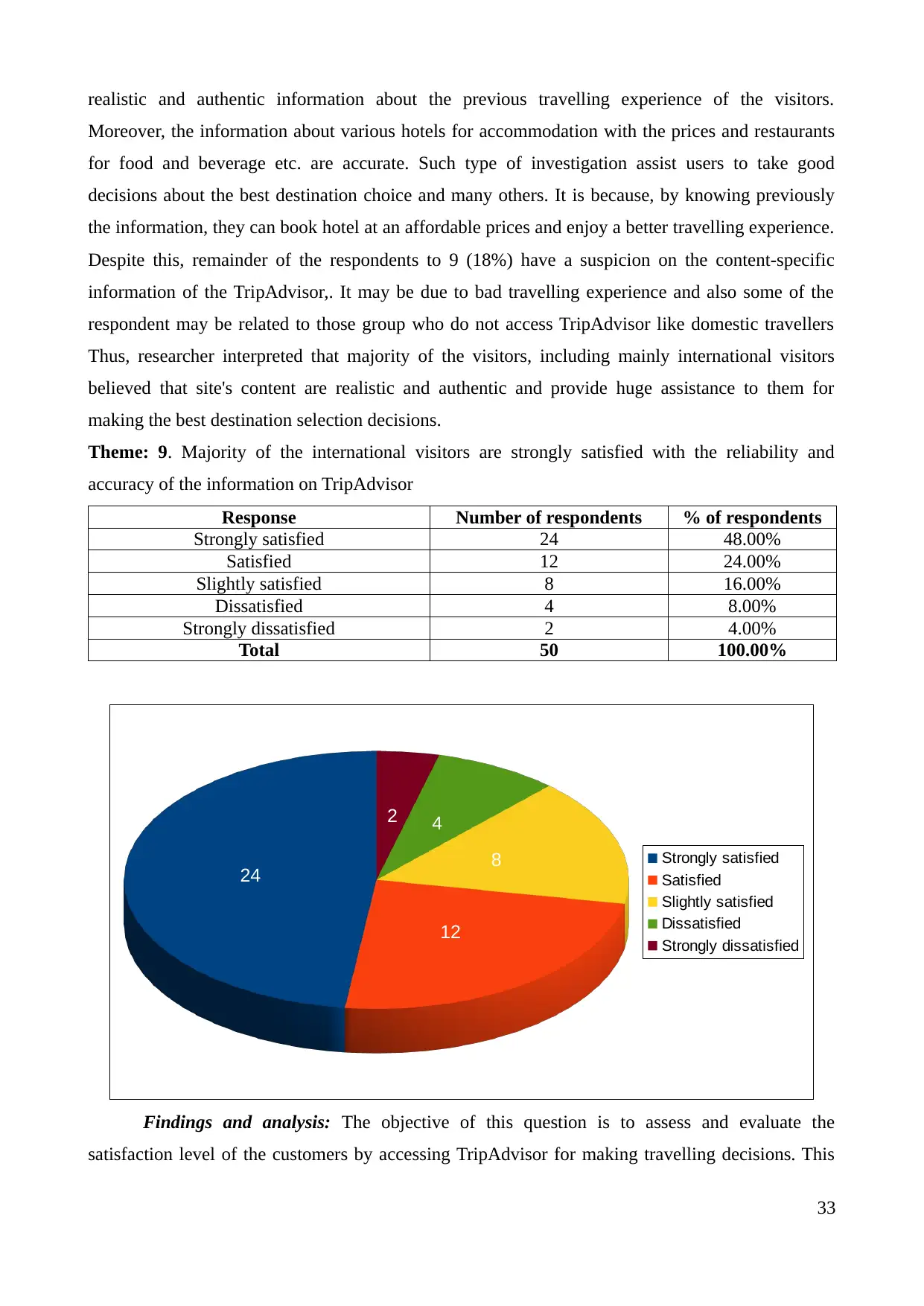
realistic and authentic information about the previous travelling experience of the visitors.
Moreover, the information about various hotels for accommodation with the prices and restaurants
for food and beverage etc. are accurate. Such type of investigation assist users to take good
decisions about the best destination choice and many others. It is because, by knowing previously
the information, they can book hotel at an affordable prices and enjoy a better travelling experience.
Despite this, remainder of the respondents to 9 (18%) have a suspicion on the content-specific
information of the TripAdvisor,. It may be due to bad travelling experience and also some of the
respondent may be related to those group who do not access TripAdvisor like domestic travellers
Thus, researcher interpreted that majority of the visitors, including mainly international visitors
believed that site's content are realistic and authentic and provide huge assistance to them for
making the best destination selection decisions.
Theme: 9. Majority of the international visitors are strongly satisfied with the reliability and
accuracy of the information on TripAdvisor
Response Number of respondents % of respondents
Strongly satisfied 24 48.00%
Satisfied 12 24.00%
Slightly satisfied 8 16.00%
Dissatisfied 4 8.00%
Strongly dissatisfied 2 4.00%
Total 50 100.00%
Findings and analysis: The objective of this question is to assess and evaluate the
satisfaction level of the customers by accessing TripAdvisor for making travelling decisions. This
33
24
12
8
42
Strongly satisfied
Satisfied
Slightly satisfied
Dissatisfied
Strongly dissatisfied
Moreover, the information about various hotels for accommodation with the prices and restaurants
for food and beverage etc. are accurate. Such type of investigation assist users to take good
decisions about the best destination choice and many others. It is because, by knowing previously
the information, they can book hotel at an affordable prices and enjoy a better travelling experience.
Despite this, remainder of the respondents to 9 (18%) have a suspicion on the content-specific
information of the TripAdvisor,. It may be due to bad travelling experience and also some of the
respondent may be related to those group who do not access TripAdvisor like domestic travellers
Thus, researcher interpreted that majority of the visitors, including mainly international visitors
believed that site's content are realistic and authentic and provide huge assistance to them for
making the best destination selection decisions.
Theme: 9. Majority of the international visitors are strongly satisfied with the reliability and
accuracy of the information on TripAdvisor
Response Number of respondents % of respondents
Strongly satisfied 24 48.00%
Satisfied 12 24.00%
Slightly satisfied 8 16.00%
Dissatisfied 4 8.00%
Strongly dissatisfied 2 4.00%
Total 50 100.00%
Findings and analysis: The objective of this question is to assess and evaluate the
satisfaction level of the customers by accessing TripAdvisor for making travelling decisions. This
33
24
12
8
42
Strongly satisfied
Satisfied
Slightly satisfied
Dissatisfied
Strongly dissatisfied
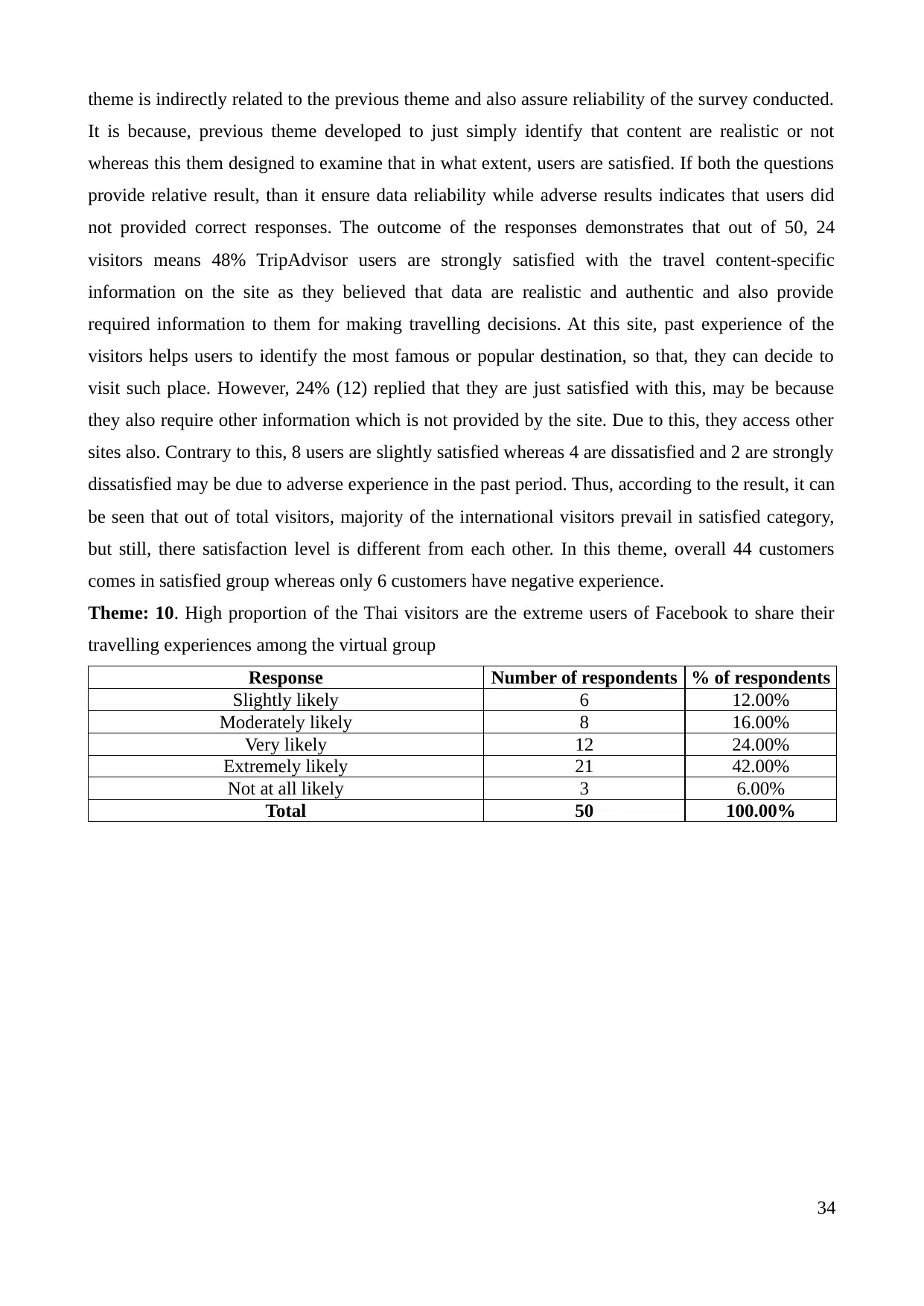
theme is indirectly related to the previous theme and also assure reliability of the survey conducted.
It is because, previous theme developed to just simply identify that content are realistic or not
whereas this them designed to examine that in what extent, users are satisfied. If both the questions
provide relative result, than it ensure data reliability while adverse results indicates that users did
not provided correct responses. The outcome of the responses demonstrates that out of 50, 24
visitors means 48% TripAdvisor users are strongly satisfied with the travel content-specific
information on the site as they believed that data are realistic and authentic and also provide
required information to them for making travelling decisions. At this site, past experience of the
visitors helps users to identify the most famous or popular destination, so that, they can decide to
visit such place. However, 24% (12) replied that they are just satisfied with this, may be because
they also require other information which is not provided by the site. Due to this, they access other
sites also. Contrary to this, 8 users are slightly satisfied whereas 4 are dissatisfied and 2 are strongly
dissatisfied may be due to adverse experience in the past period. Thus, according to the result, it can
be seen that out of total visitors, majority of the international visitors prevail in satisfied category,
but still, there satisfaction level is different from each other. In this theme, overall 44 customers
comes in satisfied group whereas only 6 customers have negative experience.
Theme: 10. High proportion of the Thai visitors are the extreme users of Facebook to share their
travelling experiences among the virtual group
Response Number of respondents % of respondents
Slightly likely 6 12.00%
Moderately likely 8 16.00%
Very likely 12 24.00%
Extremely likely 21 42.00%
Not at all likely 3 6.00%
Total 50 100.00%
34
It is because, previous theme developed to just simply identify that content are realistic or not
whereas this them designed to examine that in what extent, users are satisfied. If both the questions
provide relative result, than it ensure data reliability while adverse results indicates that users did
not provided correct responses. The outcome of the responses demonstrates that out of 50, 24
visitors means 48% TripAdvisor users are strongly satisfied with the travel content-specific
information on the site as they believed that data are realistic and authentic and also provide
required information to them for making travelling decisions. At this site, past experience of the
visitors helps users to identify the most famous or popular destination, so that, they can decide to
visit such place. However, 24% (12) replied that they are just satisfied with this, may be because
they also require other information which is not provided by the site. Due to this, they access other
sites also. Contrary to this, 8 users are slightly satisfied whereas 4 are dissatisfied and 2 are strongly
dissatisfied may be due to adverse experience in the past period. Thus, according to the result, it can
be seen that out of total visitors, majority of the international visitors prevail in satisfied category,
but still, there satisfaction level is different from each other. In this theme, overall 44 customers
comes in satisfied group whereas only 6 customers have negative experience.
Theme: 10. High proportion of the Thai visitors are the extreme users of Facebook to share their
travelling experiences among the virtual group
Response Number of respondents % of respondents
Slightly likely 6 12.00%
Moderately likely 8 16.00%
Very likely 12 24.00%
Extremely likely 21 42.00%
Not at all likely 3 6.00%
Total 50 100.00%
34
Secure Best Marks with AI Grader
Need help grading? Try our AI Grader for instant feedback on your assignments.
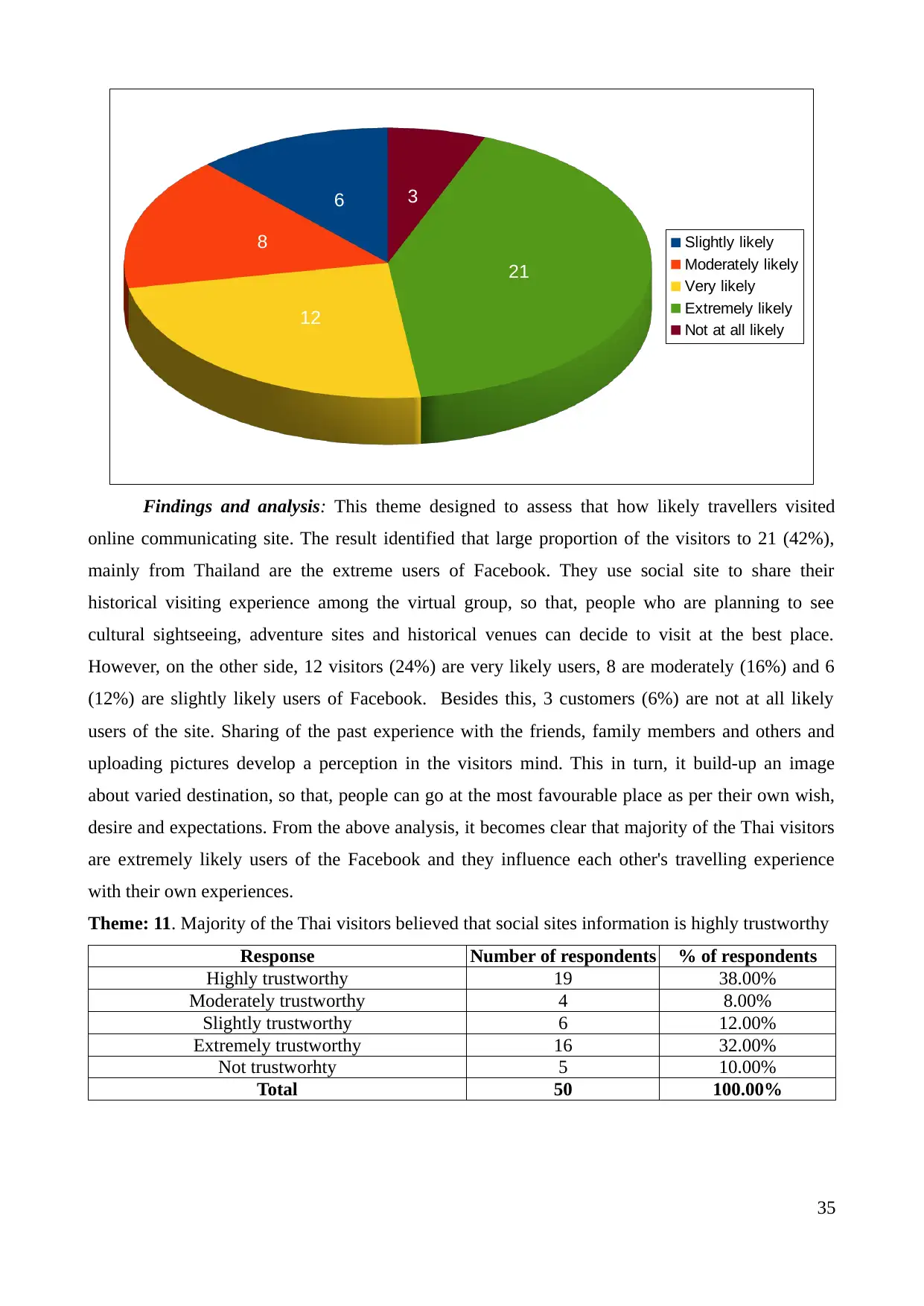
Findings and analysis: This theme designed to assess that how likely travellers visited
online communicating site. The result identified that large proportion of the visitors to 21 (42%),
mainly from Thailand are the extreme users of Facebook. They use social site to share their
historical visiting experience among the virtual group, so that, people who are planning to see
cultural sightseeing, adventure sites and historical venues can decide to visit at the best place.
However, on the other side, 12 visitors (24%) are very likely users, 8 are moderately (16%) and 6
(12%) are slightly likely users of Facebook. Besides this, 3 customers (6%) are not at all likely
users of the site. Sharing of the past experience with the friends, family members and others and
uploading pictures develop a perception in the visitors mind. This in turn, it build-up an image
about varied destination, so that, people can go at the most favourable place as per their own wish,
desire and expectations. From the above analysis, it becomes clear that majority of the Thai visitors
are extremely likely users of the Facebook and they influence each other's travelling experience
with their own experiences.
Theme: 11. Majority of the Thai visitors believed that social sites information is highly trustworthy
Response Number of respondents % of respondents
Highly trustworthy 19 38.00%
Moderately trustworthy 4 8.00%
Slightly trustworthy 6 12.00%
Extremely trustworthy 16 32.00%
Not trustworhty 5 10.00%
Total 50 100.00%
35
6
8
12
21
3
Slightly likely
Moderately likely
Very likely
Extremely likely
Not at all likely
online communicating site. The result identified that large proportion of the visitors to 21 (42%),
mainly from Thailand are the extreme users of Facebook. They use social site to share their
historical visiting experience among the virtual group, so that, people who are planning to see
cultural sightseeing, adventure sites and historical venues can decide to visit at the best place.
However, on the other side, 12 visitors (24%) are very likely users, 8 are moderately (16%) and 6
(12%) are slightly likely users of Facebook. Besides this, 3 customers (6%) are not at all likely
users of the site. Sharing of the past experience with the friends, family members and others and
uploading pictures develop a perception in the visitors mind. This in turn, it build-up an image
about varied destination, so that, people can go at the most favourable place as per their own wish,
desire and expectations. From the above analysis, it becomes clear that majority of the Thai visitors
are extremely likely users of the Facebook and they influence each other's travelling experience
with their own experiences.
Theme: 11. Majority of the Thai visitors believed that social sites information is highly trustworthy
Response Number of respondents % of respondents
Highly trustworthy 19 38.00%
Moderately trustworthy 4 8.00%
Slightly trustworthy 6 12.00%
Extremely trustworthy 16 32.00%
Not trustworhty 5 10.00%
Total 50 100.00%
35
6
8
12
21
3
Slightly likely
Moderately likely
Very likely
Extremely likely
Not at all likely
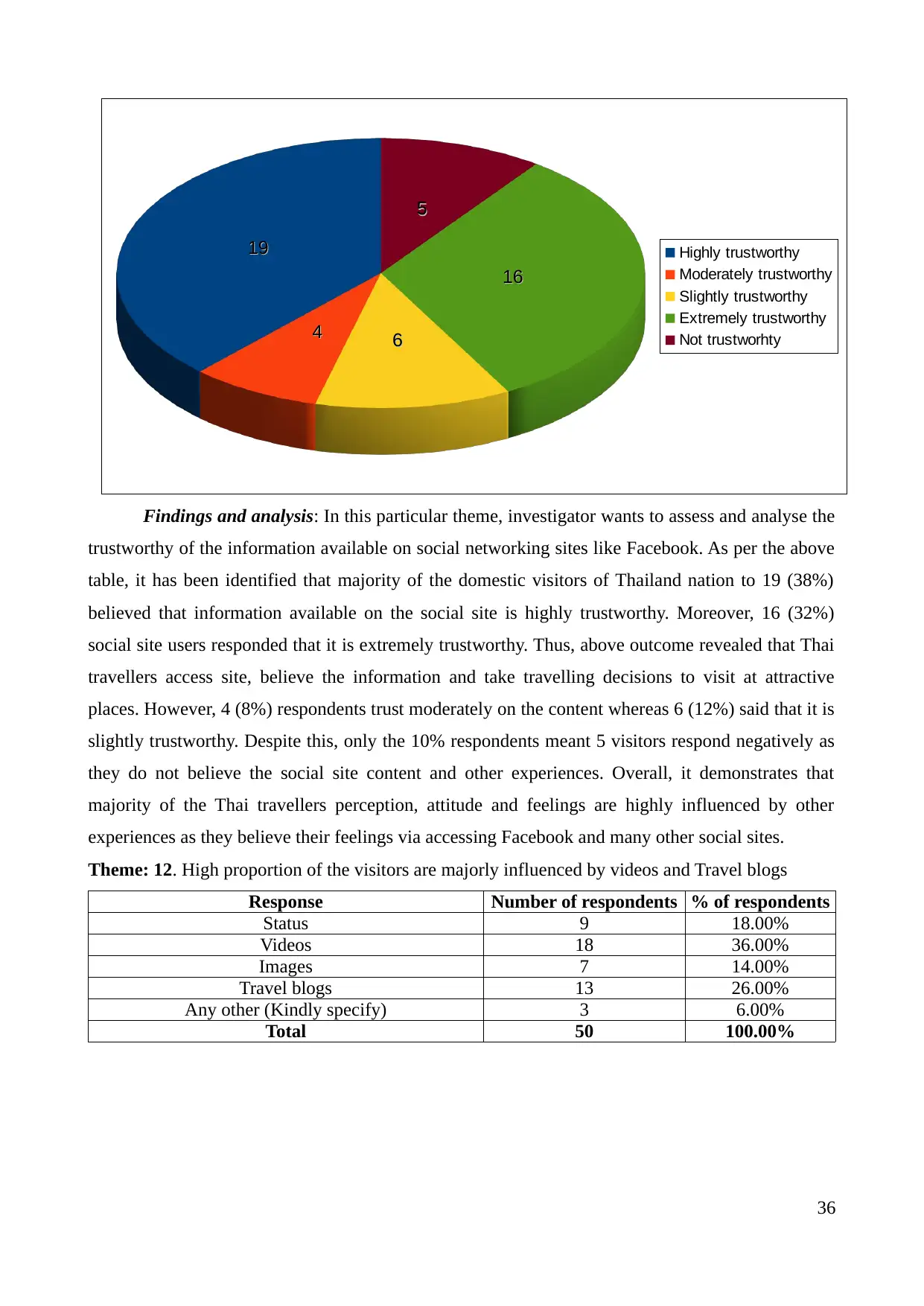
Findings and analysis: In this particular theme, investigator wants to assess and analyse the
trustworthy of the information available on social networking sites like Facebook. As per the above
table, it has been identified that majority of the domestic visitors of Thailand nation to 19 (38%)
believed that information available on the social site is highly trustworthy. Moreover, 16 (32%)
social site users responded that it is extremely trustworthy. Thus, above outcome revealed that Thai
travellers access site, believe the information and take travelling decisions to visit at attractive
places. However, 4 (8%) respondents trust moderately on the content whereas 6 (12%) said that it is
slightly trustworthy. Despite this, only the 10% respondents meant 5 visitors respond negatively as
they do not believe the social site content and other experiences. Overall, it demonstrates that
majority of the Thai travellers perception, attitude and feelings are highly influenced by other
experiences as they believe their feelings via accessing Facebook and many other social sites.
Theme: 12. High proportion of the visitors are majorly influenced by videos and Travel blogs
Response Number of respondents % of respondents
Status 9 18.00%
Videos 18 36.00%
Images 7 14.00%
Travel blogs 13 26.00%
Any other (Kindly specify) 3 6.00%
Total 50 100.00%
36
1919
44 66
1616
55
Highly trustworthy
Moderately trustworthy
Slightly trustworthy
Extremely trustworthy
Not trustworhty
trustworthy of the information available on social networking sites like Facebook. As per the above
table, it has been identified that majority of the domestic visitors of Thailand nation to 19 (38%)
believed that information available on the social site is highly trustworthy. Moreover, 16 (32%)
social site users responded that it is extremely trustworthy. Thus, above outcome revealed that Thai
travellers access site, believe the information and take travelling decisions to visit at attractive
places. However, 4 (8%) respondents trust moderately on the content whereas 6 (12%) said that it is
slightly trustworthy. Despite this, only the 10% respondents meant 5 visitors respond negatively as
they do not believe the social site content and other experiences. Overall, it demonstrates that
majority of the Thai travellers perception, attitude and feelings are highly influenced by other
experiences as they believe their feelings via accessing Facebook and many other social sites.
Theme: 12. High proportion of the visitors are majorly influenced by videos and Travel blogs
Response Number of respondents % of respondents
Status 9 18.00%
Videos 18 36.00%
Images 7 14.00%
Travel blogs 13 26.00%
Any other (Kindly specify) 3 6.00%
Total 50 100.00%
36
1919
44 66
1616
55
Highly trustworthy
Moderately trustworthy
Slightly trustworthy
Extremely trustworthy
Not trustworhty

Findings and analysis: The above graph reflects that majority of the travellers visiting
decisions are greatly affected by the videos uploaded on the social sites, Facebook. As, in the given
case, 18 customers (36%) respondents replied this, attractive videos of the popular destination
provide a better feeling to the visitors to see these places. This in turn, it develop a positive image in
the mind of travellers. Moreover, users are also very much affected by the travel blogs, in the
presented table, 13 (26%) respond that blogs are highly affecting element. On the other hand, Status
is given preference by 9 (18%), images by 7 (14%) and other elements by 3 visitors (6%). In short,
the theme interpreted that both online videos and blogs are of great significance which affect
tourists decisions as they plan to visit at the most attractive site of the Thailand.
Theme: 13. Majority of the respondents access social networking sites to know previous experience
of the travellers
Response Number of respondents % of respondents
To interact people cheaply 7 14.00%
To know past travelling experience of visitors 17 34.00%
To get in touch with friends and family 9 18.00%
To upload images, pictures and videos 5 10.00%
To review tourists perception about attractive places 12 24.00%
Total 50 100.00%
37
9
18 7
13
3
Status
Videos
Images
Travel blogs
Any other (Kindly specify)
decisions are greatly affected by the videos uploaded on the social sites, Facebook. As, in the given
case, 18 customers (36%) respondents replied this, attractive videos of the popular destination
provide a better feeling to the visitors to see these places. This in turn, it develop a positive image in
the mind of travellers. Moreover, users are also very much affected by the travel blogs, in the
presented table, 13 (26%) respond that blogs are highly affecting element. On the other hand, Status
is given preference by 9 (18%), images by 7 (14%) and other elements by 3 visitors (6%). In short,
the theme interpreted that both online videos and blogs are of great significance which affect
tourists decisions as they plan to visit at the most attractive site of the Thailand.
Theme: 13. Majority of the respondents access social networking sites to know previous experience
of the travellers
Response Number of respondents % of respondents
To interact people cheaply 7 14.00%
To know past travelling experience of visitors 17 34.00%
To get in touch with friends and family 9 18.00%
To upload images, pictures and videos 5 10.00%
To review tourists perception about attractive places 12 24.00%
Total 50 100.00%
37
9
18 7
13
3
Status
Videos
Images
Travel blogs
Any other (Kindly specify)
Paraphrase This Document
Need a fresh take? Get an instant paraphrase of this document with our AI Paraphraser
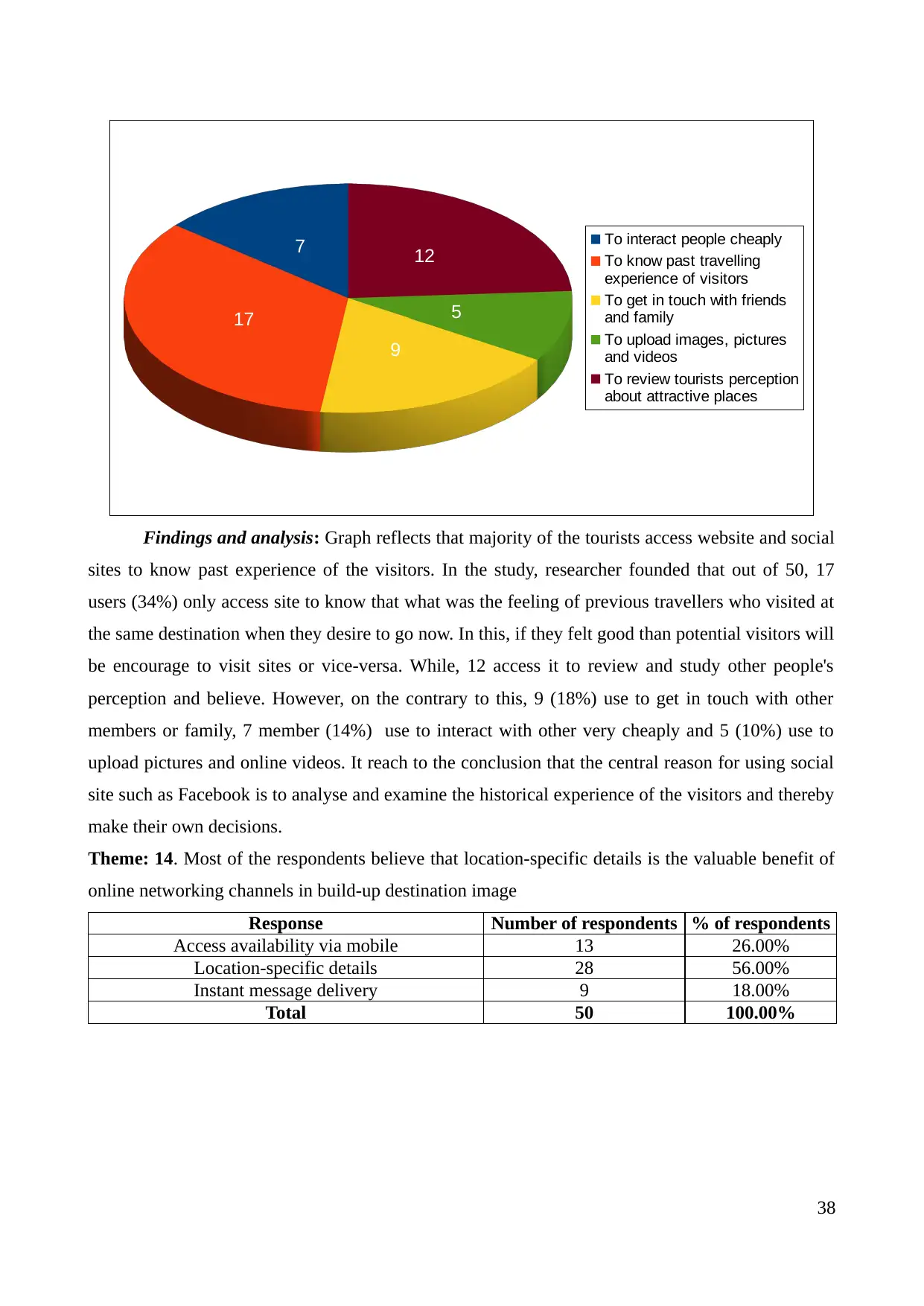
Findings and analysis: Graph reflects that majority of the tourists access website and social
sites to know past experience of the visitors. In the study, researcher founded that out of 50, 17
users (34%) only access site to know that what was the feeling of previous travellers who visited at
the same destination when they desire to go now. In this, if they felt good than potential visitors will
be encourage to visit sites or vice-versa. While, 12 access it to review and study other people's
perception and believe. However, on the contrary to this, 9 (18%) use to get in touch with other
members or family, 7 member (14%) use to interact with other very cheaply and 5 (10%) use to
upload pictures and online videos. It reach to the conclusion that the central reason for using social
site such as Facebook is to analyse and examine the historical experience of the visitors and thereby
make their own decisions.
Theme: 14. Most of the respondents believe that location-specific details is the valuable benefit of
online networking channels in build-up destination image
Response Number of respondents % of respondents
Access availability via mobile 13 26.00%
Location-specific details 28 56.00%
Instant message delivery 9 18.00%
Total 50 100.00%
38
7
17
9
5
12 To interact people cheaply
To know past travelling
experience of visitors
To get in touch with friends
and family
To upload images, pictures
and videos
To review tourists perception
about attractive places
sites to know past experience of the visitors. In the study, researcher founded that out of 50, 17
users (34%) only access site to know that what was the feeling of previous travellers who visited at
the same destination when they desire to go now. In this, if they felt good than potential visitors will
be encourage to visit sites or vice-versa. While, 12 access it to review and study other people's
perception and believe. However, on the contrary to this, 9 (18%) use to get in touch with other
members or family, 7 member (14%) use to interact with other very cheaply and 5 (10%) use to
upload pictures and online videos. It reach to the conclusion that the central reason for using social
site such as Facebook is to analyse and examine the historical experience of the visitors and thereby
make their own decisions.
Theme: 14. Most of the respondents believe that location-specific details is the valuable benefit of
online networking channels in build-up destination image
Response Number of respondents % of respondents
Access availability via mobile 13 26.00%
Location-specific details 28 56.00%
Instant message delivery 9 18.00%
Total 50 100.00%
38
7
17
9
5
12 To interact people cheaply
To know past travelling
experience of visitors
To get in touch with friends
and family
To upload images, pictures
and videos
To review tourists perception
about attractive places
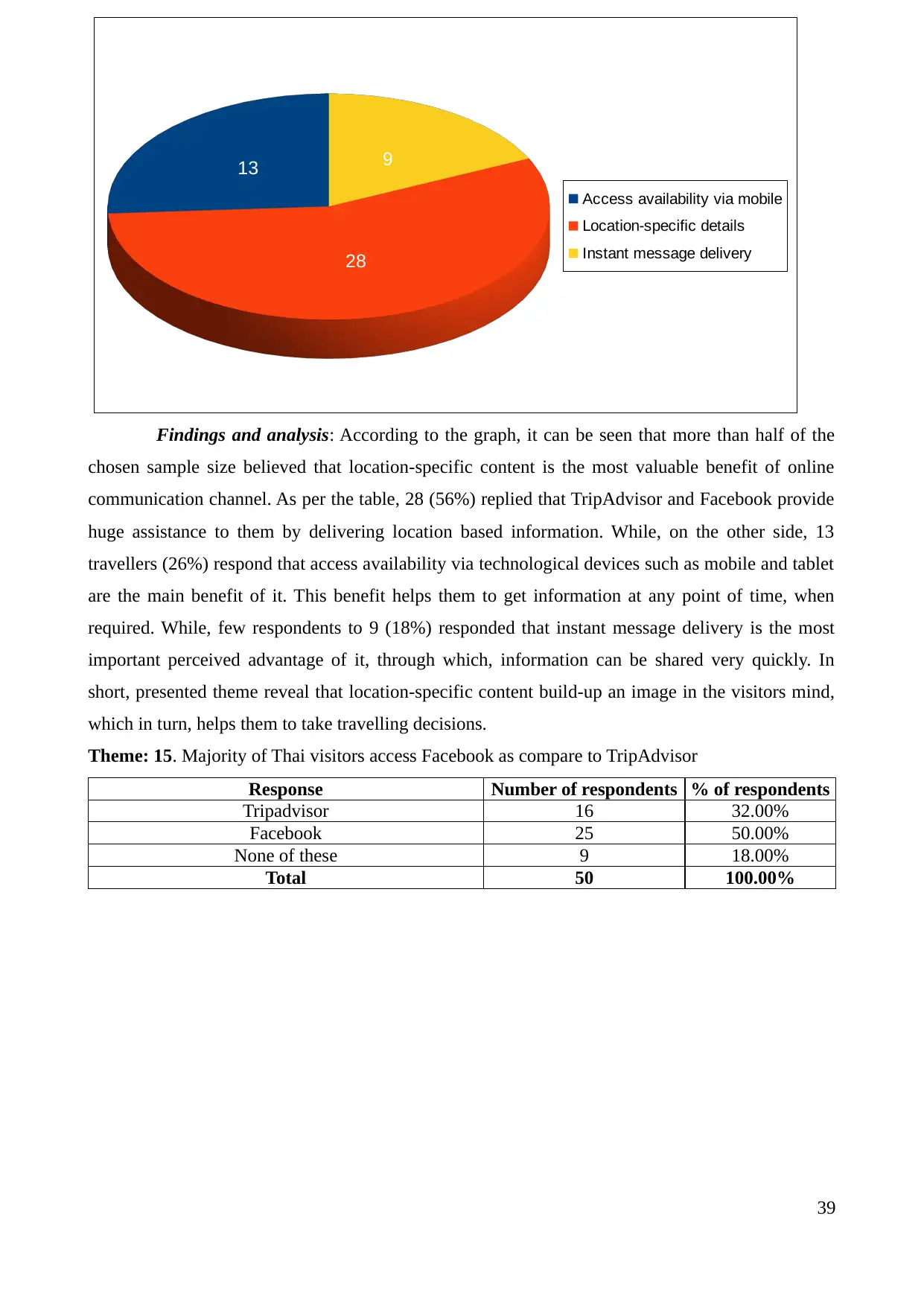
Findings and analysis: According to the graph, it can be seen that more than half of the
chosen sample size believed that location-specific content is the most valuable benefit of online
communication channel. As per the table, 28 (56%) replied that TripAdvisor and Facebook provide
huge assistance to them by delivering location based information. While, on the other side, 13
travellers (26%) respond that access availability via technological devices such as mobile and tablet
are the main benefit of it. This benefit helps them to get information at any point of time, when
required. While, few respondents to 9 (18%) responded that instant message delivery is the most
important perceived advantage of it, through which, information can be shared very quickly. In
short, presented theme reveal that location-specific content build-up an image in the visitors mind,
which in turn, helps them to take travelling decisions.
Theme: 15. Majority of Thai visitors access Facebook as compare to TripAdvisor
Response Number of respondents % of respondents
Tripadvisor 16 32.00%
Facebook 25 50.00%
None of these 9 18.00%
Total 50 100.00%
39
13
28
9
Access availability via mobile
Location-specific details
Instant message delivery
chosen sample size believed that location-specific content is the most valuable benefit of online
communication channel. As per the table, 28 (56%) replied that TripAdvisor and Facebook provide
huge assistance to them by delivering location based information. While, on the other side, 13
travellers (26%) respond that access availability via technological devices such as mobile and tablet
are the main benefit of it. This benefit helps them to get information at any point of time, when
required. While, few respondents to 9 (18%) responded that instant message delivery is the most
important perceived advantage of it, through which, information can be shared very quickly. In
short, presented theme reveal that location-specific content build-up an image in the visitors mind,
which in turn, helps them to take travelling decisions.
Theme: 15. Majority of Thai visitors access Facebook as compare to TripAdvisor
Response Number of respondents % of respondents
Tripadvisor 16 32.00%
Facebook 25 50.00%
None of these 9 18.00%
Total 50 100.00%
39
13
28
9
Access availability via mobile
Location-specific details
Instant message delivery
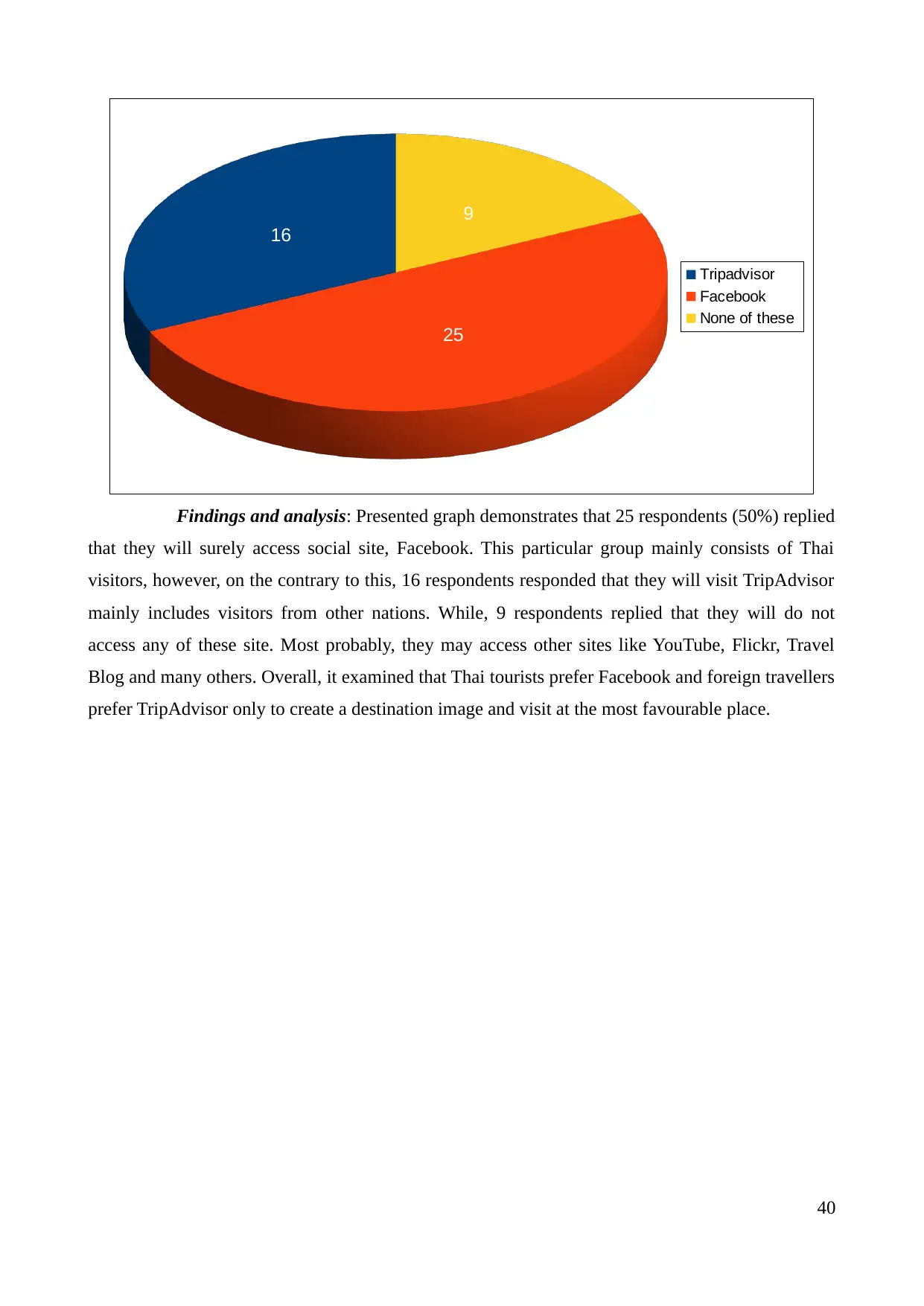
Findings and analysis: Presented graph demonstrates that 25 respondents (50%) replied
that they will surely access social site, Facebook. This particular group mainly consists of Thai
visitors, however, on the contrary to this, 16 respondents responded that they will visit TripAdvisor
mainly includes visitors from other nations. While, 9 respondents replied that they will do not
access any of these site. Most probably, they may access other sites like YouTube, Flickr, Travel
Blog and many others. Overall, it examined that Thai tourists prefer Facebook and foreign travellers
prefer TripAdvisor only to create a destination image and visit at the most favourable place.
40
16
25
9
Tripadvisor
Facebook
None of these
that they will surely access social site, Facebook. This particular group mainly consists of Thai
visitors, however, on the contrary to this, 16 respondents responded that they will visit TripAdvisor
mainly includes visitors from other nations. While, 9 respondents replied that they will do not
access any of these site. Most probably, they may access other sites like YouTube, Flickr, Travel
Blog and many others. Overall, it examined that Thai tourists prefer Facebook and foreign travellers
prefer TripAdvisor only to create a destination image and visit at the most favourable place.
40
16
25
9
Tripadvisor
None of these
Secure Best Marks with AI Grader
Need help grading? Try our AI Grader for instant feedback on your assignments.
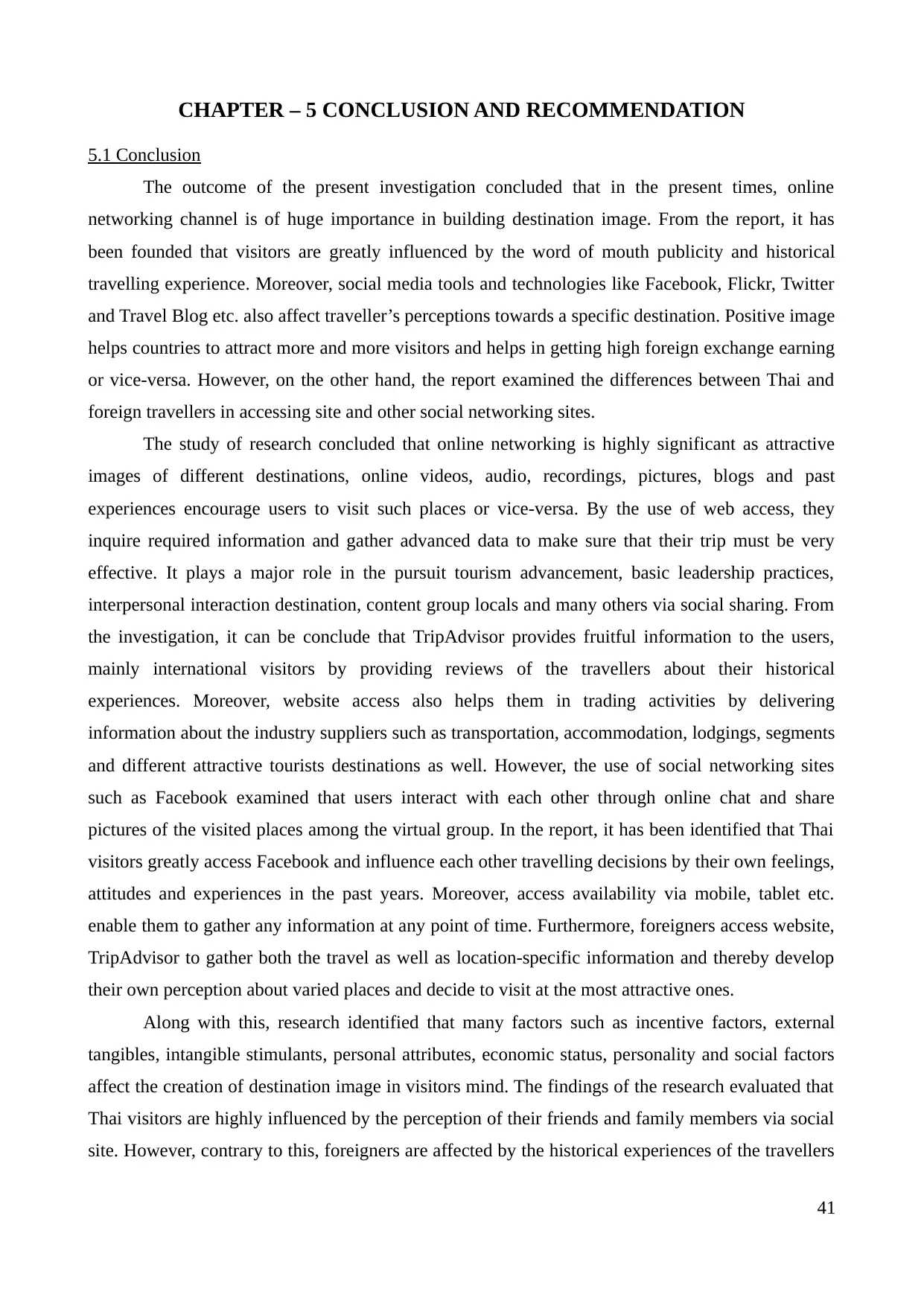
CHAPTER – 5 CONCLUSION AND RECOMMENDATION
5.1 Conclusion
The outcome of the present investigation concluded that in the present times, online
networking channel is of huge importance in building destination image. From the report, it has
been founded that visitors are greatly influenced by the word of mouth publicity and historical
travelling experience. Moreover, social media tools and technologies like Facebook, Flickr, Twitter
and Travel Blog etc. also affect traveller’s perceptions towards a specific destination. Positive image
helps countries to attract more and more visitors and helps in getting high foreign exchange earning
or vice-versa. However, on the other hand, the report examined the differences between Thai and
foreign travellers in accessing site and other social networking sites.
The study of research concluded that online networking is highly significant as attractive
images of different destinations, online videos, audio, recordings, pictures, blogs and past
experiences encourage users to visit such places or vice-versa. By the use of web access, they
inquire required information and gather advanced data to make sure that their trip must be very
effective. It plays a major role in the pursuit tourism advancement, basic leadership practices,
interpersonal interaction destination, content group locals and many others via social sharing. From
the investigation, it can be conclude that TripAdvisor provides fruitful information to the users,
mainly international visitors by providing reviews of the travellers about their historical
experiences. Moreover, website access also helps them in trading activities by delivering
information about the industry suppliers such as transportation, accommodation, lodgings, segments
and different attractive tourists destinations as well. However, the use of social networking sites
such as Facebook examined that users interact with each other through online chat and share
pictures of the visited places among the virtual group. In the report, it has been identified that Thai
visitors greatly access Facebook and influence each other travelling decisions by their own feelings,
attitudes and experiences in the past years. Moreover, access availability via mobile, tablet etc.
enable them to gather any information at any point of time. Furthermore, foreigners access website,
TripAdvisor to gather both the travel as well as location-specific information and thereby develop
their own perception about varied places and decide to visit at the most attractive ones.
Along with this, research identified that many factors such as incentive factors, external
tangibles, intangible stimulants, personal attributes, economic status, personality and social factors
affect the creation of destination image in visitors mind. The findings of the research evaluated that
Thai visitors are highly influenced by the perception of their friends and family members via social
site. However, contrary to this, foreigners are affected by the historical experiences of the travellers
41
5.1 Conclusion
The outcome of the present investigation concluded that in the present times, online
networking channel is of huge importance in building destination image. From the report, it has
been founded that visitors are greatly influenced by the word of mouth publicity and historical
travelling experience. Moreover, social media tools and technologies like Facebook, Flickr, Twitter
and Travel Blog etc. also affect traveller’s perceptions towards a specific destination. Positive image
helps countries to attract more and more visitors and helps in getting high foreign exchange earning
or vice-versa. However, on the other hand, the report examined the differences between Thai and
foreign travellers in accessing site and other social networking sites.
The study of research concluded that online networking is highly significant as attractive
images of different destinations, online videos, audio, recordings, pictures, blogs and past
experiences encourage users to visit such places or vice-versa. By the use of web access, they
inquire required information and gather advanced data to make sure that their trip must be very
effective. It plays a major role in the pursuit tourism advancement, basic leadership practices,
interpersonal interaction destination, content group locals and many others via social sharing. From
the investigation, it can be conclude that TripAdvisor provides fruitful information to the users,
mainly international visitors by providing reviews of the travellers about their historical
experiences. Moreover, website access also helps them in trading activities by delivering
information about the industry suppliers such as transportation, accommodation, lodgings, segments
and different attractive tourists destinations as well. However, the use of social networking sites
such as Facebook examined that users interact with each other through online chat and share
pictures of the visited places among the virtual group. In the report, it has been identified that Thai
visitors greatly access Facebook and influence each other travelling decisions by their own feelings,
attitudes and experiences in the past years. Moreover, access availability via mobile, tablet etc.
enable them to gather any information at any point of time. Furthermore, foreigners access website,
TripAdvisor to gather both the travel as well as location-specific information and thereby develop
their own perception about varied places and decide to visit at the most attractive ones.
Along with this, research identified that many factors such as incentive factors, external
tangibles, intangible stimulants, personal attributes, economic status, personality and social factors
affect the creation of destination image in visitors mind. The findings of the research evaluated that
Thai visitors are highly influenced by the perception of their friends and family members via social
site. However, contrary to this, foreigners are affected by the historical experiences of the travellers
41
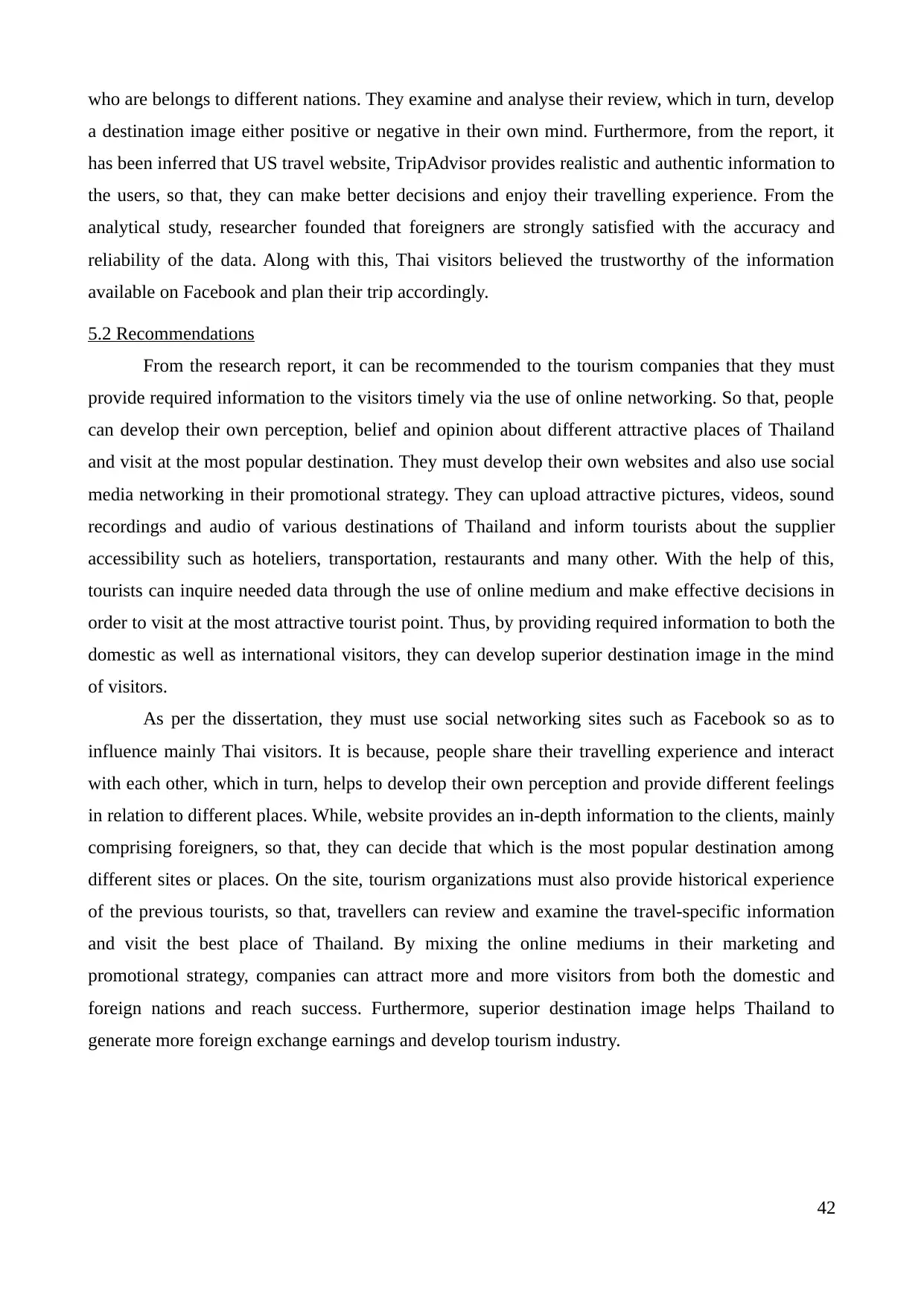
who are belongs to different nations. They examine and analyse their review, which in turn, develop
a destination image either positive or negative in their own mind. Furthermore, from the report, it
has been inferred that US travel website, TripAdvisor provides realistic and authentic information to
the users, so that, they can make better decisions and enjoy their travelling experience. From the
analytical study, researcher founded that foreigners are strongly satisfied with the accuracy and
reliability of the data. Along with this, Thai visitors believed the trustworthy of the information
available on Facebook and plan their trip accordingly.
5.2 Recommendations
From the research report, it can be recommended to the tourism companies that they must
provide required information to the visitors timely via the use of online networking. So that, people
can develop their own perception, belief and opinion about different attractive places of Thailand
and visit at the most popular destination. They must develop their own websites and also use social
media networking in their promotional strategy. They can upload attractive pictures, videos, sound
recordings and audio of various destinations of Thailand and inform tourists about the supplier
accessibility such as hoteliers, transportation, restaurants and many other. With the help of this,
tourists can inquire needed data through the use of online medium and make effective decisions in
order to visit at the most attractive tourist point. Thus, by providing required information to both the
domestic as well as international visitors, they can develop superior destination image in the mind
of visitors.
As per the dissertation, they must use social networking sites such as Facebook so as to
influence mainly Thai visitors. It is because, people share their travelling experience and interact
with each other, which in turn, helps to develop their own perception and provide different feelings
in relation to different places. While, website provides an in-depth information to the clients, mainly
comprising foreigners, so that, they can decide that which is the most popular destination among
different sites or places. On the site, tourism organizations must also provide historical experience
of the previous tourists, so that, travellers can review and examine the travel-specific information
and visit the best place of Thailand. By mixing the online mediums in their marketing and
promotional strategy, companies can attract more and more visitors from both the domestic and
foreign nations and reach success. Furthermore, superior destination image helps Thailand to
generate more foreign exchange earnings and develop tourism industry.
42
a destination image either positive or negative in their own mind. Furthermore, from the report, it
has been inferred that US travel website, TripAdvisor provides realistic and authentic information to
the users, so that, they can make better decisions and enjoy their travelling experience. From the
analytical study, researcher founded that foreigners are strongly satisfied with the accuracy and
reliability of the data. Along with this, Thai visitors believed the trustworthy of the information
available on Facebook and plan their trip accordingly.
5.2 Recommendations
From the research report, it can be recommended to the tourism companies that they must
provide required information to the visitors timely via the use of online networking. So that, people
can develop their own perception, belief and opinion about different attractive places of Thailand
and visit at the most popular destination. They must develop their own websites and also use social
media networking in their promotional strategy. They can upload attractive pictures, videos, sound
recordings and audio of various destinations of Thailand and inform tourists about the supplier
accessibility such as hoteliers, transportation, restaurants and many other. With the help of this,
tourists can inquire needed data through the use of online medium and make effective decisions in
order to visit at the most attractive tourist point. Thus, by providing required information to both the
domestic as well as international visitors, they can develop superior destination image in the mind
of visitors.
As per the dissertation, they must use social networking sites such as Facebook so as to
influence mainly Thai visitors. It is because, people share their travelling experience and interact
with each other, which in turn, helps to develop their own perception and provide different feelings
in relation to different places. While, website provides an in-depth information to the clients, mainly
comprising foreigners, so that, they can decide that which is the most popular destination among
different sites or places. On the site, tourism organizations must also provide historical experience
of the previous tourists, so that, travellers can review and examine the travel-specific information
and visit the best place of Thailand. By mixing the online mediums in their marketing and
promotional strategy, companies can attract more and more visitors from both the domestic and
foreign nations and reach success. Furthermore, superior destination image helps Thailand to
generate more foreign exchange earnings and develop tourism industry.
42
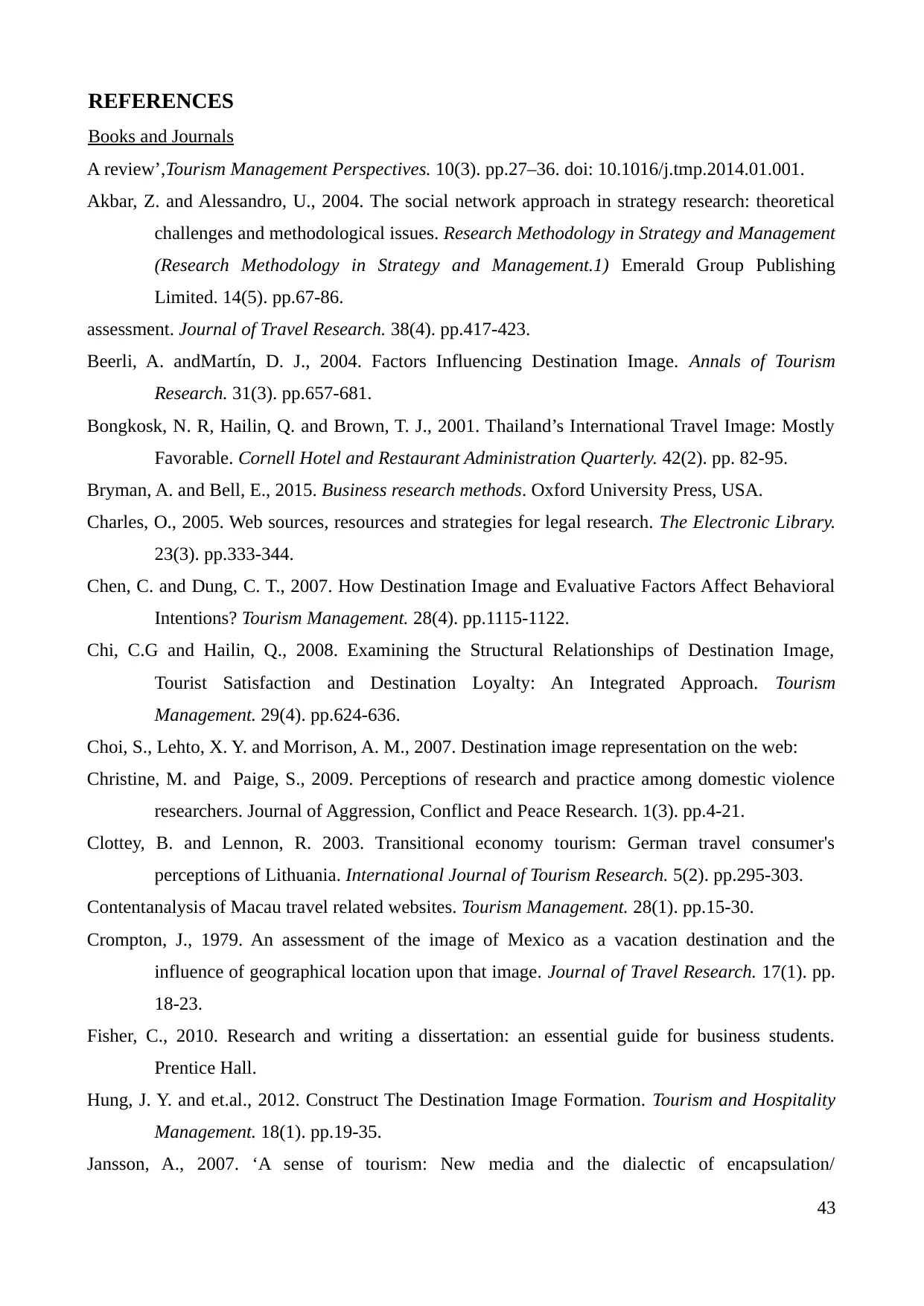
REFERENCES
Books and Journals
A review’,Tourism Management Perspectives. 10(3). pp.27–36. doi: 10.1016/j.tmp.2014.01.001.
Akbar, Z. and Alessandro, U., 2004. The social network approach in strategy research: theoretical
challenges and methodological issues. Research Methodology in Strategy and Management
(Research Methodology in Strategy and Management.1) Emerald Group Publishing
Limited. 14(5). pp.67-86.
assessment. Journal of Travel Research. 38(4). pp.417-423.
Beerli, A. andMartín, D. J., 2004. Factors Influencing Destination Image. Annals of Tourism
Research. 31(3). pp.657-681.
Bongkosk, N. R, Hailin, Q. and Brown, T. J., 2001. Thailand’s International Travel Image: Mostly
Favorable. Cornell Hotel and Restaurant Administration Quarterly. 42(2). pp. 82-95.
Bryman, A. and Bell, E., 2015. Business research methods. Oxford University Press, USA.
Charles, O., 2005. Web sources, resources and strategies for legal research. The Electronic Library.
23(3). pp.333-344.
Chen, C. and Dung, C. T., 2007. How Destination Image and Evaluative Factors Affect Behavioral
Intentions? Tourism Management. 28(4). pp.1115-1122.
Chi, C.G and Hailin, Q., 2008. Examining the Structural Relationships of Destination Image,
Tourist Satisfaction and Destination Loyalty: An Integrated Approach. Tourism
Management. 29(4). pp.624-636.
Choi, S., Lehto, X. Y. and Morrison, A. M., 2007. Destination image representation on the web:
Christine, M. and Paige, S., 2009. Perceptions of research and practice among domestic violence
researchers. Journal of Aggression, Conflict and Peace Research. 1(3). pp.4-21.
Clottey, B. and Lennon, R. 2003. Transitional economy tourism: German travel consumer's
perceptions of Lithuania. International Journal of Tourism Research. 5(2). pp.295-303.
Contentanalysis of Macau travel related websites. Tourism Management. 28(1). pp.15-30.
Crompton, J., 1979. An assessment of the image of Mexico as a vacation destination and the
influence of geographical location upon that image. Journal of Travel Research. 17(1). pp.
18-23.
Fisher, C., 2010. Research and writing a dissertation: an essential guide for business students.
Prentice Hall.
Hung, J. Y. and et.al., 2012. Construct The Destination Image Formation. Tourism and Hospitality
Management. 18(1). pp.19-35.
Jansson, A., 2007. ‘A sense of tourism: New media and the dialectic of encapsulation/
43
Books and Journals
A review’,Tourism Management Perspectives. 10(3). pp.27–36. doi: 10.1016/j.tmp.2014.01.001.
Akbar, Z. and Alessandro, U., 2004. The social network approach in strategy research: theoretical
challenges and methodological issues. Research Methodology in Strategy and Management
(Research Methodology in Strategy and Management.1) Emerald Group Publishing
Limited. 14(5). pp.67-86.
assessment. Journal of Travel Research. 38(4). pp.417-423.
Beerli, A. andMartín, D. J., 2004. Factors Influencing Destination Image. Annals of Tourism
Research. 31(3). pp.657-681.
Bongkosk, N. R, Hailin, Q. and Brown, T. J., 2001. Thailand’s International Travel Image: Mostly
Favorable. Cornell Hotel and Restaurant Administration Quarterly. 42(2). pp. 82-95.
Bryman, A. and Bell, E., 2015. Business research methods. Oxford University Press, USA.
Charles, O., 2005. Web sources, resources and strategies for legal research. The Electronic Library.
23(3). pp.333-344.
Chen, C. and Dung, C. T., 2007. How Destination Image and Evaluative Factors Affect Behavioral
Intentions? Tourism Management. 28(4). pp.1115-1122.
Chi, C.G and Hailin, Q., 2008. Examining the Structural Relationships of Destination Image,
Tourist Satisfaction and Destination Loyalty: An Integrated Approach. Tourism
Management. 29(4). pp.624-636.
Choi, S., Lehto, X. Y. and Morrison, A. M., 2007. Destination image representation on the web:
Christine, M. and Paige, S., 2009. Perceptions of research and practice among domestic violence
researchers. Journal of Aggression, Conflict and Peace Research. 1(3). pp.4-21.
Clottey, B. and Lennon, R. 2003. Transitional economy tourism: German travel consumer's
perceptions of Lithuania. International Journal of Tourism Research. 5(2). pp.295-303.
Contentanalysis of Macau travel related websites. Tourism Management. 28(1). pp.15-30.
Crompton, J., 1979. An assessment of the image of Mexico as a vacation destination and the
influence of geographical location upon that image. Journal of Travel Research. 17(1). pp.
18-23.
Fisher, C., 2010. Research and writing a dissertation: an essential guide for business students.
Prentice Hall.
Hung, J. Y. and et.al., 2012. Construct The Destination Image Formation. Tourism and Hospitality
Management. 18(1). pp.19-35.
Jansson, A., 2007. ‘A sense of tourism: New media and the dialectic of encapsulation/
43
Paraphrase This Document
Need a fresh take? Get an instant paraphrase of this document with our AI Paraphraser
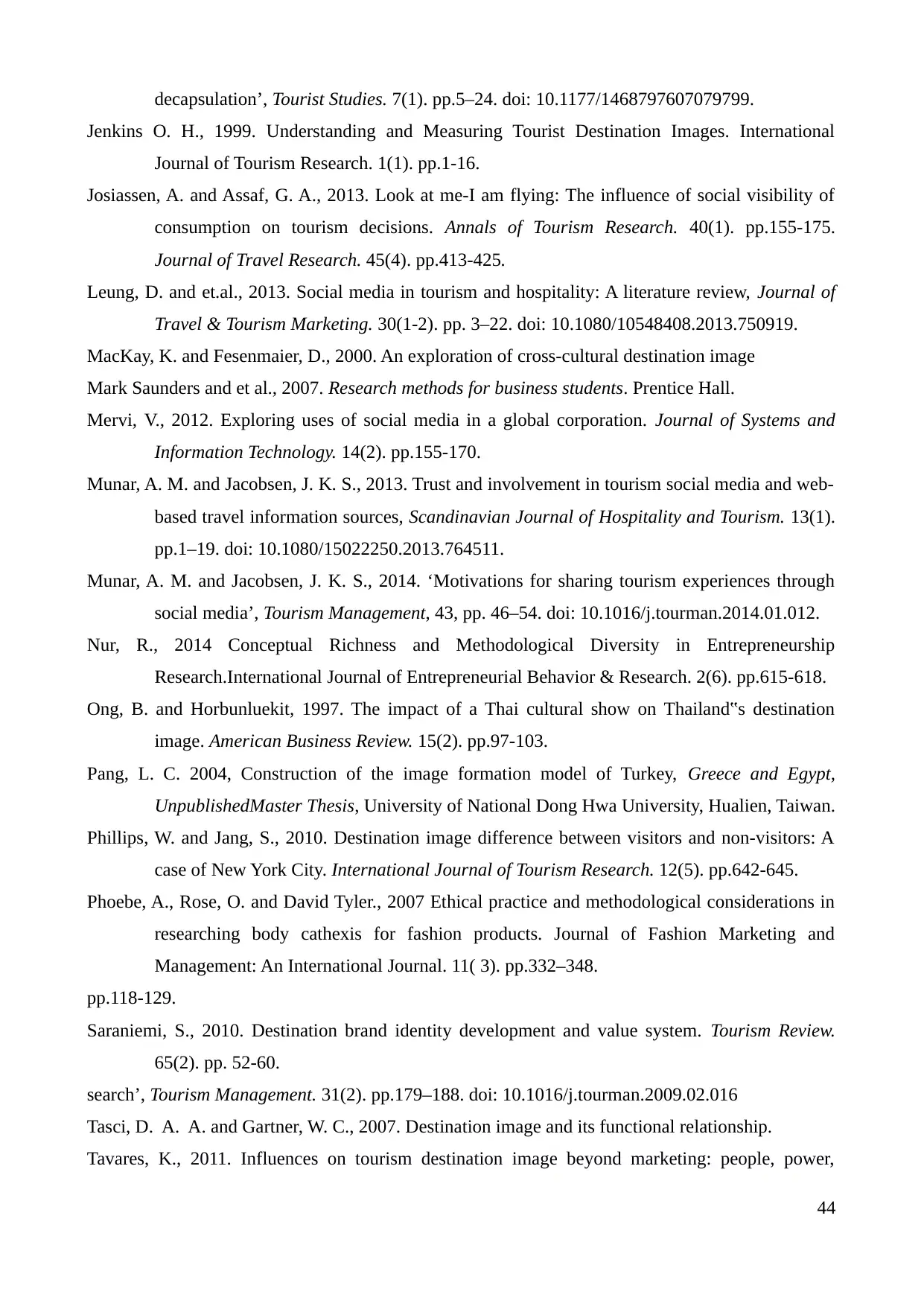
decapsulation’, Tourist Studies. 7(1). pp.5–24. doi: 10.1177/1468797607079799.
Jenkins O. H., 1999. Understanding and Measuring Tourist Destination Images. International
Journal of Tourism Research. 1(1). pp.1-16.
Josiassen, A. and Assaf, G. A., 2013. Look at me-I am flying: The influence of social visibility of
consumption on tourism decisions. Annals of Tourism Research. 40(1). pp.155-175.
Journal of Travel Research. 45(4). pp.413-425.
Leung, D. and et.al., 2013. Social media in tourism and hospitality: A literature review, Journal of
Travel & Tourism Marketing. 30(1-2). pp. 3–22. doi: 10.1080/10548408.2013.750919.
MacKay, K. and Fesenmaier, D., 2000. An exploration of cross-cultural destination image
Mark Saunders and et al., 2007. Research methods for business students. Prentice Hall.
Mervi, V., 2012. Exploring uses of social media in a global corporation. Journal of Systems and
Information Technology. 14(2). pp.155-170.
Munar, A. M. and Jacobsen, J. K. S., 2013. Trust and involvement in tourism social media and web-
based travel information sources, Scandinavian Journal of Hospitality and Tourism. 13(1).
pp.1–19. doi: 10.1080/15022250.2013.764511.
Munar, A. M. and Jacobsen, J. K. S., 2014. ‘Motivations for sharing tourism experiences through
social media’, Tourism Management, 43, pp. 46–54. doi: 10.1016/j.tourman.2014.01.012.
Nur, R., 2014 Conceptual Richness and Methodological Diversity in Entrepreneurship
Research.International Journal of Entrepreneurial Behavior & Research. 2(6). pp.615-618.
Ong, B. and Horbunluekit, 1997. The impact of a Thai cultural show on Thailand‟s destination
image. American Business Review. 15(2). pp.97-103.
Pang, L. C. 2004, Construction of the image formation model of Turkey, Greece and Egypt,
UnpublishedMaster Thesis, University of National Dong Hwa University, Hualien, Taiwan.
Phillips, W. and Jang, S., 2010. Destination image difference between visitors and non-visitors: A
case of New York City. International Journal of Tourism Research. 12(5). pp.642-645.
Phoebe, A., Rose, O. and David Tyler., 2007 Ethical practice and methodological considerations in
researching body cathexis for fashion products. Journal of Fashion Marketing and
Management: An International Journal. 11( 3). pp.332–348.
pp.118-129.
Saraniemi, S., 2010. Destination brand identity development and value system. Tourism Review.
65(2). pp. 52-60.
search’, Tourism Management. 31(2). pp.179–188. doi: 10.1016/j.tourman.2009.02.016
Tasci, D. A. A. and Gartner, W. C., 2007. Destination image and its functional relationship.
Tavares, K., 2011. Influences on tourism destination image beyond marketing: people, power,
44
Jenkins O. H., 1999. Understanding and Measuring Tourist Destination Images. International
Journal of Tourism Research. 1(1). pp.1-16.
Josiassen, A. and Assaf, G. A., 2013. Look at me-I am flying: The influence of social visibility of
consumption on tourism decisions. Annals of Tourism Research. 40(1). pp.155-175.
Journal of Travel Research. 45(4). pp.413-425.
Leung, D. and et.al., 2013. Social media in tourism and hospitality: A literature review, Journal of
Travel & Tourism Marketing. 30(1-2). pp. 3–22. doi: 10.1080/10548408.2013.750919.
MacKay, K. and Fesenmaier, D., 2000. An exploration of cross-cultural destination image
Mark Saunders and et al., 2007. Research methods for business students. Prentice Hall.
Mervi, V., 2012. Exploring uses of social media in a global corporation. Journal of Systems and
Information Technology. 14(2). pp.155-170.
Munar, A. M. and Jacobsen, J. K. S., 2013. Trust and involvement in tourism social media and web-
based travel information sources, Scandinavian Journal of Hospitality and Tourism. 13(1).
pp.1–19. doi: 10.1080/15022250.2013.764511.
Munar, A. M. and Jacobsen, J. K. S., 2014. ‘Motivations for sharing tourism experiences through
social media’, Tourism Management, 43, pp. 46–54. doi: 10.1016/j.tourman.2014.01.012.
Nur, R., 2014 Conceptual Richness and Methodological Diversity in Entrepreneurship
Research.International Journal of Entrepreneurial Behavior & Research. 2(6). pp.615-618.
Ong, B. and Horbunluekit, 1997. The impact of a Thai cultural show on Thailand‟s destination
image. American Business Review. 15(2). pp.97-103.
Pang, L. C. 2004, Construction of the image formation model of Turkey, Greece and Egypt,
UnpublishedMaster Thesis, University of National Dong Hwa University, Hualien, Taiwan.
Phillips, W. and Jang, S., 2010. Destination image difference between visitors and non-visitors: A
case of New York City. International Journal of Tourism Research. 12(5). pp.642-645.
Phoebe, A., Rose, O. and David Tyler., 2007 Ethical practice and methodological considerations in
researching body cathexis for fashion products. Journal of Fashion Marketing and
Management: An International Journal. 11( 3). pp.332–348.
pp.118-129.
Saraniemi, S., 2010. Destination brand identity development and value system. Tourism Review.
65(2). pp. 52-60.
search’, Tourism Management. 31(2). pp.179–188. doi: 10.1016/j.tourman.2009.02.016
Tasci, D. A. A. and Gartner, W. C., 2007. Destination image and its functional relationship.
Tavares, K., 2011. Influences on tourism destination image beyond marketing: people, power,
44
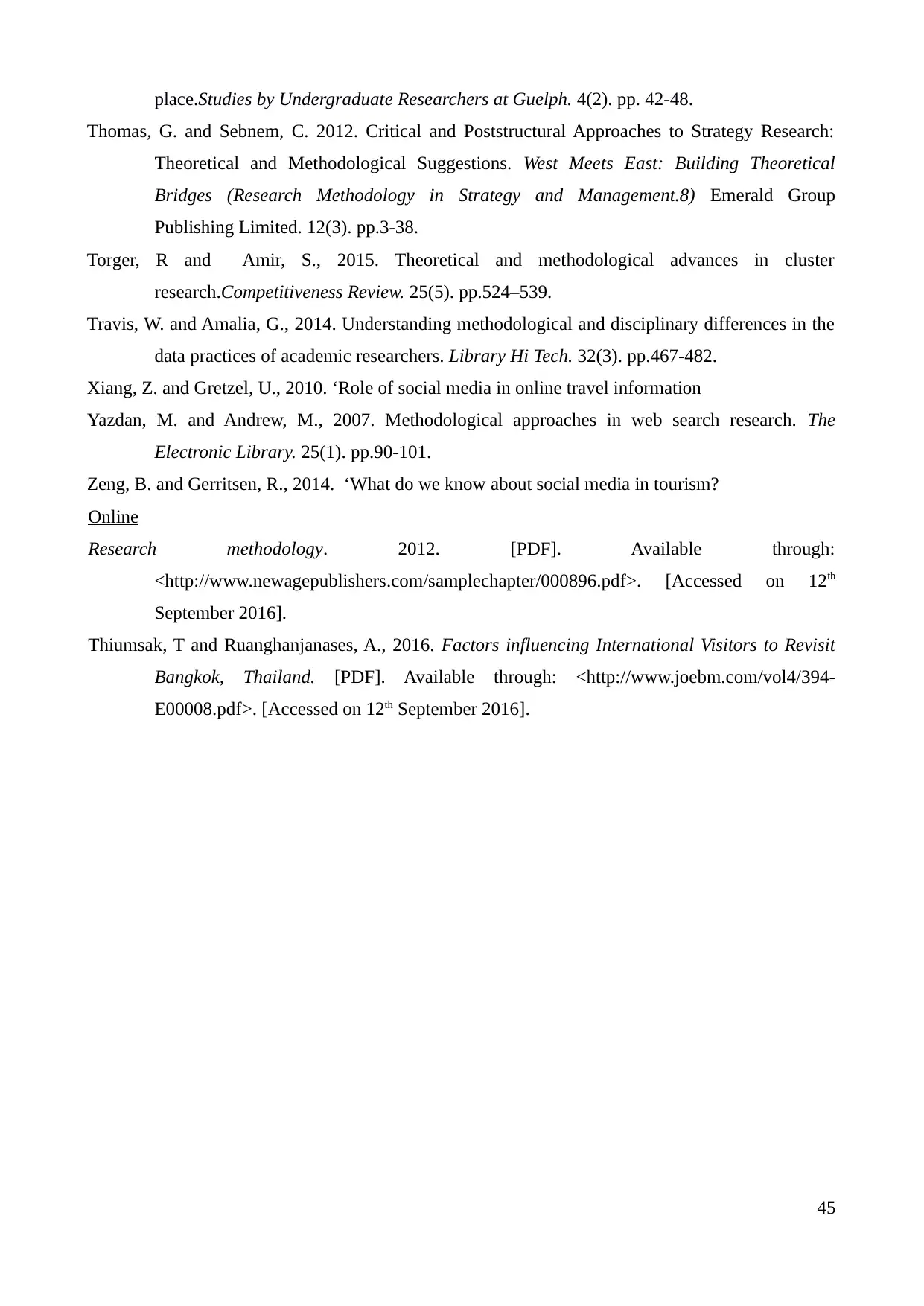
place.Studies by Undergraduate Researchers at Guelph. 4(2). pp. 42-48.
Thomas, G. and Sebnem, C. 2012. Critical and Poststructural Approaches to Strategy Research:
Theoretical and Methodological Suggestions. West Meets East: Building Theoretical
Bridges (Research Methodology in Strategy and Management.8) Emerald Group
Publishing Limited. 12(3). pp.3-38.
Torger, R and Amir, S., 2015. Theoretical and methodological advances in cluster
research.Competitiveness Review. 25(5). pp.524–539.
Travis, W. and Amalia, G., 2014. Understanding methodological and disciplinary differences in the
data practices of academic researchers. Library Hi Tech. 32(3). pp.467-482.
Xiang, Z. and Gretzel, U., 2010. ‘Role of social media in online travel information
Yazdan, M. and Andrew, M., 2007. Methodological approaches in web search research. The
Electronic Library. 25(1). pp.90-101.
Zeng, B. and Gerritsen, R., 2014. ‘What do we know about social media in tourism?
Online
Research methodology. 2012. [PDF]. Available through:
<http://www.newagepublishers.com/samplechapter/000896.pdf>. [Accessed on 12th
September 2016].
Thiumsak, T and Ruanghanjanases, A., 2016. Factors influencing International Visitors to Revisit
Bangkok, Thailand. [PDF]. Available through: <http://www.joebm.com/vol4/394-
E00008.pdf>. [Accessed on 12th September 2016].
45
Thomas, G. and Sebnem, C. 2012. Critical and Poststructural Approaches to Strategy Research:
Theoretical and Methodological Suggestions. West Meets East: Building Theoretical
Bridges (Research Methodology in Strategy and Management.8) Emerald Group
Publishing Limited. 12(3). pp.3-38.
Torger, R and Amir, S., 2015. Theoretical and methodological advances in cluster
research.Competitiveness Review. 25(5). pp.524–539.
Travis, W. and Amalia, G., 2014. Understanding methodological and disciplinary differences in the
data practices of academic researchers. Library Hi Tech. 32(3). pp.467-482.
Xiang, Z. and Gretzel, U., 2010. ‘Role of social media in online travel information
Yazdan, M. and Andrew, M., 2007. Methodological approaches in web search research. The
Electronic Library. 25(1). pp.90-101.
Zeng, B. and Gerritsen, R., 2014. ‘What do we know about social media in tourism?
Online
Research methodology. 2012. [PDF]. Available through:
<http://www.newagepublishers.com/samplechapter/000896.pdf>. [Accessed on 12th
September 2016].
Thiumsak, T and Ruanghanjanases, A., 2016. Factors influencing International Visitors to Revisit
Bangkok, Thailand. [PDF]. Available through: <http://www.joebm.com/vol4/394-
E00008.pdf>. [Accessed on 12th September 2016].
45

46
Secure Best Marks with AI Grader
Need help grading? Try our AI Grader for instant feedback on your assignments.
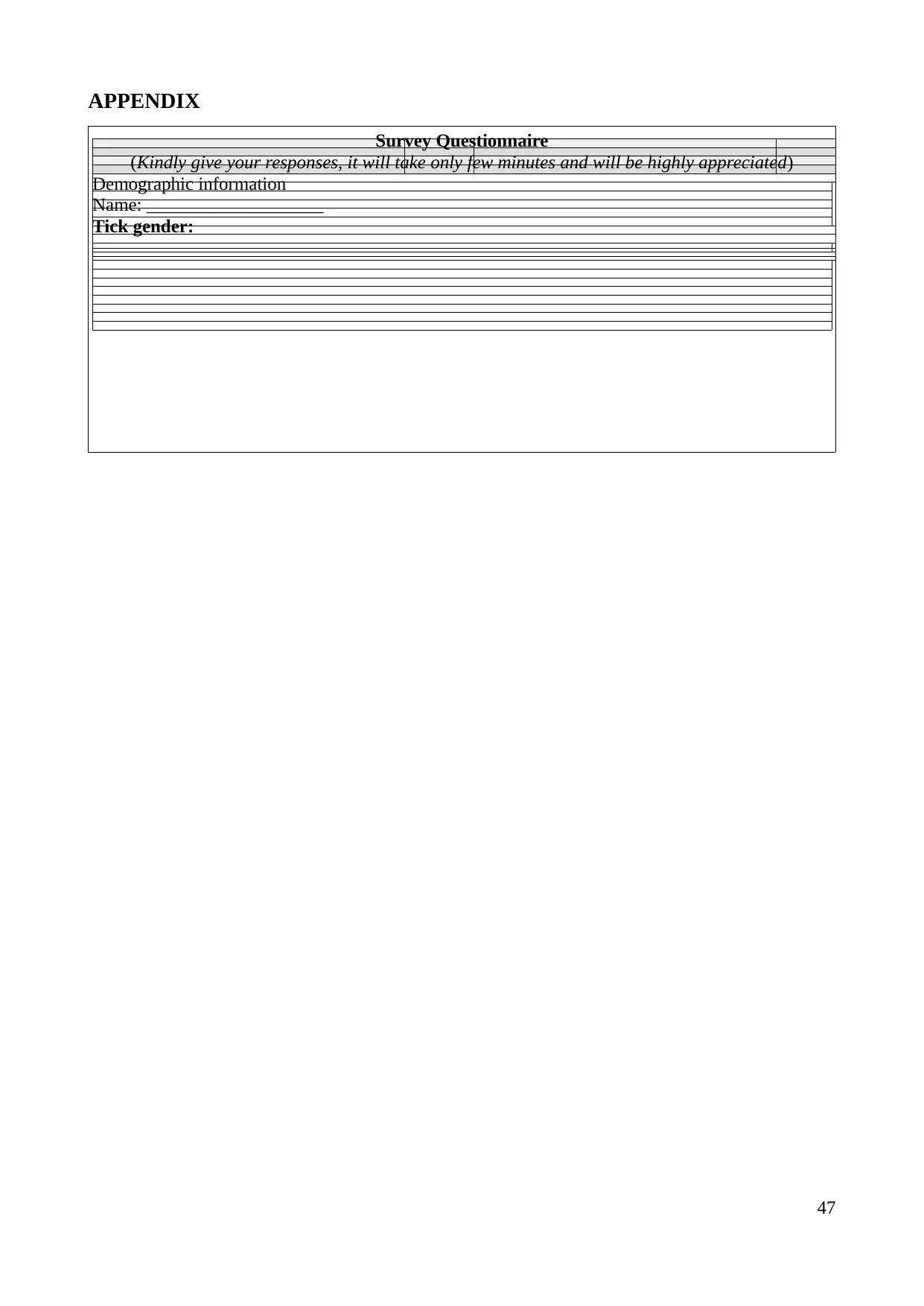
APPENDIX
Survey Questionnaire
(Kindly give your responses, it will take only few minutes and will be highly appreciated)
Demographic information
Name: ___________________
Tick gender:
47
Survey Questionnaire
(Kindly give your responses, it will take only few minutes and will be highly appreciated)
Demographic information
Name: ___________________
Tick gender:
47
1 out of 47
Related Documents
Your All-in-One AI-Powered Toolkit for Academic Success.
+13062052269
info@desklib.com
Available 24*7 on WhatsApp / Email
![[object Object]](/_next/static/media/star-bottom.7253800d.svg)
Unlock your academic potential
© 2024 | Zucol Services PVT LTD | All rights reserved.





